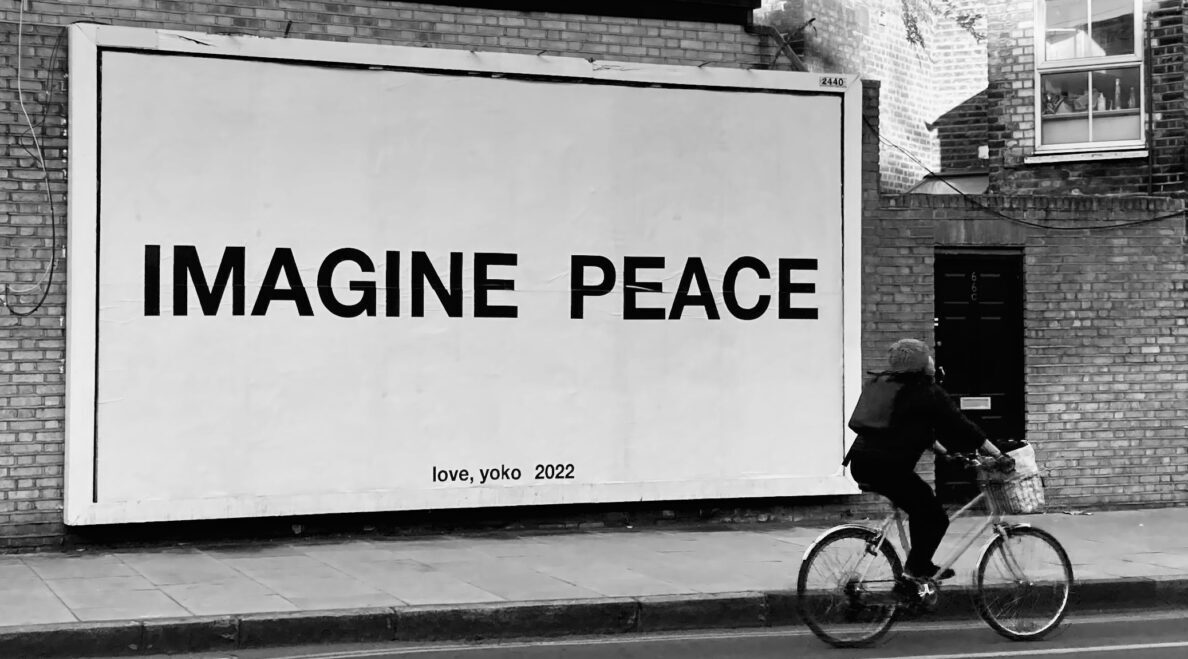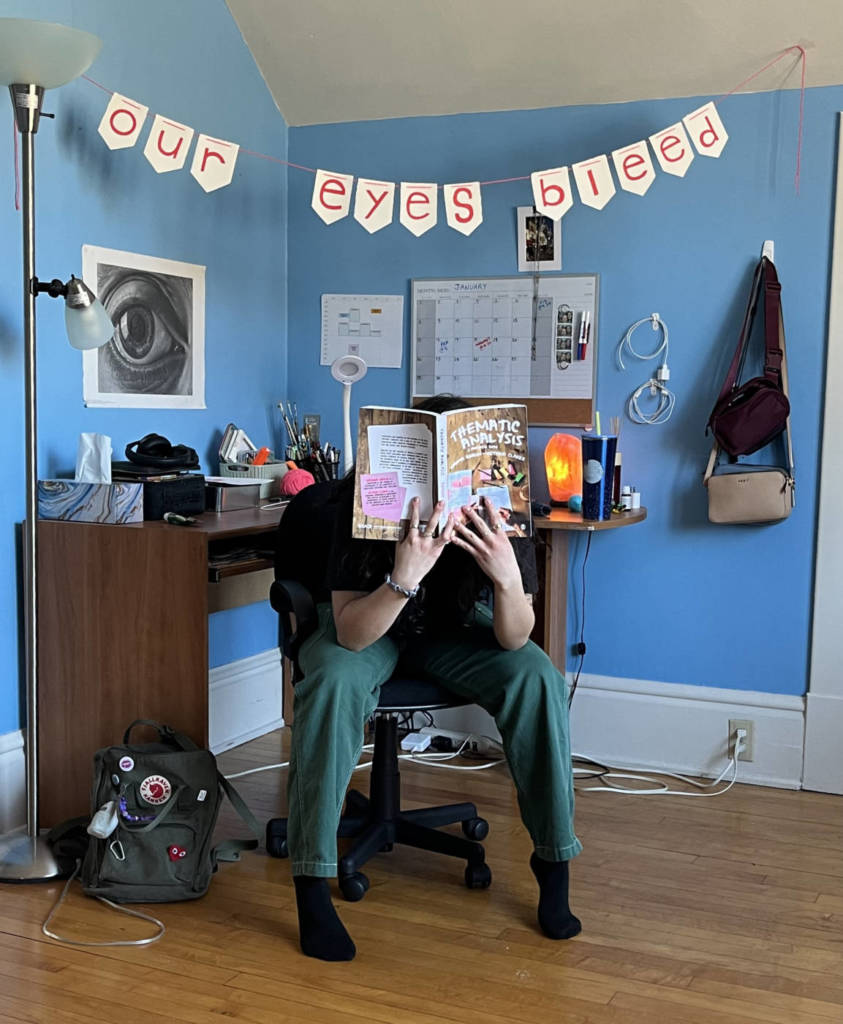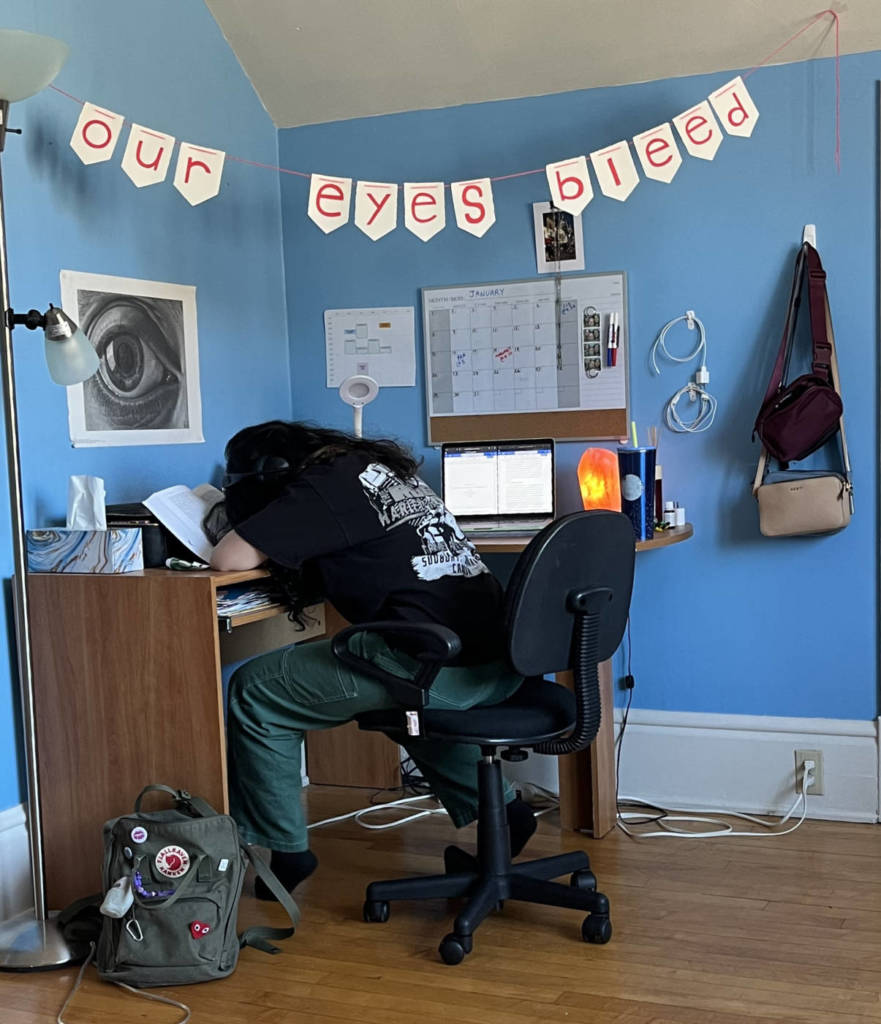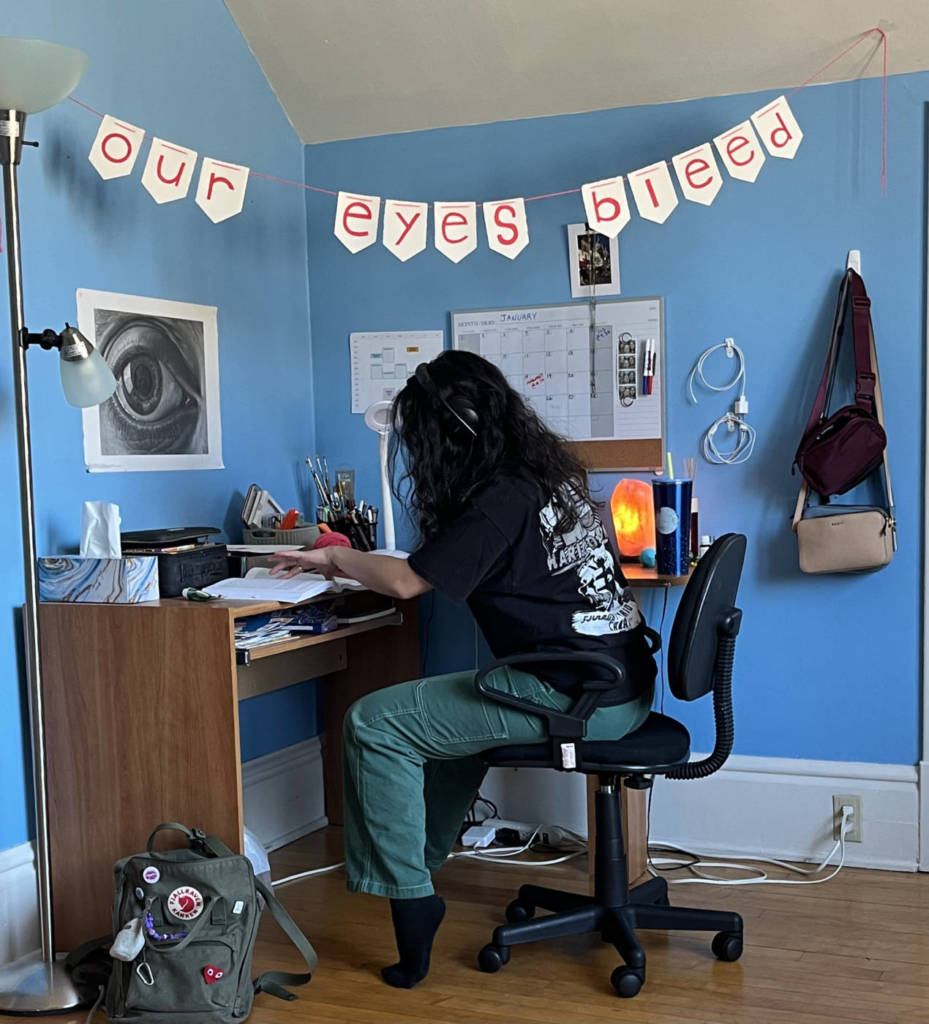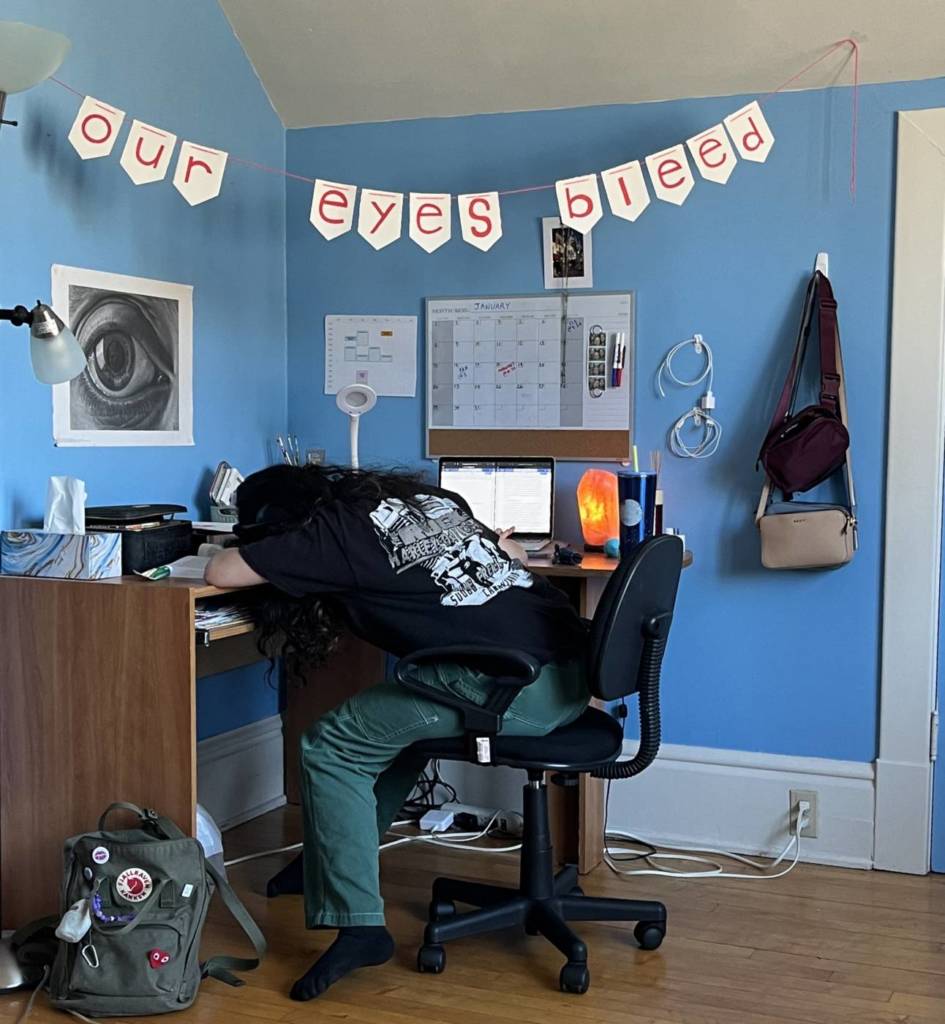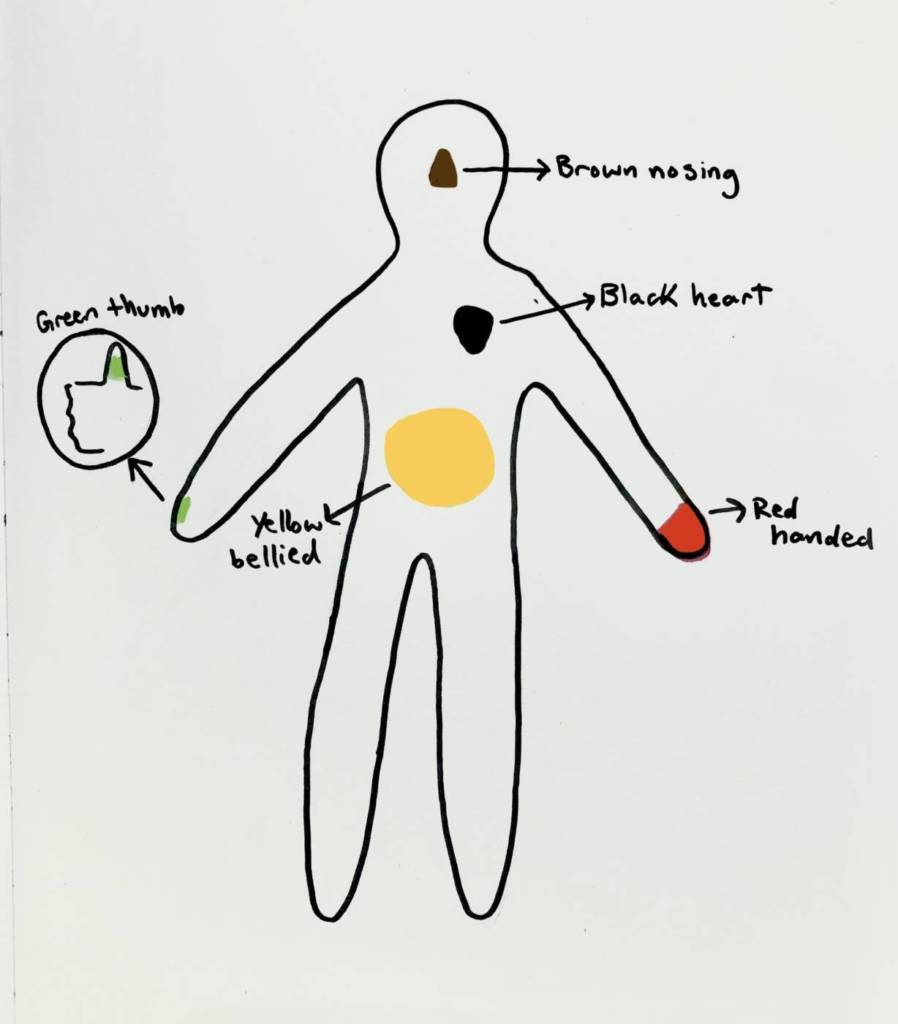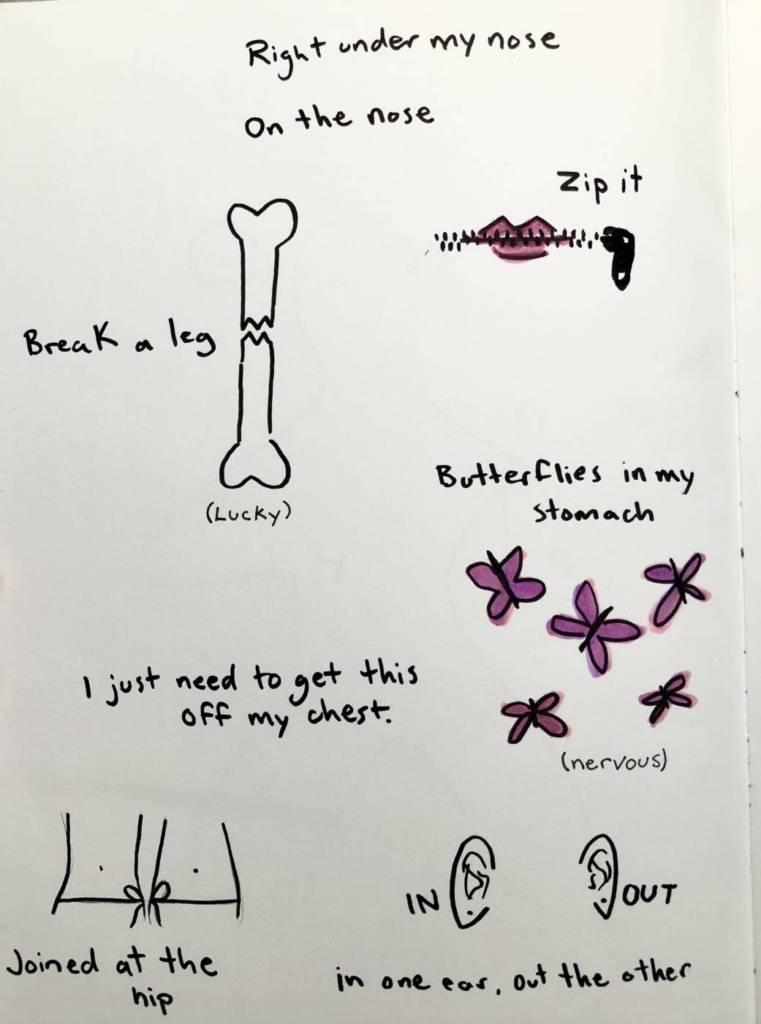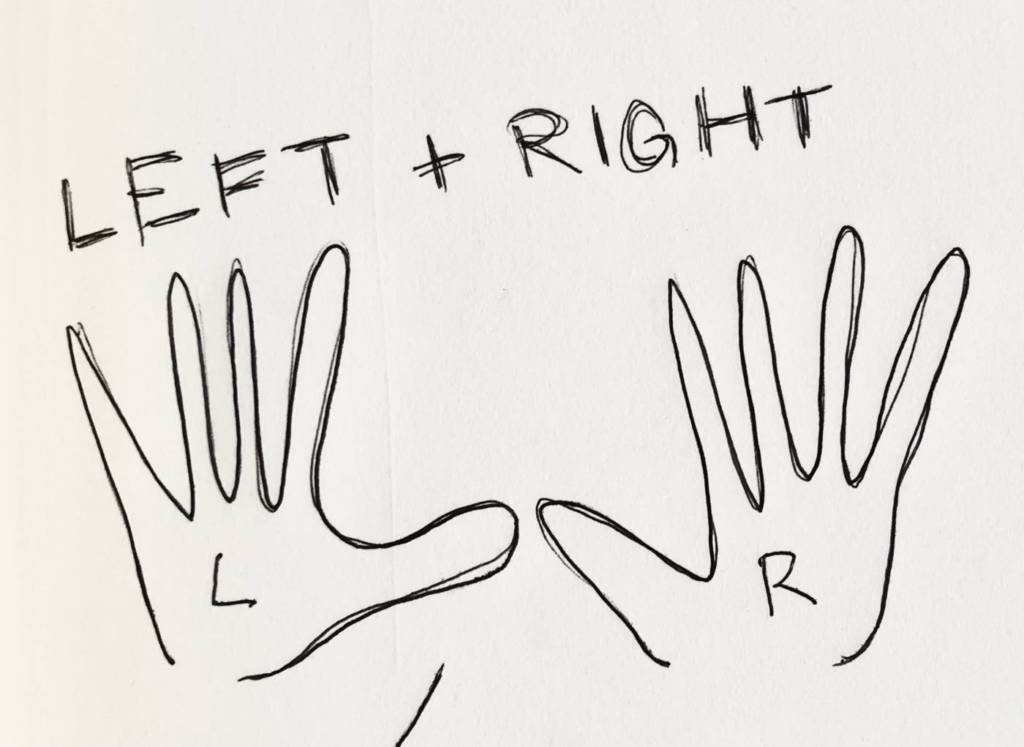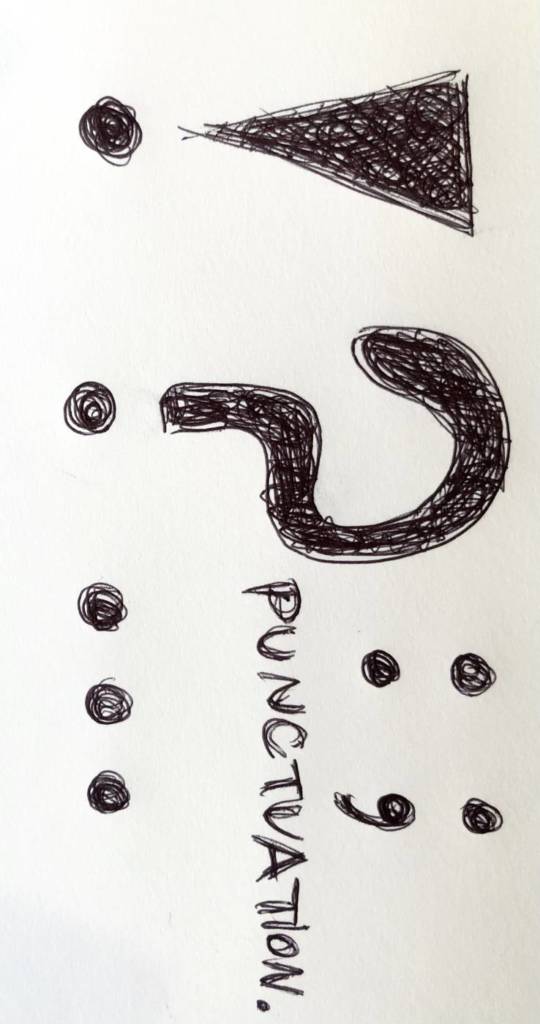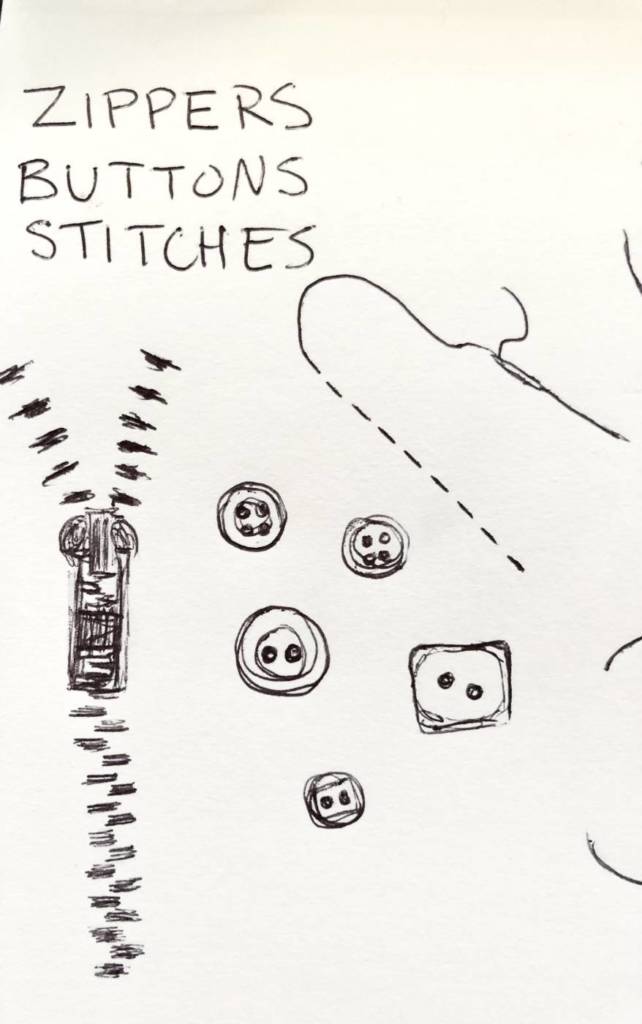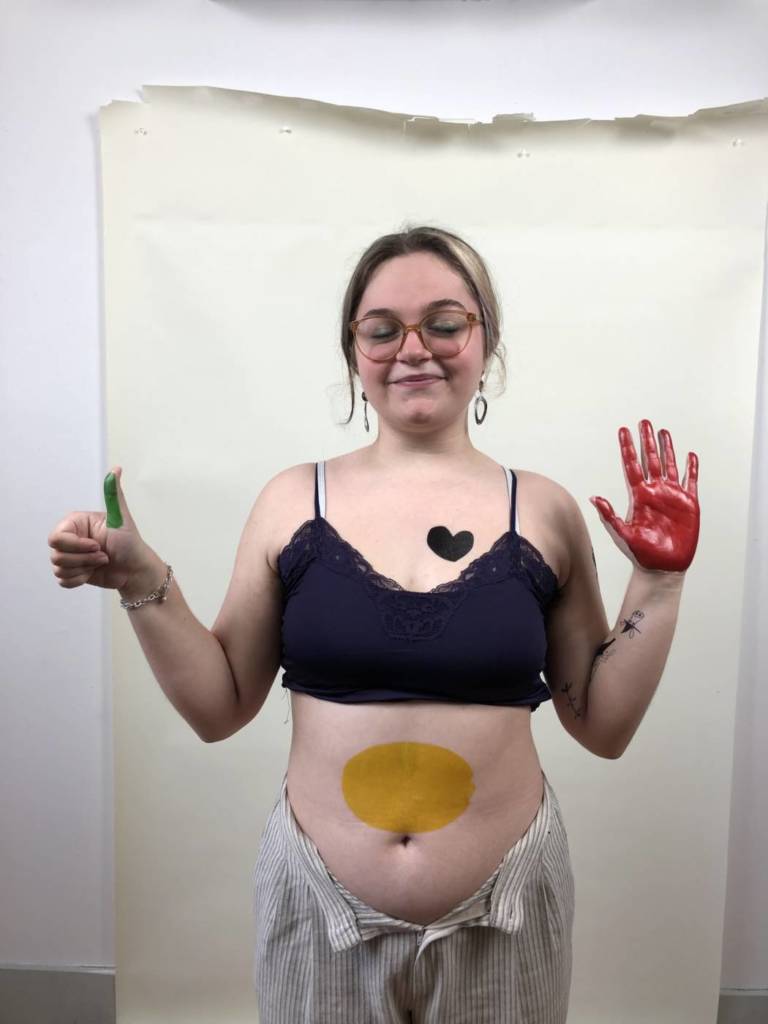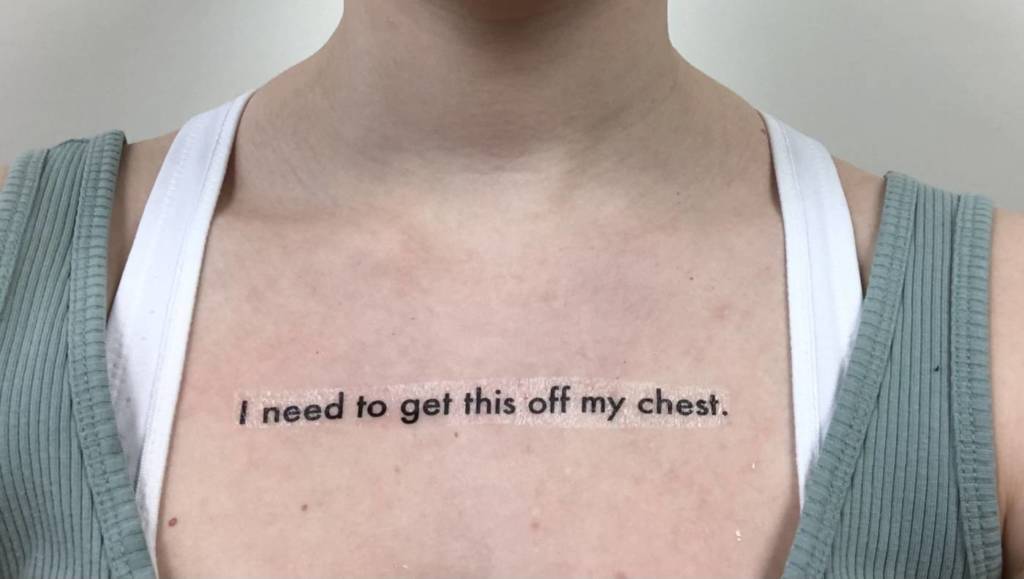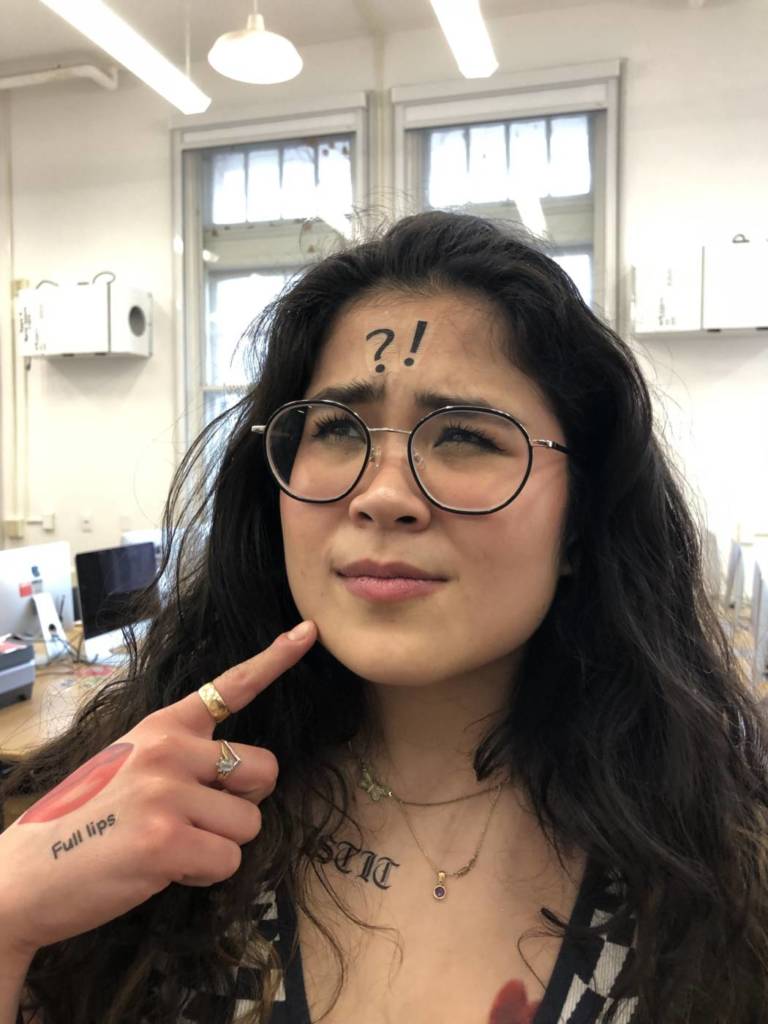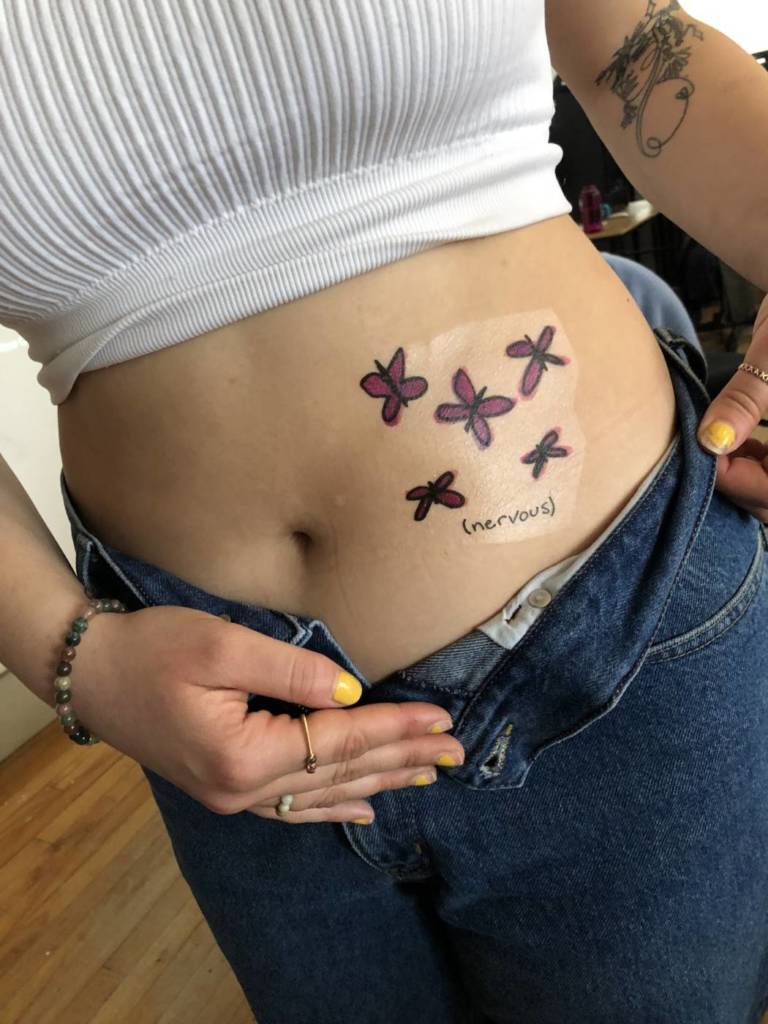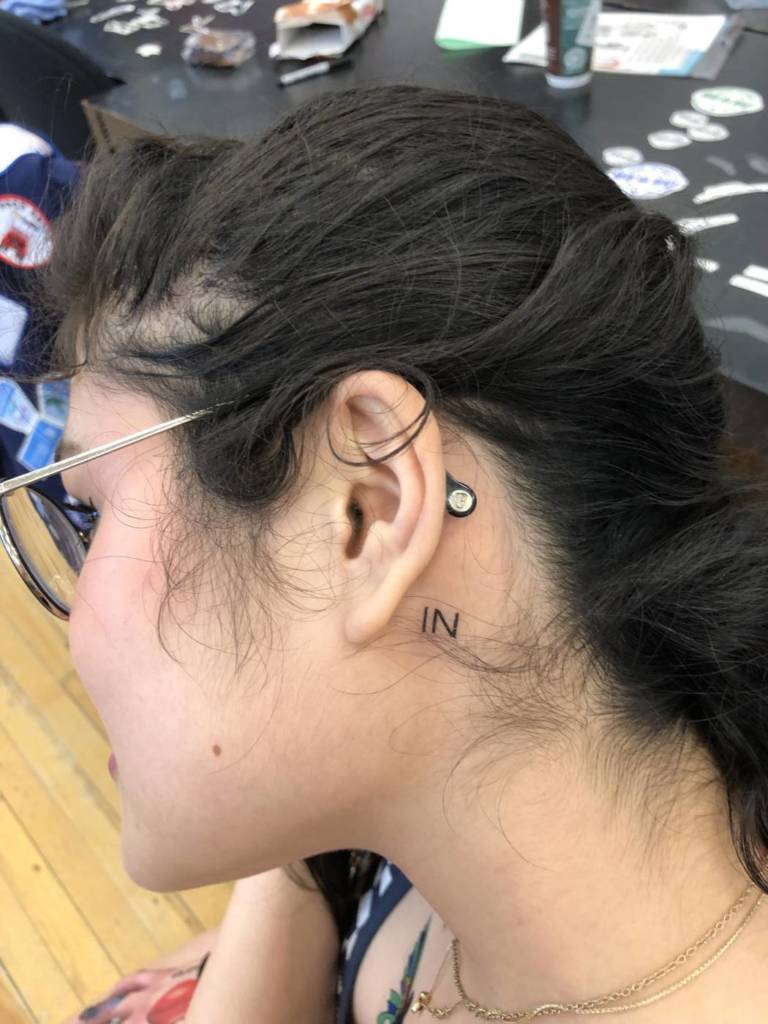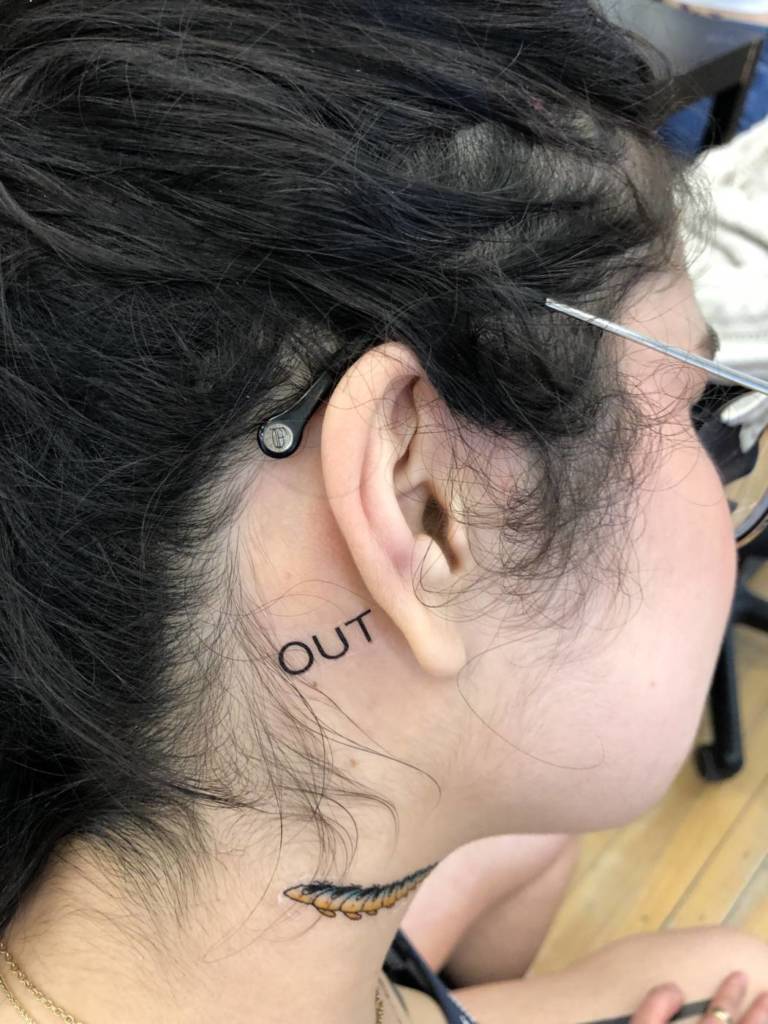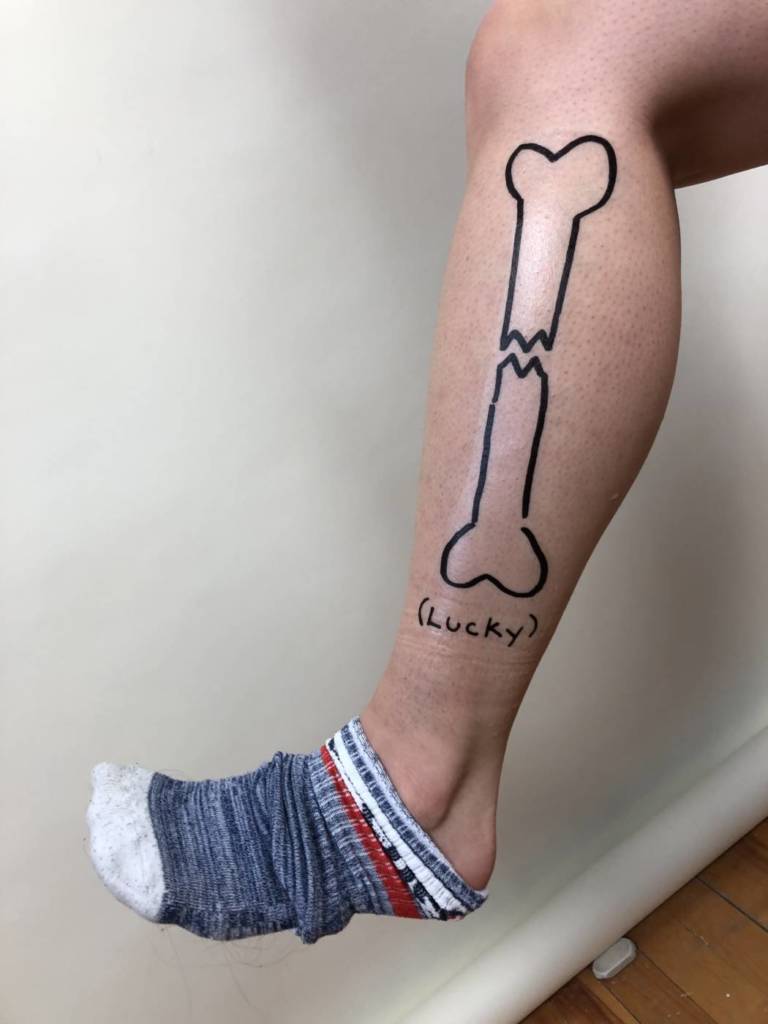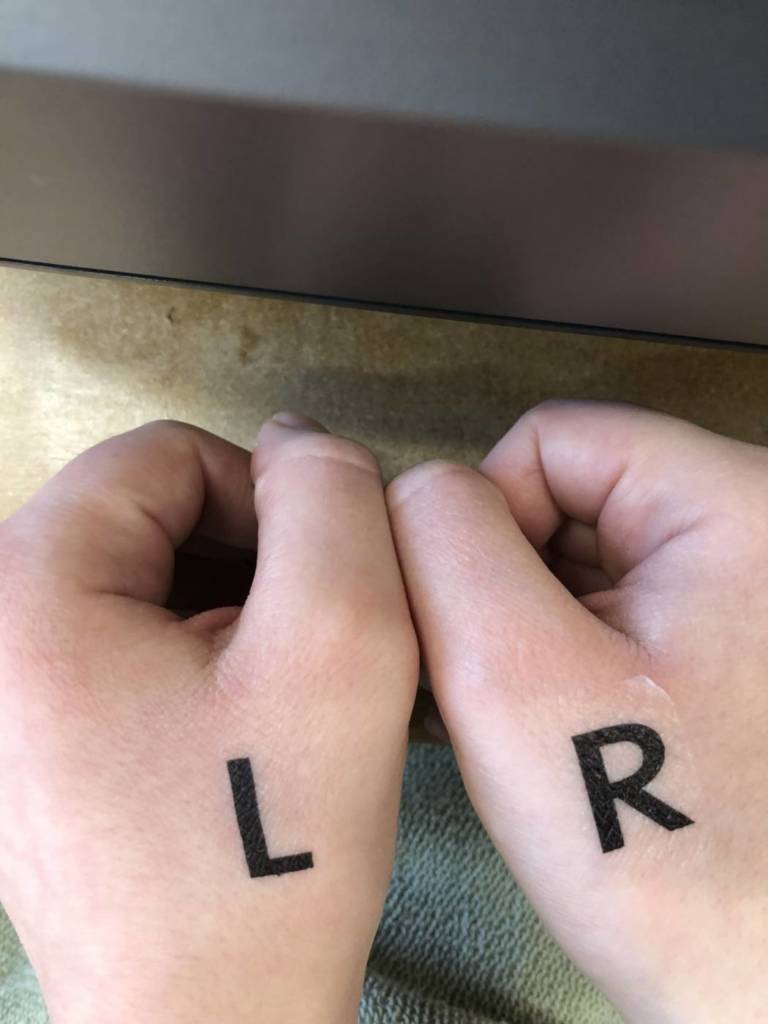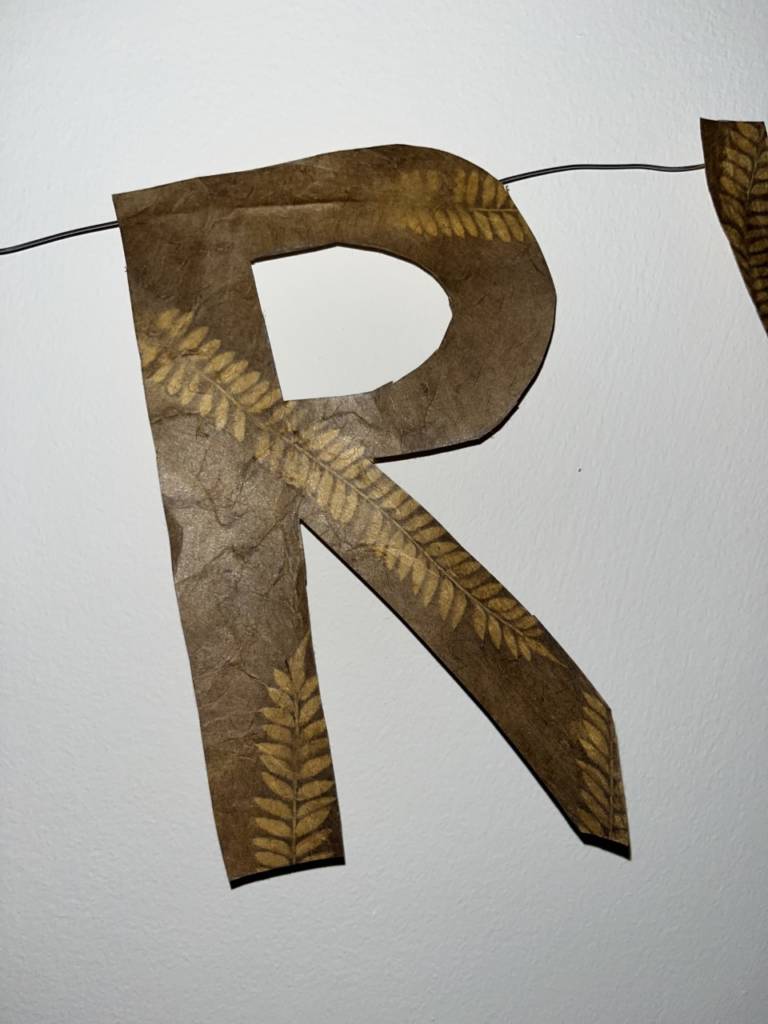Zoe
Grapefruit by Yoko Ono
Presented by Zoe Dougherty
Yoko Ono: A Portrait
Yoko Ono is a performance based activism artist, whose work is based in mischievous and humorous nature while addressing issues involving real world topics ranging from war to the public perception of art as a whole. Her art garnered attention from avant-garde art movements, such as the Fluxus movement, and even beloved member of The Beatles John Lennon, whom she later married in 1969.
Grapefruit
Ono’s piece titled Grapefruit, published in 1964, is a small instruction manual with small tasks for the reader to accomplish either on their own or with two or more people, varying in levels of different realities. The reader is urged to use their imagination for each task in order to complete it, these tasks themselves are crafted to be performance-esque in both real life and one’s imagination. Grapefruit probes the human mind by nudging what we know a bit further, such as one of Ono’s true or false questions in this book, “The sixth finger is usually not used because its existence is not physically perceivable”. This is an obvious statement as there is no sixth finger on a singular five finger hand, however its imaginative existence is acknowledged and is therefore given the readers permission to be a part of the mindful artistic work that they create. This is performance art in the sense that the artist is not performing, but the viewer is performing. Whether the viewer seeks to make these tasks a reality, it will simply be a step further as they already have made a successful artwork simply by applying their creativity and imagination.
Bloody Banner
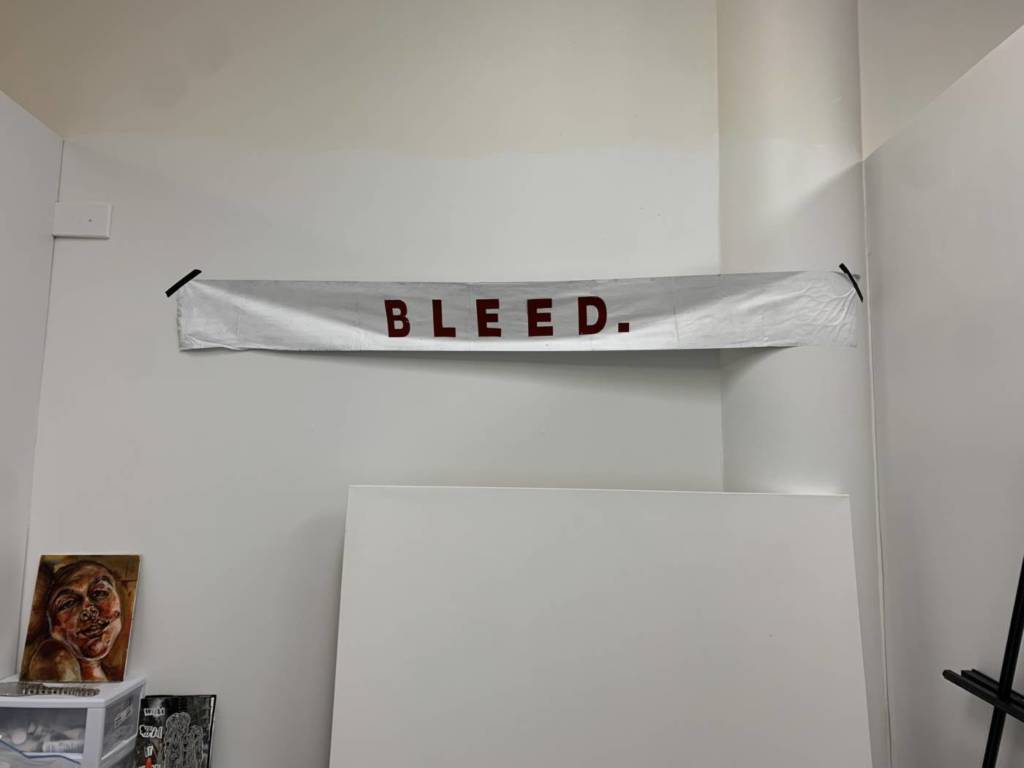
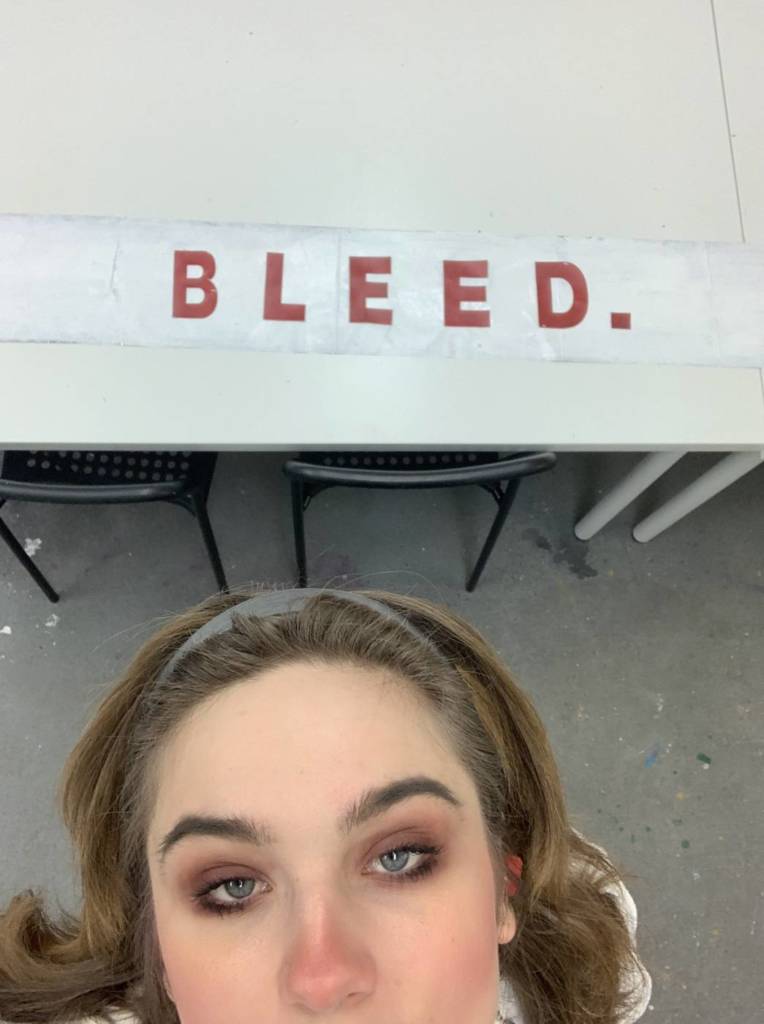
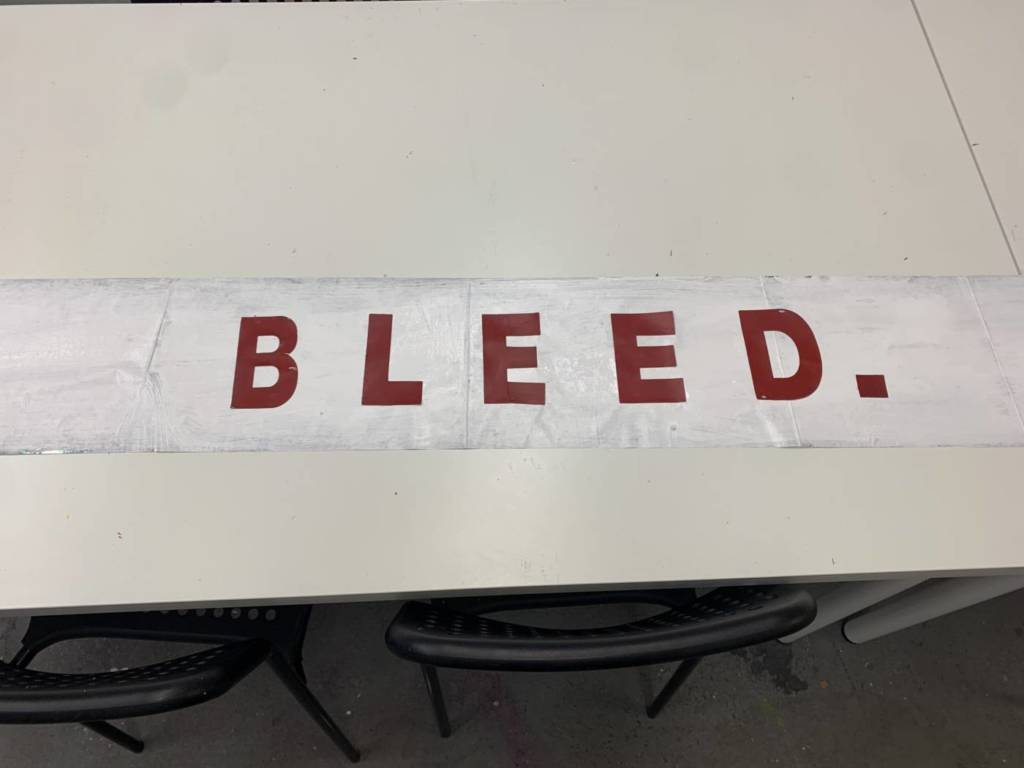
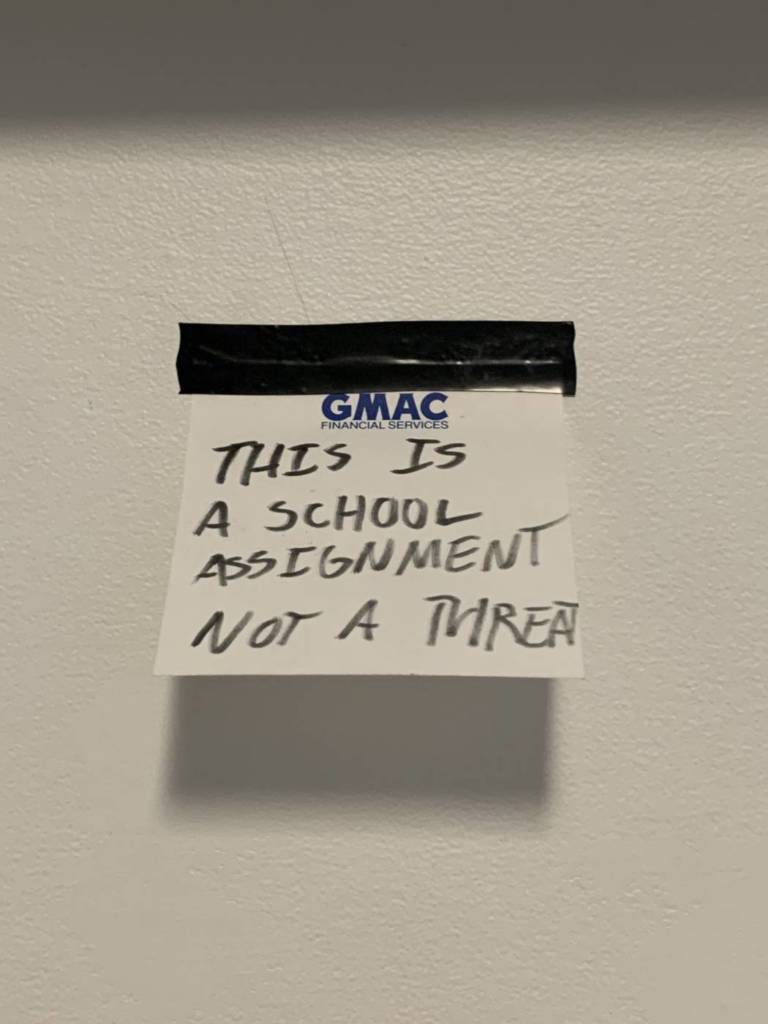
This banner was derived from the article Dirty Words: Interesting, more specifically the term “…eyes bleed.” The specificity of eyes bleeding felt very frightening, as it threatens one of our vulnerable senses. Blood in general is a sensitive substance and the act of using that word in a phrase evokes feelings of vulnerability, as it is a source of life. Bleeding for something is meant to represent sacrifice in the highest degree with your body, giving yourself in every possible way.
The goal in this banner was to threaten, command, motivate, and/or weaken the viewer by giving them a bold and blunt request. It urges the viewer to look into their own vulnerability, dreams, and desires with what could start and end it all, the act of bleeding.
Post-Internet: The Uncanny Valley
Having unsolicited access to the internet could be one of the most dangerous aspects of a child’s development, the trauma that can be caused with one mere image is a terrifying thought. Unfortunately, I was not so lucky to avoid such media, one of the core roots of fear I feel comes from images or perceptions of people that look human but are just a little bit off. This is known as the “Uncanny Valley”, in which something will have features of a person but as a human ourselves, we cannot accept it to genuinely be a human like us.


The faces above are examples of this phenomena spread out across the internet, they have features of a human but there is either an exaggeration or some small misplacement that makes the human appearance inhuman. They have been taken from either mugshots, sketches, androids, or dreams, to further explain, there is a graph that describes the Uncanny Valley in a visual context.
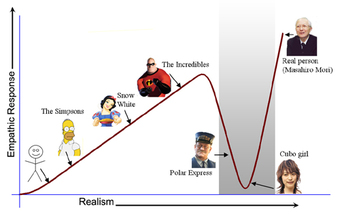
Uncanny Video
The video above provides various clips plucked from Youtube that show human connection to robots. I wanted to capture the sentimentality of human connection in contrast with the soulessness of the cold androids. The compilation is meant to show how we, as humans, can’t help but have that draw to keep pushing the limits of technology, to the point where we play God and try to recreate it, essentially becoming parents to A.I.
The video was extremely LoFi, so combined with the uncanny valley imagery of the Androids and the nurturing and loving touches and gazes of the humans there is a small terrifying feeling of longing for man-made connection that we may never achieve and yet try so hard to create.
This video contains a series of clips with Nancy Dougherty (my mother) simply existing during her morning routine. You will notice that Nancy rarely leaves the corner of the couch or the side of the table during her morning coffee and breakfast, establishing an unconscious routine. Within the confines of this ritual, small sparks of Nancy’s personality shine through the mundane. This includes loud booming laughter, random exclamations (“Oh my god” after taking a sip of coffee), and picking food off of her shirt to eat. Although there could be more clips included, what is shown is an intimate look at an everyday lifestyle romanticized by the quirks of a loved one.
Tattoo Party (Royal Family in the modern day)
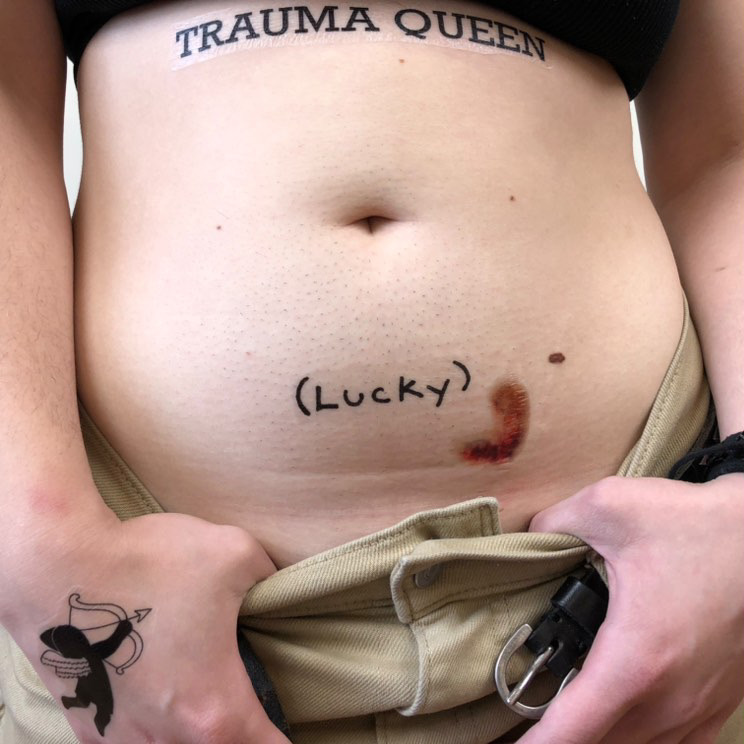
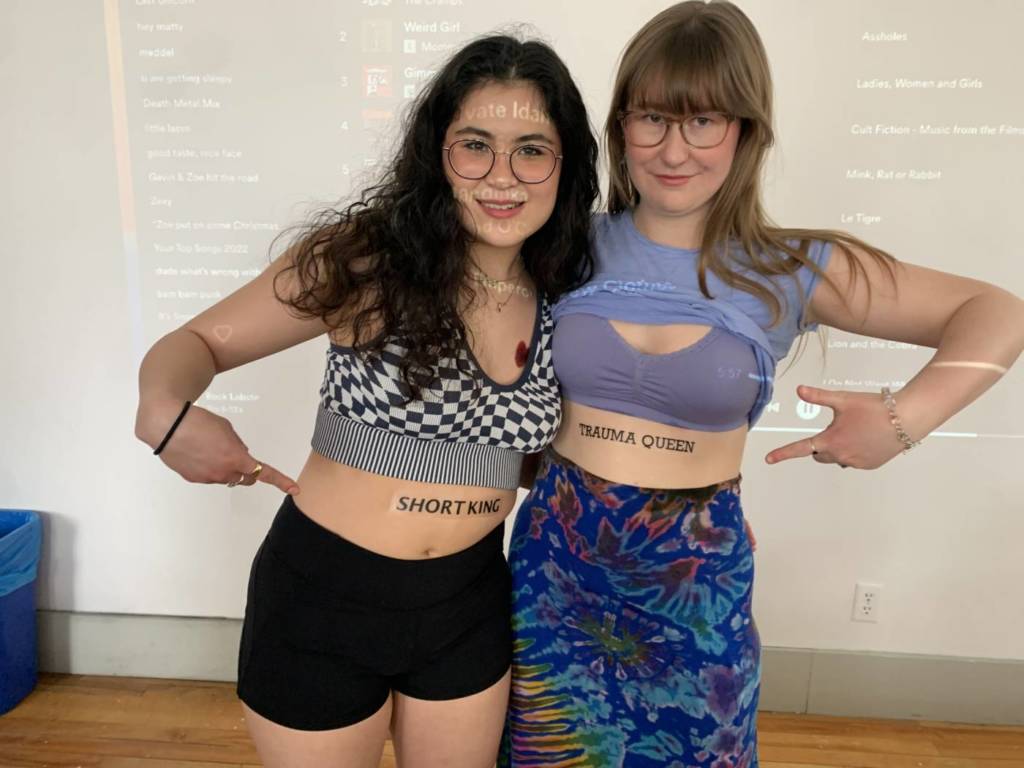
Tattoos are a wonderful way to express one’s self, art on the body is precious and vibrant. I was interested in the idea of text on the body with current day slang associated with royalty. The terms I chose were “Short King”, which a man would be called if he were fairly short compared to the societal norm of a 6ft person. “Trauma Queen”, which is a play on words of “drama queen” but emphasizing the acknowledged trauma of our current generation. Finally, “Passenger Princess”, which is the title of a person who often rides in the passenger seat of a car while someone else drives rather than driving the car themselves. These terms provide a sense of humour and have the bearer of the tattoo control its power. Whether the terms be demeaning or empowering, they make the owner royalty.
Chloe
April. 5 – Tattoo Party!!!
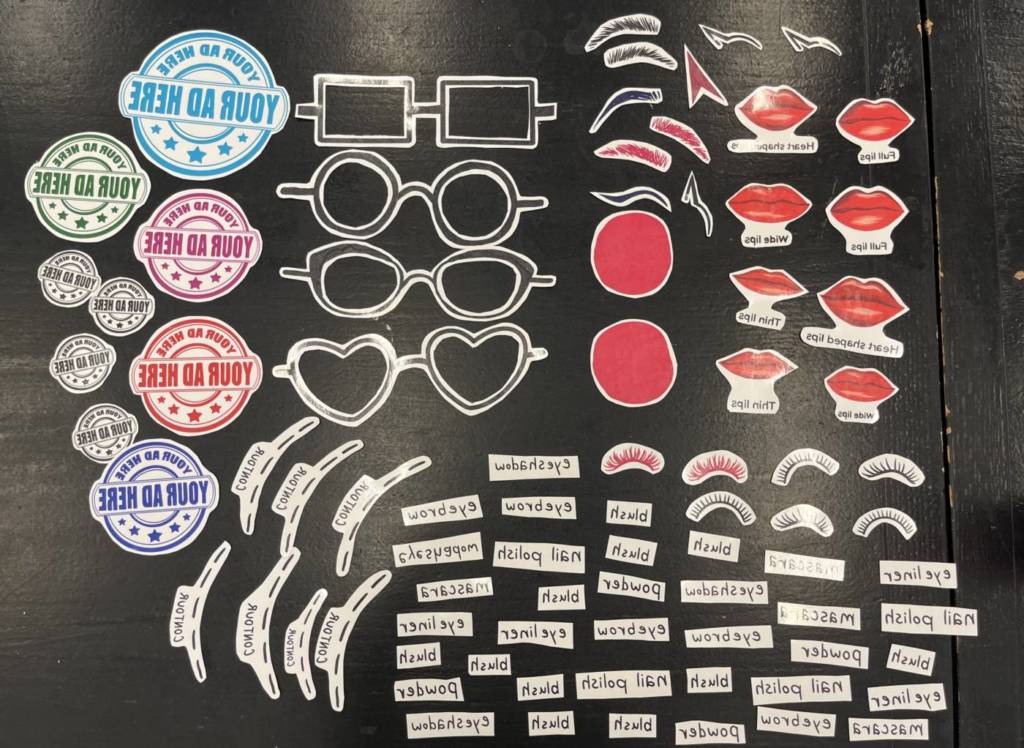
Tattoo Makeup
Thank you Alexia for being so willing to model these face tats as my living doll. Her face is complete with eyebrows, blush, contour, eyelashes, glasses, and of course some big juicy lips!








More Photos!






March. 29 – Tattoo Proposals
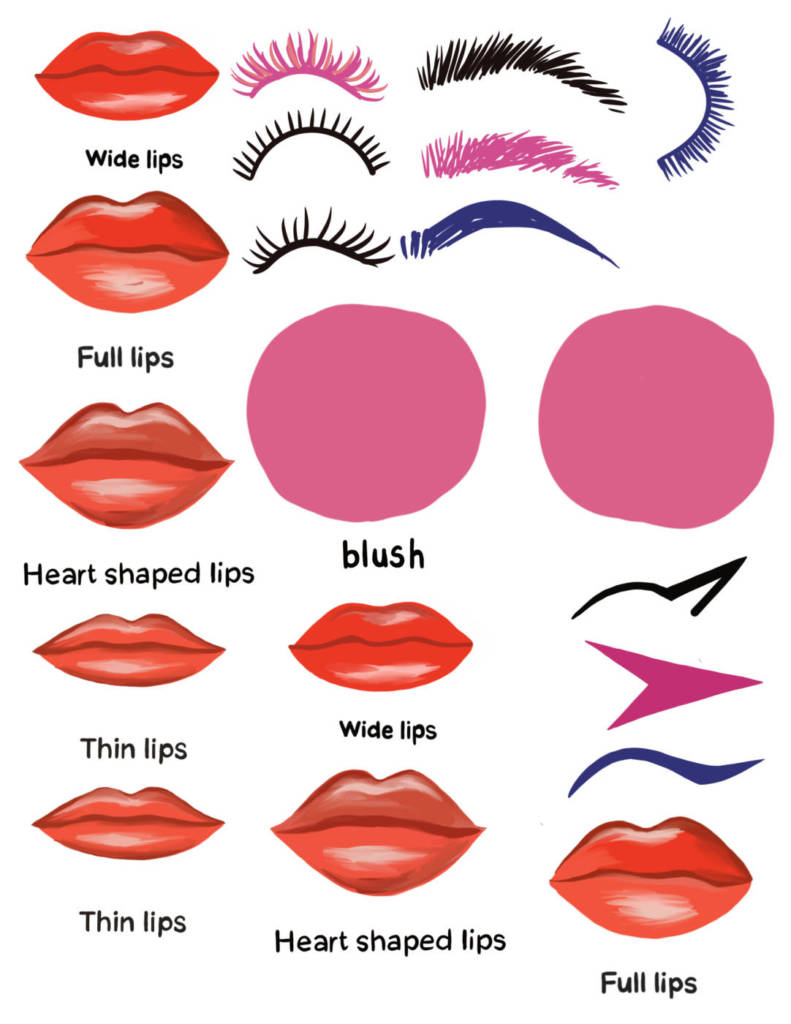
Permanent makeup is a type of tattooing where people get their daily makeup permanently added to their face so they never have to worry about getting ready again! I wanted to play with this idea of permanent makeup, as it shows how pervasive beauty standards are in our society. Women in particular often feel immense pressure to always look their best, and it involves an array of products and time. So wouldn’t it be much easier if we could just stick a temporary tattoo of our daily eyeliner on and be on our way?
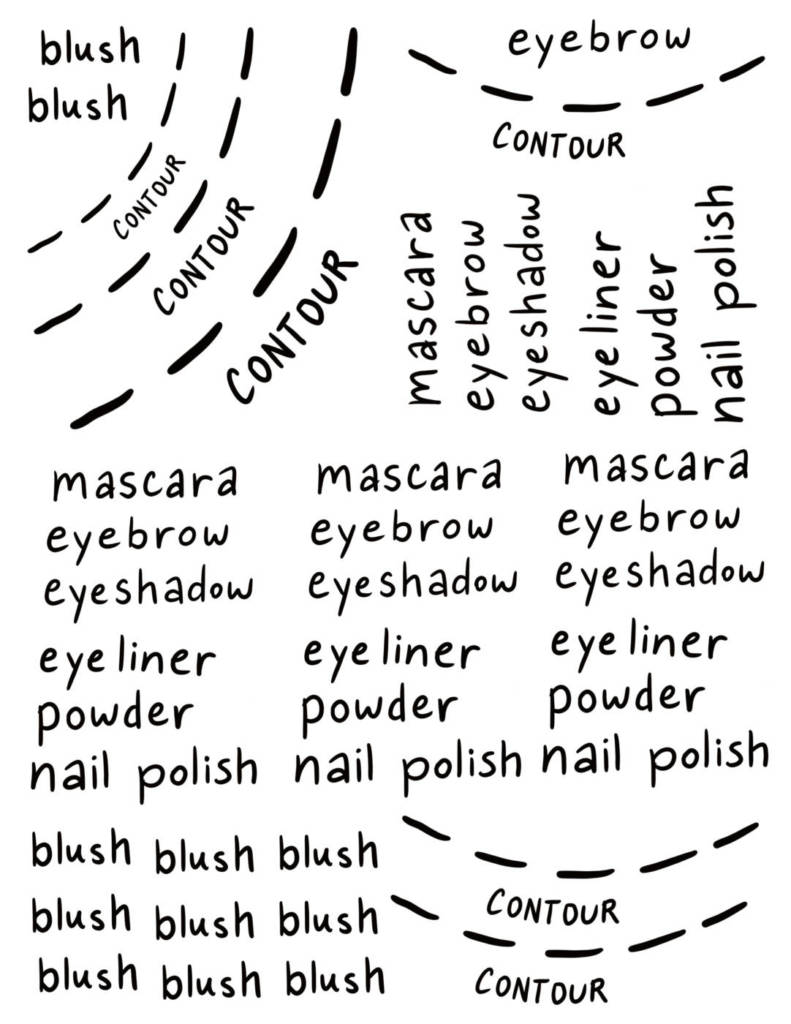
I think it’s funny how we’ve all kind of become walking billboards in the age of brand culture and fast-moving trends. People love to adorn their favourite brands or the most popular brands to fit in to a group or just look ‘cool’. But what they are really doing is providing free advertising for the brands they wear. In thinking about the pervasive nature of capitalism and consumer culture, I thought it would be interesting to make tattoos that say ‘your ad here’ to make clear how the body is almost a site of capitalism.
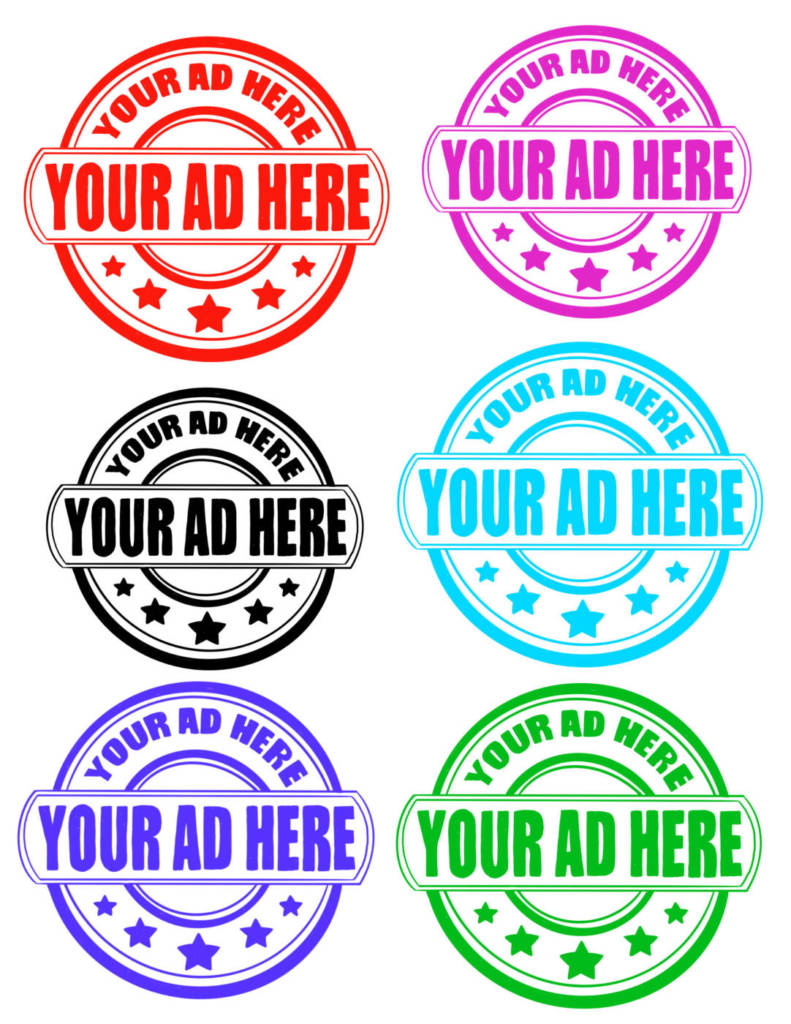
March. 27 – Tattoo Brainstorm
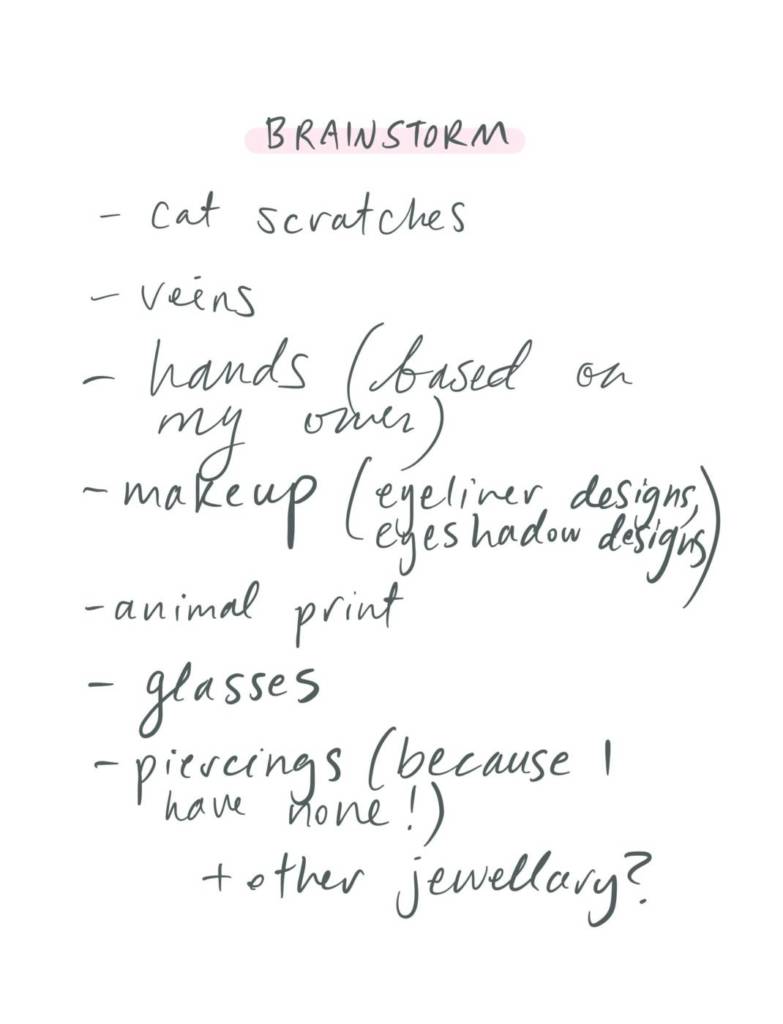
*for people who have glasses already they get a tattoo that says ‘four eyes’ to go above their glasses.
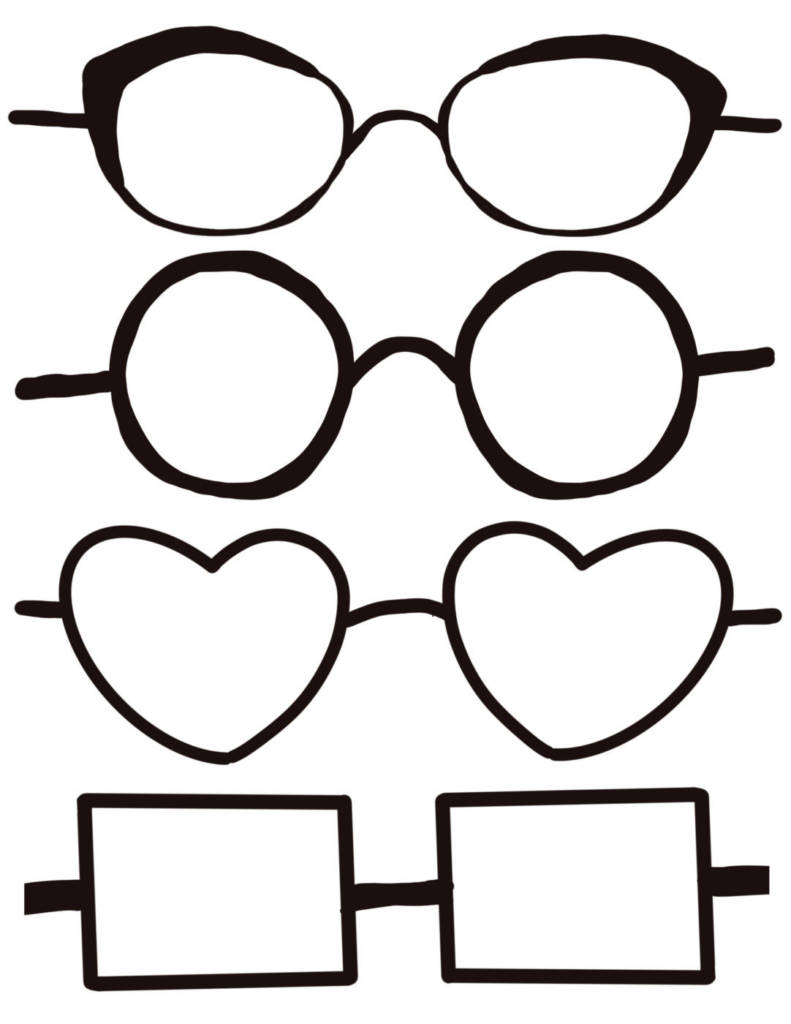
March. 24 – Parent Video Version 2
This version of my parent video includes a different audio track. It’s much more low-fi and raw feeling, as I recorded without a script. It took many takes of just watching the video through and recording myself reflecting on my thoughts about the content. I finally settled on the take I included in the video below. I also chose to leave in more awkward parts of the recording, like clearing my throat and coughing, to retain the feeling of the viewer watching my home videos with me. I wanted it to feel like my raw thoughts and feelings as I watched the videos of my past self and my parents’ past selves.
March. 13 – Parent Video Final
Title: Reflections on Parenthood – From the Outside Looking In
My final video is comprised of home videos and photographs. The narration over top is my personal reflection and thoughts on parenthood and the inevitable heartbreak of raising a child who will one day no longer need you. This idea came about as I was going through the content for this project. As I was going through old home movies, I found myself seeing them through the eyes of my parents and feeling an intense sadness for the loss of that closeness and intimate bond that exists between parents and children. As a result, I wanted to create a video that speaks to the feelings and reflections I was having about parenthood. This video is almost like a diary entry, a capturing of a moment in time in which I am struggling with the loss of my childhood and the guilt of no longer being home all the time and no longer needing my parents in the same ways.
Video Script
My parents didn’t initially want children. An architect and a pharmacist, they thought they would end up in a big city and thus kids would likely not be in the picture. But neither of them are big city folk, and so they chose to stay in the place in which they met. My mom said that it wasn’t until she was in her late 20s and close to turning 30 that she felt like something was missing in her life. That something missing was my sister and I. From the moment I was born, and then my sister just under two years later, we became their whole entire world. That’s one of many things that scare me about parenthood, the fact that this little creature becomes the centre of your universe and then one day they just get up and leave you.
I personally have never seen myself having children, it’s not a desire I have, yet my mom has told me that she sees me having kids one day. Who knows, maybe I’ll find myself in the same position she was in, feeling as though something is missing. Right now, I can’t ever imagine that happening. But I am my mother’s daughter, and maybe history will repeat itself and I’ll be watching this video years from now and laughing.
But anyways, as someone who doesn’t want kids and doesn’t see herself having children at any point, the subject of parenthood is not on the forefront of my mind. However, something I have thought about when it comes to the possibility of having kids is the inevitability of heartbreak when it comes to them. It’s impossible to avoid disappointing your kids in some way, in messing up parenting somehow. It’s impossible to avoid the slow tragedy of watching your kids slowly stop needing you and growing up and going away. It blows my mind how anyone can have a child. I believe it’s one of the most torturous things you can do to yourself – to bring this small vulnerable creature into a big scary world – and to care about this creature more than you could have ever fathomed you could care about anything. Having children is the ultimate vulnerability, and I am scared of a vulnerability that big.
My gratitude for my parents is overwhelming. It becomes even more heightened when I hear stories from my friends about their own boundary crossing, emotionally immature, narcissistic parents. Even more so when I see the way my grandmother treats my mother and her two siblings. The amount of guilt and pain my mother experienced in her relationship with my grandmother for years makes me all the more thankful for my relationship with her. Don’t get me wrong, it’s not perfect. She picks on my outfits and complains about my hair, I make jokes at her expense and am never home like I used to be. I spent most of my childhood battling obsessive compulsive disorder and the subsequent deep depression that followed. The stress this put on my mother was immense, although she did her best to hide that from me. Even so, I know she struggled with her own mental health in being my sole supporter and confident. In my shame for struggling with my mental health, I made my mother promise not to tell anyone else, even my dad. For years we had this secret between us, and looking back as an adult I can’t even imagine the amount of pain my mother would have gone through. Even more painful is probably the fact that I no longer rely on her for my mental health and as a result, no longer share such an intensely close bond. I no longer really even talk about anything super emotional with her, largely because of the guilt I carry for burdening her with it for years but also because as an adult I somehow along the way convinced myself that I had to take care of myself now.
The parent-child relationship is interesting, because it is a relationship in which one party is usually going to be giving more, the other taking and taking and taking. I didn’t realize as a child how much I took from my parents, and from my mother especially. There’s no boundaries with children, no days off, no vacations. But the time you get with them is shorter with each passing year, from being together constantly to having them move out and possibly far away. Growing up, I don’t think I really took into consideration how my parents felt or how their experiences and emotions may have been impacting them. I didn’t think about how I may have been impacting their feelings. I don’t think I thought of my parents as real people in a way, and it wasn’t until I moved out that I realized that they are just as vulnerable, imperfect and damaged as the rest of us. Now as an adult, I feel immense compassion for my parents. I worry about them. I feel guilty for what I put them through when I was a child. I see my parents on a more equal playing field now, no longer perfect people who are all knowing, they’re just as real as I am.
I used to often rewatch old home videos, relishing in the joy of my childhood and yearning to return to it. Now, as I was rewatching my home videos for the purpose of this project I found myself tearing up and feeling a lot of sorrow for myself and sorrow for my parents. I am now the age that it would be acceptable to have a child, and I see these videos through the eyes of my parents. I feel the pain of watching someone you are so intimately tied to grow up and struggle and be sent into the big scary world. I find myself feeling a sadness on behalf of my parents for the loss of their children. And a sadness in myself because I can’t stop myself from growing up. I can’t stop myself from no longer needing them in the same ways. I can’t stop myself from breaking their hearts in all the ways that a child can and will.
I am no longer a child, but there is comfort in knowing I will always be my parent’s child. I have my childhood home to go back to. Although it’s changed over the years, it will always bear the same comfort it gave me growing up. I am grateful knowing I have a place to come home to where I feel safe. So here’s to my mom and my dad, the two people that made my very existence possible. This is an acknowledgement of the absolute heartbreak that raising a child can be, but also of the beauty that exists when two imperfect people come together to try and raise someone to be better than they ever could be. That, I think, is the essence of parenthood, and in my opinion my parents did a pretty damn good job.
Feb. 26 – Parent Video Ideas
Initial Ideas
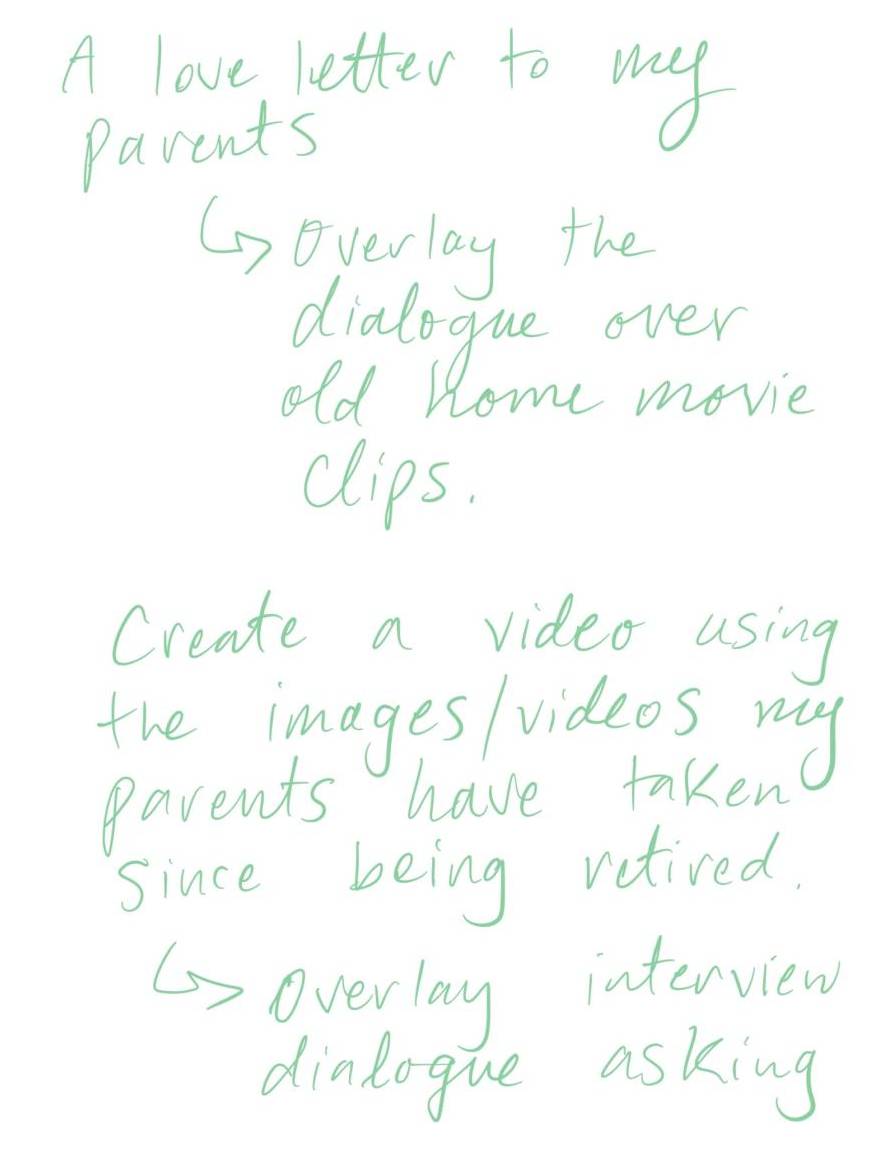
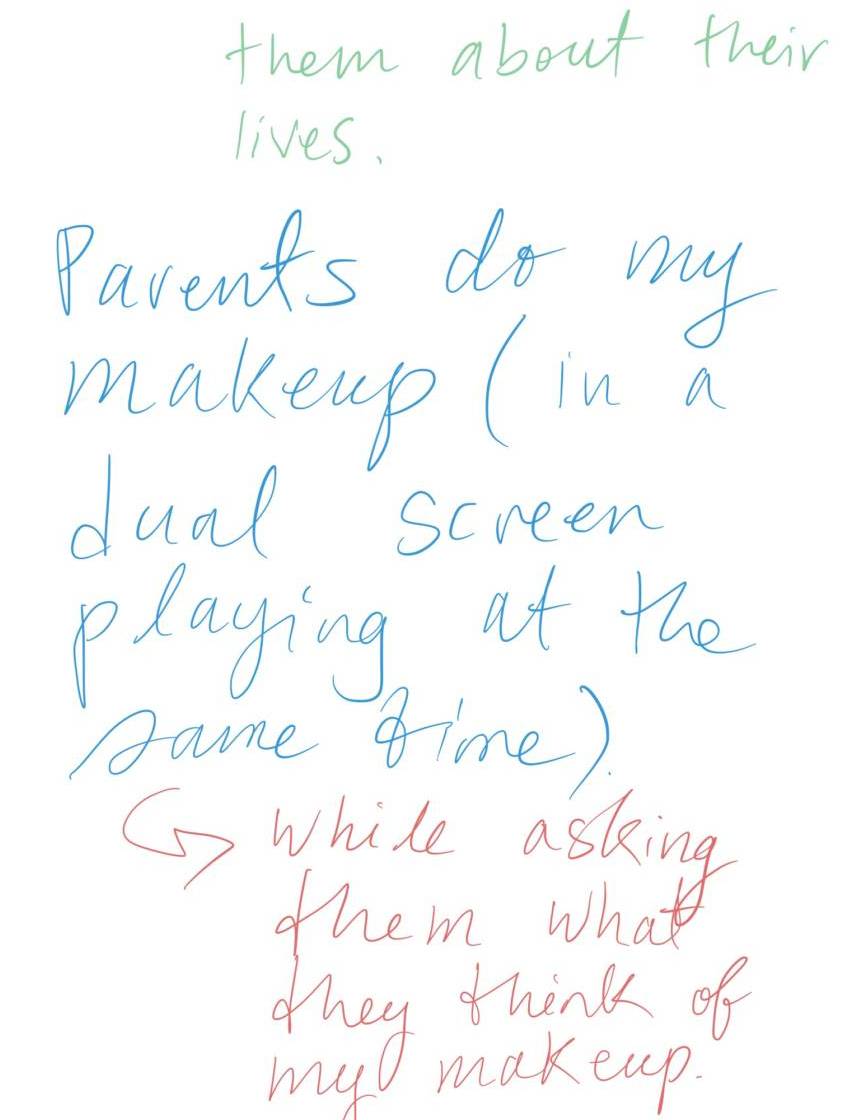
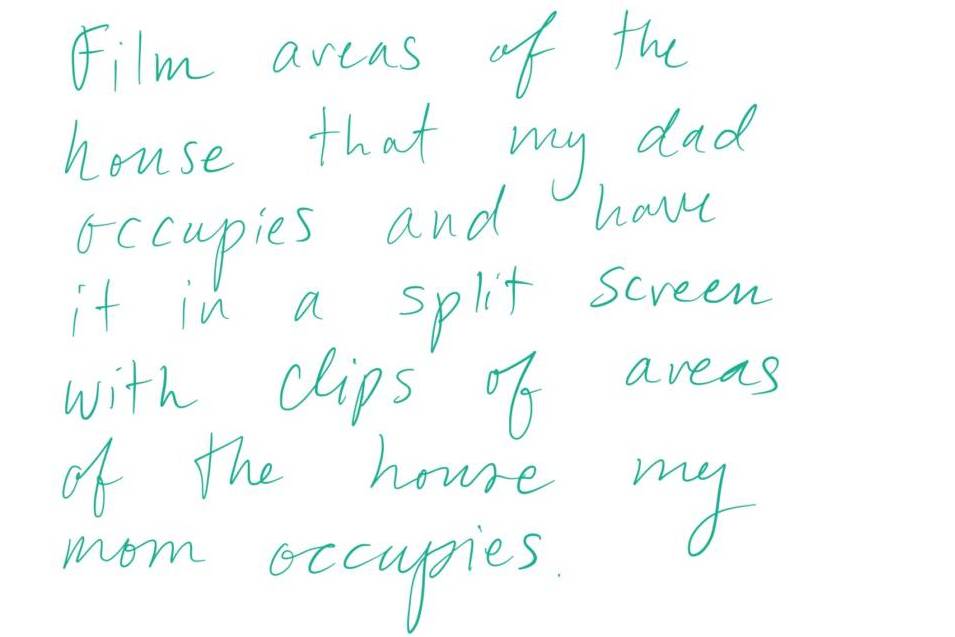
Test Video – Lunch Time
I unfortunately didn’t get as much time as I thought I would to record content of my actual parents, but I do thankfully see them all the time so I will be able to record more of them.
For this first ‘test video’, I sneakily recorded my parents from behind my laptop to create this hazy effect which also acts to hide their identities a bit (my parents both hate being photographed, although they have been taking a lot of travel selfies in their retirement!). I think my parents have an interesting dynamic, as they’re both very antisocial but have a very symbiotic relationship as they are together all day every day.
I was very happy with the quality of the audio, and the effect of the blurry scene. The lighting was very good this day, and because of the colours of the kitchen it made it look very airy and almost dream like.
Plan for Video
Get parents to each film the spaces they occupy on a daily basis. For example, my dad would film a short clip of the couch in our living room hat he lays on every day (there’s an indent of his body now). My mom would likely film domestic spaces as she often alludes to her distaste with her obligatory role in such tasks.
Get home videos and add a third split screen of the way the house looked when i was a kid.
Commenting on the inevitable heartbreak of parenthood in that your children grow up and leave, and you’re left with an empty house.
Feb. 6 – Post-Internet Video Art
Title: These Guys Mean Business
After hours and hours of scowering YouTube for moments in video essays where the person mentions their microphone or makes some kind of reference to it. I noticed that an increasingly common trope in video essay style content was the presence of a microphone visible on the screen. This is in contrast to the typical kind of content on YouTube and in film/tv media in which the microphone and other aspects of production are taken with great care to be hidden from the audience. The only time we see production is typically in News media and journalism, where we see the figure who is stating facts holding a microphone. As a result, the microphone is a signifier of authority over what is being said. It creates the illusion that the person speaking knows what they are talking about or have some kind of qualifications to be spouting whatever they’re talking about.
I thought it would be cool to highlight aspects of these really long form, often serious videos where the creator takes a moment to recognize the fact that yes indeed they are using a microphone. When all these clips are placed alongside each other, it really highlights the ridiculousness and mock importance the microphone yields.
I thought it would be really easy to find clips of people referencing their microphone in some way, but it was actually much harder as most of the videos I found were anywhere from 20 minutes to over an hour. I eventually discovered that most videos allow you to pull up the full transcript, which allowed me to control f and search for the word ‘microphone’ in the video without having to watch it. This sped up the project immensely. My strategy for finding clips was going to a video essayist’s channel and searching for the first time a microphone appears in their videos, which is usually when they will make some kind of announcement that yes they have a new microphone.
Jan. 30 – Work in Progress: Post-Internet Video Art
How does your video document a historical moment – in internet culture, and in the wider world?
- Video essays exploded onto the internet in recent years, bridging the gap between the academia and the general public. This unique format allows the essay, an academic paper putting forth an idea or argument about a specific subject, to be more accessible and palatable.
- Video essayists often combine snappy comments, humour, media clips and bold text to create an entertaining video.
- The original video essays on YouTube were highly produced videos that had a strong narrative flow and visuals that exemplified it. Now, video essayists are finding new ways to make their content interesting. Some take on characters that relate to their topics, dressing up in costume and using elaborate props and sets. Others take a more relaxed approach, sitting in front of the camera with a microphone talking and occasionally overlaying clips to further a point.
- “In its intent the video essay is no different from its print counterpart, which for thousands of years has been a means for writers to confront hard questions on the page. The essayist pushes toward some insight or some truth. That insight, that truth, tends to be hard won, if at all, for the essay tends to ask more than it answers.”
- John Bresland on the Origin of the Video Essay: https://blackbird.vcu.edu/v9n1/gallery/ve-bresland_j/ve-origin_page.shtml
- As John Bresland states above, the essay has been around for thousands of years as a format to convey ideas and facts. It makes sense that in this increasingly chronically online world that the essay would evolve to exist in a video format. I’ve even made video essays for Art History classes in the past, which demonstrates how this social media genre has made it into higher education.
- I want to highlight the absurdity, pretentiousness, and over saturation of people on the internet creating lengthy essay videos on absolutely any topic you can think of. They use the same language as you would find in an academic essay, which elevates their words to a higher standard, sometimes manipulating the viewer into taking them as fact when they are often times opinion.
How does what you want to do amplify, deconstruct, or subvert what is already happening on the internet?
- I want to deconstruct and subvert the power of the video essay. Of all the content on the internet, video essays have made a place for themselves among ‘higher brow’ content and inherently claim to be more intellectual content than your average cat video. You can see these video essays almost making fun of themselves, whether intentional or not, by incorporating humour and costumes and other aspects of internet culture to appeal to their audience.
- I also want to amplify the trends, and copy cat nature of these video essays. There’s often video essays that have nearly the same titles, with many people making videos on the same cultural niche topic. The style of videos, editing and props use also tend to be similar. The infamous hand held microphone has become a staple of video essays, which some essayists have made jokes about directly in their videos.
How is what you are doing something new?
- There have been video essays critiquing and/or parodying video essays, but I haven’t seen anyone make a compilation style video using footage from these videos to make something new.
- I think it will be interesting to edit a bunch of clips from many different video essays together to highlight how silly and pretentious they can be, and encourage the video to question the tactics and style of the video essays they’re watching and how that may impact the credibility of what’s being said.
What is the kind of experience you want to create for viewers/users?
- I want the video to be confusing in terms of the dialogue. I want to take the clips out of context and have them kind of relating to the other video clips, so there appears to be some kind of narrative flow but the viewer won’t be able to really figure out what it is.
- I want the viewer to feel inundated with information and big words, but also have clips that expose the absurdity and ridiculousness of some of these videos. I want them to laugh at them too.
What is the ideal way for the video to be presented?
- Ideally the video would be presented on a loop on a laptop and the viewer would be able to take a seat at a desk and watch it as they would an actual video essay on YouTube.
- Alternatively, pretty much all video essayists are sitting in front of the camera, I would have the video playing on a loop projected on the wall to have the human subjects be life size. Viewers would be able to sit on a couch across from the video.
What are some of the technologies, software, or technical experiments and gimmicks you may need to achieve? Do you want to use avatars? Live stream? Rip music and video from YouTube? Prepare your ambitious technical goals for Nathan, and we can design demos to support your ideas.
- I think I want to play around with videos manipulation and maybe overlay videos. I’m not entirely sure what technical experiments I want to do quite yet. I think just a general overview of some of the cool features of Da Vinci Resolve would be helpful!
Work in Progress
I compiled a bunch of clips from YouTube and have arranged them in a way that I felt made the videos flow well together and kind of bounce off each other. I am unsure exactly what I want to do with the clips and what else I want to do, but it’s been a good start to play around with their order and what parts of the videos I want to keep and what parts I want to delete or move around for my own purposes.
Jan. 23 – Post-Internet Video Art Research
BookTube
As a child I was an avid reader. Pretty much all I did in my spare time (and even underneath my desk and school) I was reading. As a result, I started looking up things related to books on YouTube and I quickly discovered the world of ‘Book Talks’, ‘Bookshelf Tours,’ ‘To Be Read Piles’, and of course, Goodreads. My favourite YouTuber was PolandBananasBooks, a super exuberant and bright individual with passion for books.
Christine of PolandBananasBooks also created creative, silly and fun comedy skit videos on a separate channel, but also incorporated her creative side on her book channel as well. Light hearted, skit or ‘challenge’ videos were also a common feature of early BookTube. Creators would make book tags and tag other fellow creators to do them.
I was absolutely addicted to watching bookshelf tour videos for a large amount of time. These videos simply involve people showing you their bookshelf and each individual book on their bookshelf. They talk in detail about the books, about how they chose to organize or display them, purchases they regret, so on and forth. These videos could be up to an hour long depending on how large the collection. This quickly led to my own book buying addiction. I accumulated two full shelves, three floating box shelves and a third, skinny shelf. I also have books piled in my armour and under my nightstand and on top of my bookshelves and pretty much anywhere they will fit. I have since tried to do e-books, for the sake of my bank account.
To this day, book videos are so comforting to me. They brought me so much joy and comfort as a child; I felt like I was part of some community and I think a lot of people who watched those videos did as well. Booktube also featured terminology that was commonly used by those in the community, such as TBR (to be read), OTP (one true pairing), DNF (did not finish), and the concept of ‘shipping’ characters (wanting them to end up as a couple).
2010s Lifestyle and Beauty YouTubers
In elementary school I discovered YouTube and immediately fell in love with the bubbly, upbeat and wildly saturated visuals that characterized the 2010s lifestyle and beauty videos. I obsessively watched room tours, morning routines, back to school videos and DIYs. There was something so comforting about these videos to me as a child, and I think it largely had to do with how eye catching the visuals usually were and how enthusiastic and overly friendly the YouTubers seemed.

I recently watched a video of two YouTubers I had watched back in the day talking about the reality behind the videos they were making in the 2010s. They were talking about how they were making all these videos that were supposed to reflect their real life and who they were, but in reality they were in their twenties trying to be relatable to tweens and teens. It made me realize that the glossy, well put together videos of people I thought were just like me were curating an image that they new would get views. I think the draw of YouTube was the relatability, and how it felt like the creators on the platform could actually be your friend.
I think it’s so interesting how beauty and lifestyle YouTubers took over the internet, and how many young girls found a community within that. Even if my life wasn’t going the way I wanted to, I could put on a room tour video or a morning routine and fantasize about what it would be like to have a ‘perfect room’ or ‘perfect life.’
The obsession with DIYs was also prominent in the lifestyle community. There were so many DIY room decor videos, and one for every season or theme you could think of. I was also obsessed with DIYs at this time as a result, and tried many from YouTube which often did not ever look like it did in the video.
The irony of these videos now is how geared to young kids they were. Even the way the YouTubers spoke was quite childlike, and many of them were making content that wasn’t even relevant to them anymore. The Back to School videos were some of the biggest moneymakers, so even after graduating they had to pretend they were going back to school to continue profiting off their target audience.
What’s funny is that this era of YouTube and this era of style is now seen as nostalgic and people post about ‘the good old days’ when it was only ten years ago. These lifestyle YouTube videos started a lot of the trends that happened in fashion for young girls of this time.
Key Features of 2010s Lifestyle/Beauty YouTube
- Bright colours and over saturation
- DIYs
- Upbeat, bubbly personality
- Bright, upbeat music
- Fun transitions
- Collaborations with other YouTubers
- Bath and Body Works (everyone had a bath and body works candle shrine)
Video Essays
Video essays
Video Essays are another genre of YouTube that I was obsessed with and still really enjoy. Video Essays were mainly about film and tv, but recently I have been noticing more and more people doing hour long video essays on a wide range of topics from things within culture to politics to history.
I have noticed that the video essay format has evolved from a pretty short, snappy take on a topic or movie, often edited in a very cinematic way to a more casual and relaxed format. Now video essays often feature the narrator on screen sitting down in front of the camera to share their insights on a topic. They include cuts to clips or images, but the focus is on the person speaking.
Key Features of Video Essays
- Eloquent, well-rehearsed narration.
- Combining text, video and photos to communicate an argument or idea.
- Often organized or divided into sections, just like an actual essay.
- Typically uses more academic language than is usual on YouTube.
- An even, calm tone is often used to convey a feeling that they know what they’re talking about.
- Humour is well integrated and snappy.
Video Essayists present themselves to the viewer as an authentic, knowledgeable and passionate voice on a topic, and the presentation of a well edited video also serves to contribute to their perception as credible. It seems that video essays are only becoming more popular, which makes sense as our attention spans are so limited why would anyone want to read about something when you can watch someone explain it to you. Watching a video essay allows the viewer to feel smart and intellectual, as they engage with social and political commentary, yet it is still a very superficial way of consuming information on a subject.
Video essays are one individual’s take on the subject, and unlike an actual essay, we don’t often get citations for their claims. As a result, their credibility comes from how they present themselves, and most of them present themselves as very smart individuals. A common critique of video essays is that they can easily spread misinformation, as it can be hard to distinguish between the essayists’ opinion and fact. Critiques of video essays often come in the form of a video essay, which is so ironic in and of itself and just absolutely hilarious. A whole new genre is born from it: anti-video essay video essays.
Jan. 16 – Make Your Own GARLAND BANNER
A Page from Dirty Words by Tammer El Sheik
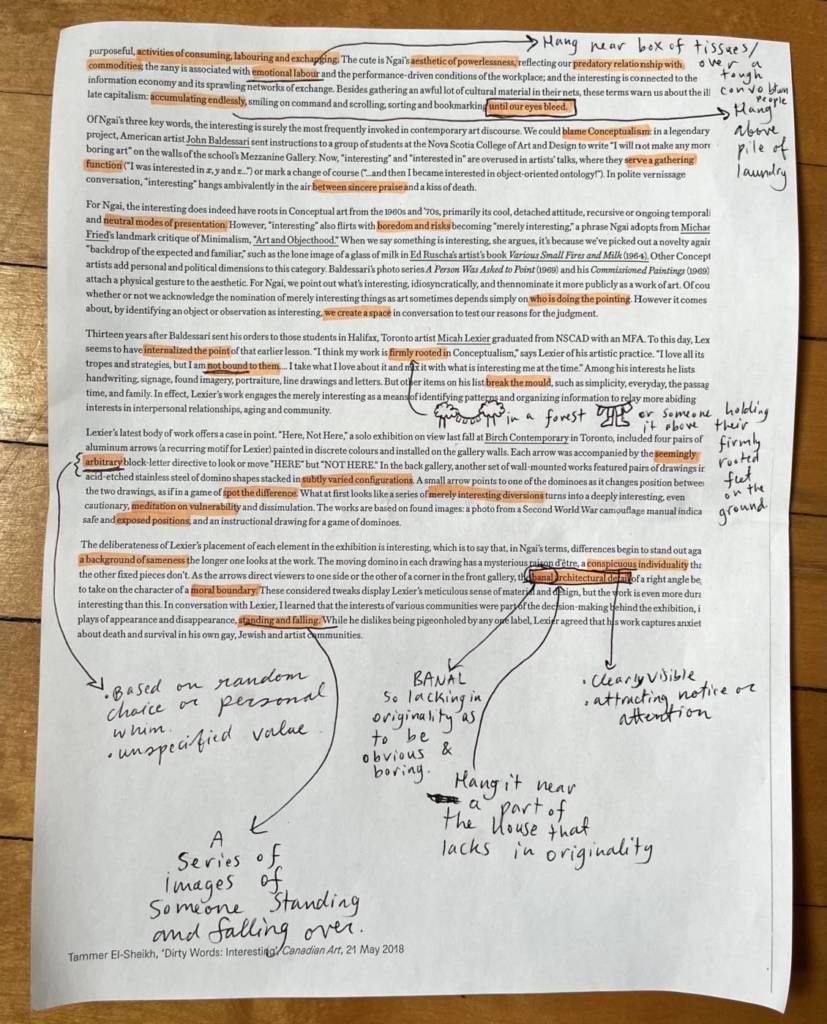
Our Eyes Bleed
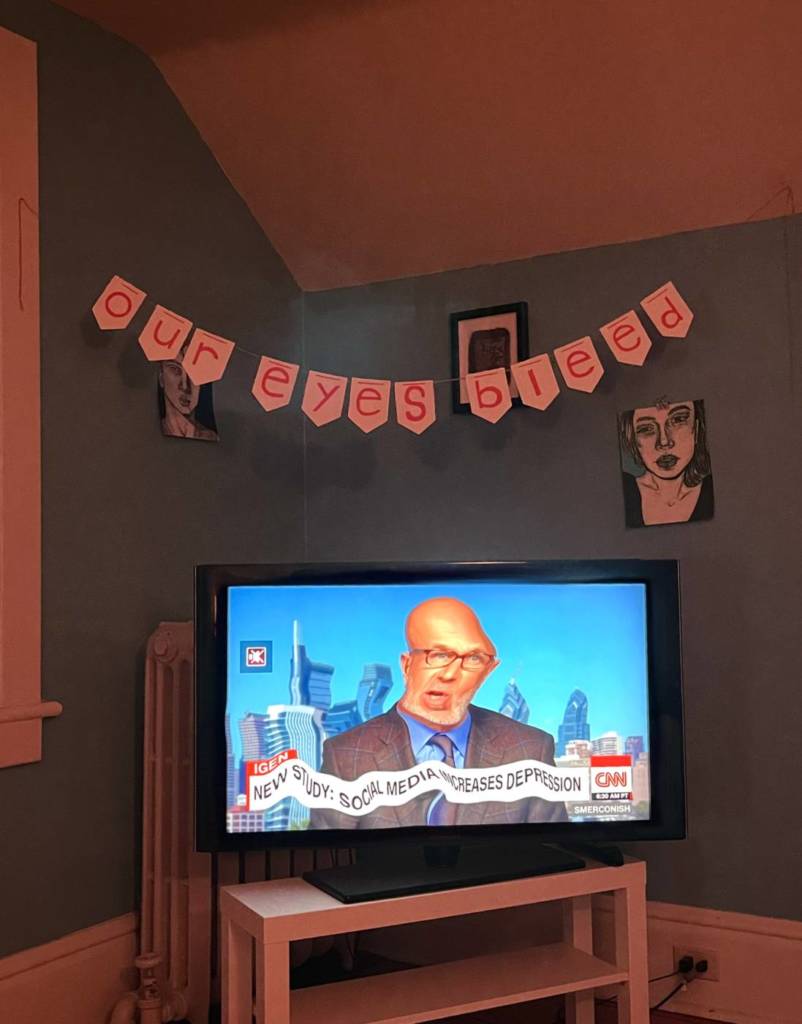
The above image features an excerpt of text from Dirty Words by Tammer El Sheik, “our eyes bleed”, which was taken out of the full sentence: “Besides gathering an awful lot of cultural material in their nets, these terms warn us about the ill late capitalism: accumulating endlessly, smiling on command and scrolling, sorting and bookmarking, until our eyes bleed.” El Sheik is talking about the overwhelming constancy of information that we are constantly consuming and being exposed to in our current late stage capitalist society.
I decided to use the colour red for the text to emphasize the word ‘bleed’ and also the idea behind the words that we are being inundated with information until we get to a point where we can’t take it anymore. I put a news clip on the tv featuring a story about a study claiming that social media increases depression. This is a common story that we’ve all likely seen in media and online, as society is becoming increasingly chronically online and more isolated than ever. I chose to distort the visuals on the tv to convey the idea that we are so overwhelmed by information that our brains stop absorbing it and it all essentially becomes a meaningless onslaught of content.
Our Eyes Bleed Re-Photographed
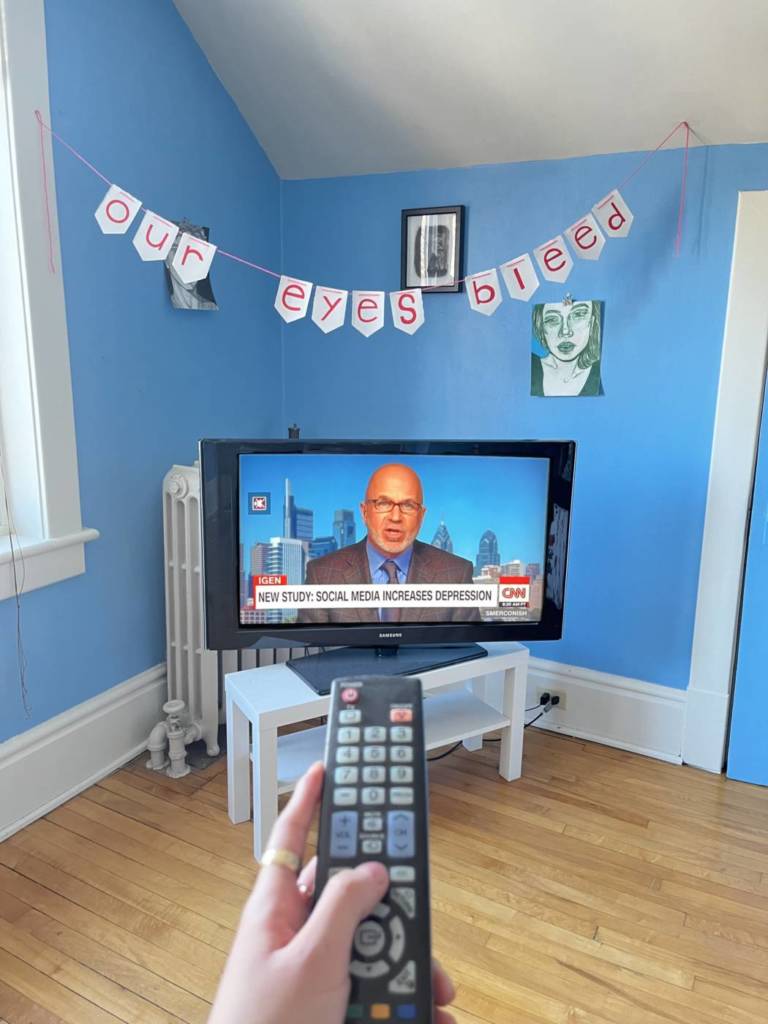
After class today I went home and re-photographed my banner, this time I took two separate photos (one with the tv on and one with it off) and overlayed them to fix the issue of the white balance I had with the first attempt. I definitely like this one a lot better, and also added in my hand holding the remote to fill up the bottom of the image a bit more.
Senioritis is Hitting Hard: my eyes are bleeding, not sure about yours.
I decided to hang my garland above my desk and stage a little studious photo shoot to encapsulate my senioritis. I am graduating this semester, so schoolwork definitely feels like my eyes are bleeding a little.
Jan. 11 – Definition of a Hypocrite, Guerrilla Girls, 1990
Who Are the Guerrilla Girls?
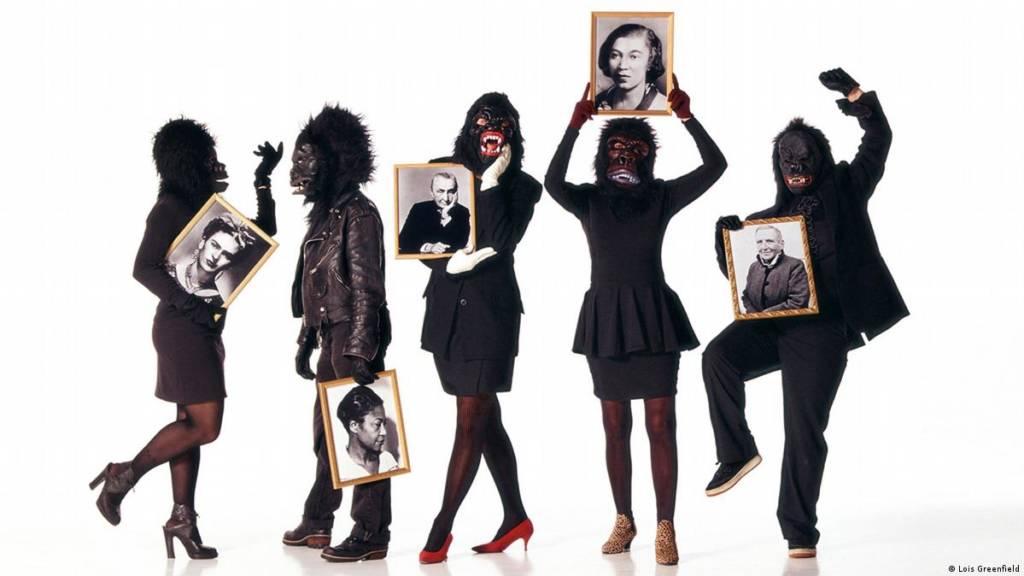
The Guerrilla Girls are a feminist activist group comprised of anonymous artists who employ headlines, visuals, and statistics to expose gender and ethnic bias in art, film, politics, and pop culture. They are defined by an intersectional feminist lens as they advocate for the rights of all people through their disruptive projects. They also often utilize humour as a way of grabbing the attention of viewers and making their message more accessible to an array of audiences, as they have expressed that humour is an “effective weapon.”
They adorn their gorilla masks to remain anonymous, both as a way to protect their personal art careers and also as a way of ensuring their message takes centre stage. Each member also takes on the name of famous artist, such as Frida Kahlo or Käthe Kollwitz, which were the pseudonyms used by the founders.
The work of the Guerrilla girls often confronts the viewer with a headline or statement that exposes a social reality/injustice and seeks to engage the viewer in their complacencies.
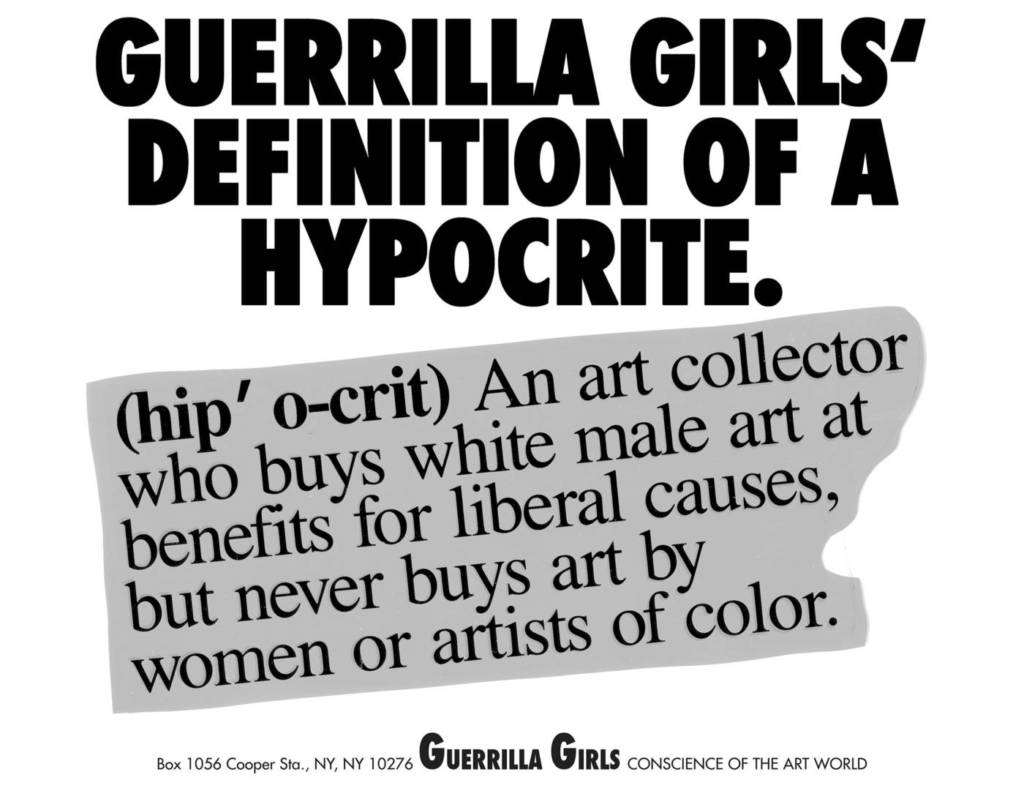
Their work, Definition of a Hypocrite, meets the viewer with a flashy headline and a definition that calls out the inequality that persists for women and people of colour in the art world. They are pointing out the hypocrisy of wealthy art collectors who often only support white male artists that have long passed on. As more diverse people enter the art scene, it is hypocritical to continue to only purchase and support the art of white male artists.
This work was a part of a collection of 30 posters for the Guerrilla Girls’ project titled Guerrilla Girls Talk Back. They combined flashy and graphic design akin to advertisements, placing their poignant messages on posters to be pasted around the city. Instead of being sold a product or service, viewers are presented with startling facts and statistics that expose the dark realities of the inequities that still exist amongst different genders and ethnicities, specifically in the art world.
Art as Activism
The Guerrilla Girls are important to both the art world and the world at large, as their practice focuses on questioning and bringing light to social injustices and inviting the viewer to confront them head on. Their use of posters, billboards, and other interventions into public spaces bring their messages to the average viewer who may not have access to art institutions.
Their work is activist in that it confronts the public with disruptive messages that invites the viewer to confront the dominant narratives in society. For example, their work on billboards using text and imagery to reach the public calls attention to injustices in society
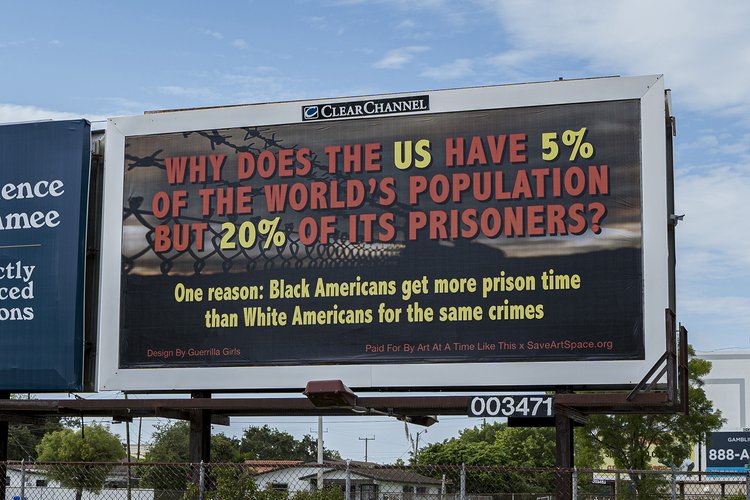
Jaz
TATTOO PROJECT: IDEAS
For this assignment I was curious about my personal experience with tattoos and the somewhat negative feedback or experiences I have had with tattoos in relation to my family’s reactions and opinions. I had the idea to interview initially just my mother, as she is the one who signed off and paid for my first tattoo, however after speaking with her I wanted to ask my father the same questions. Unfortunately the phone call didn’t record audio as I had first hoped to have, but I asked a number of questions about how she felt about tattoos in general, about my choice to get tattoos, if she had any regrets letting me get my first one, and if she could describe my tattoos in one word what would it be. I asked my dad relatively the same questions, other than the one regarding signing off for my first one, and the answers were surprising similar.
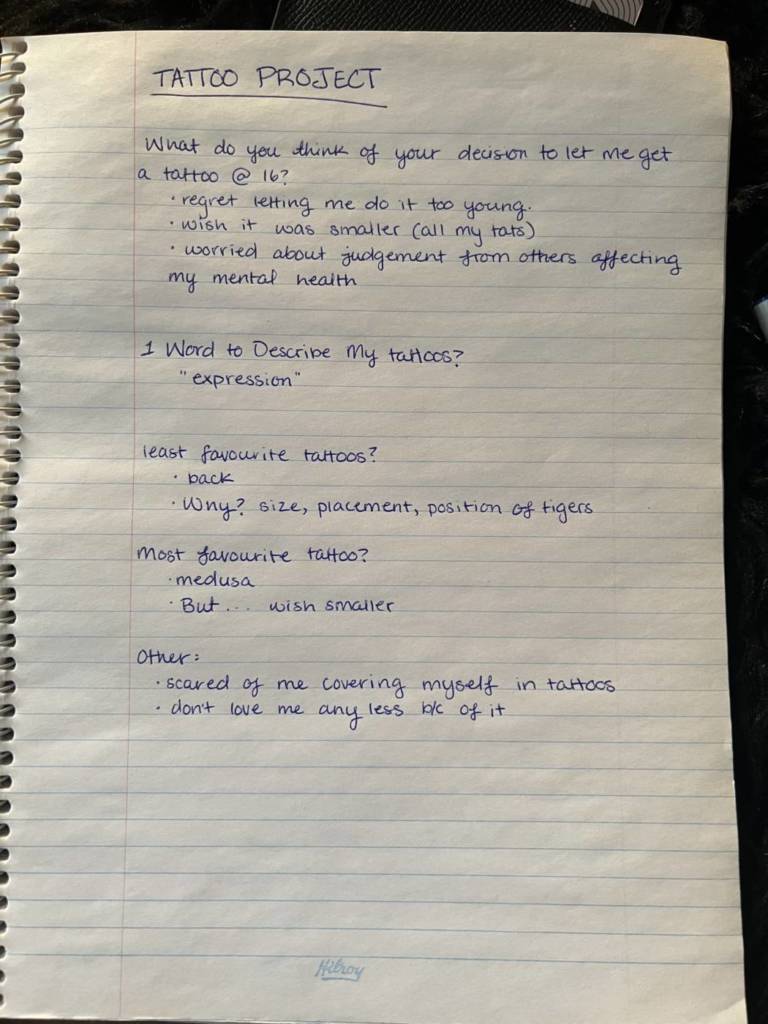
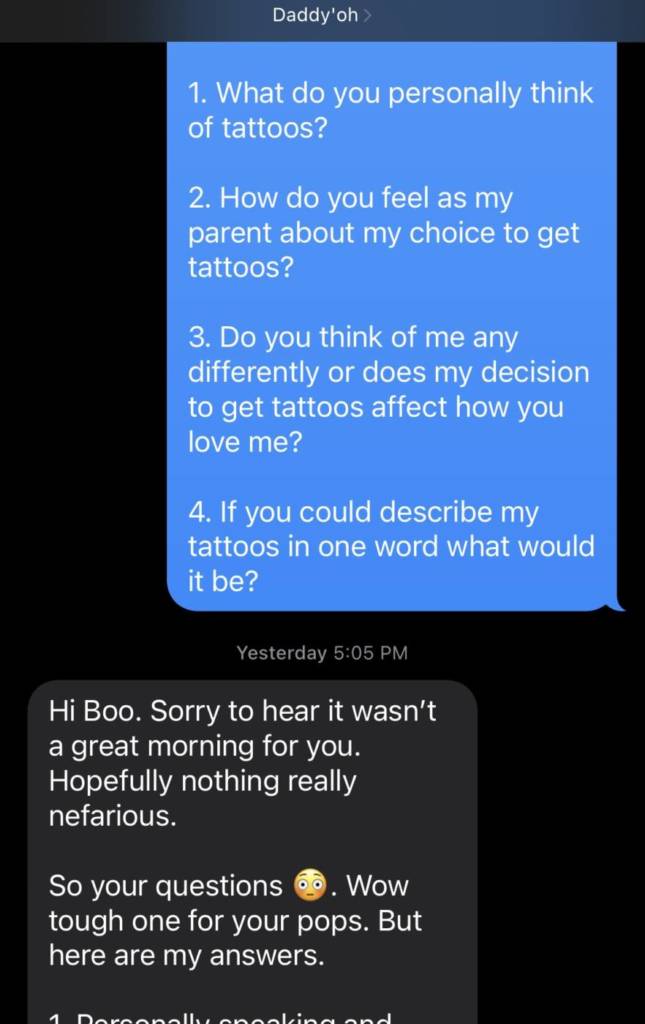
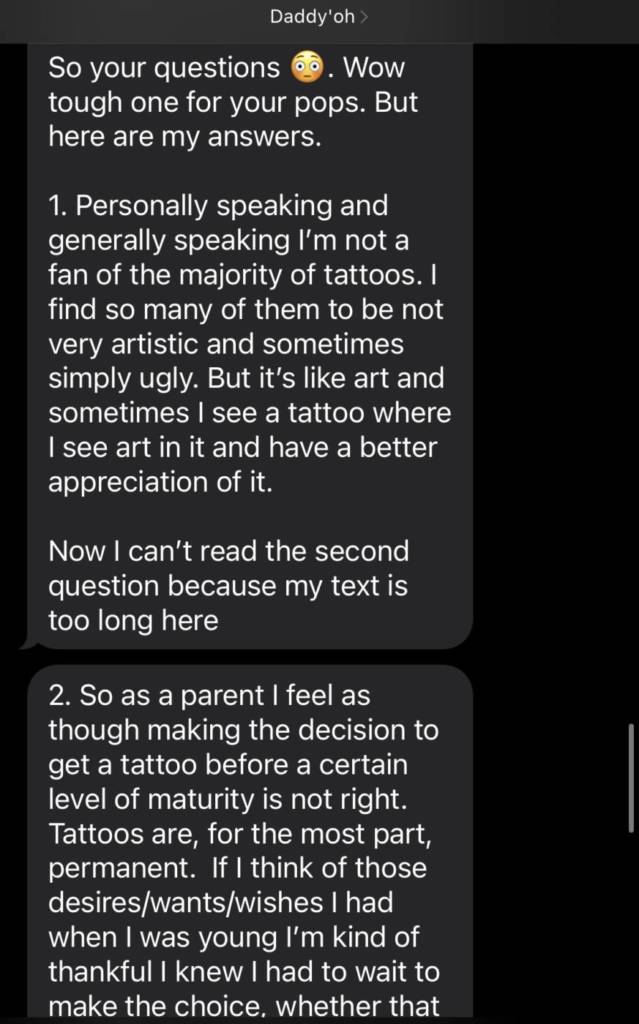
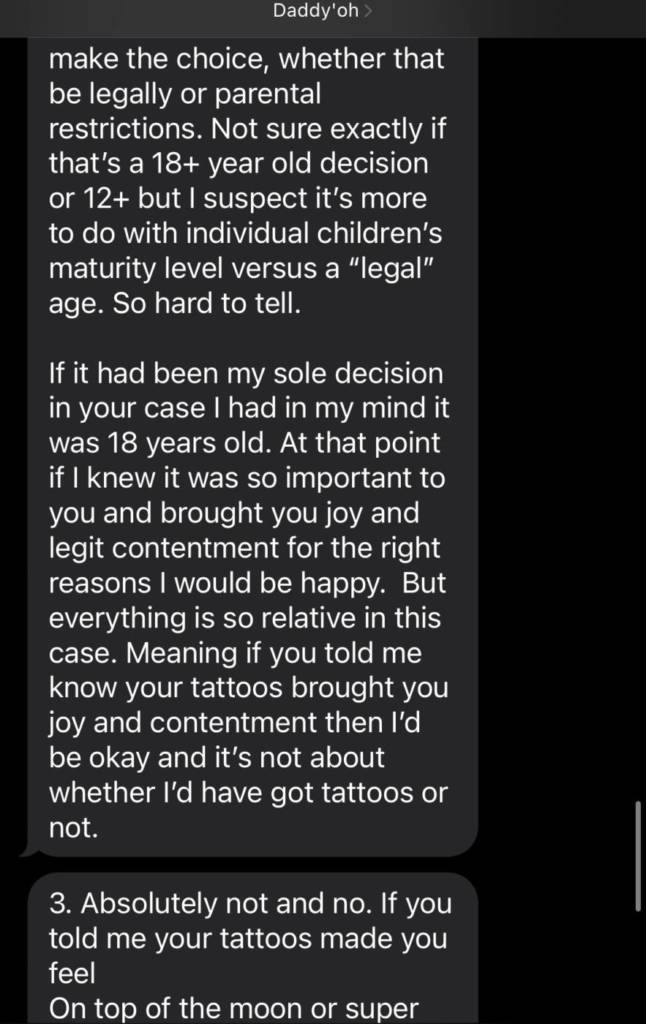
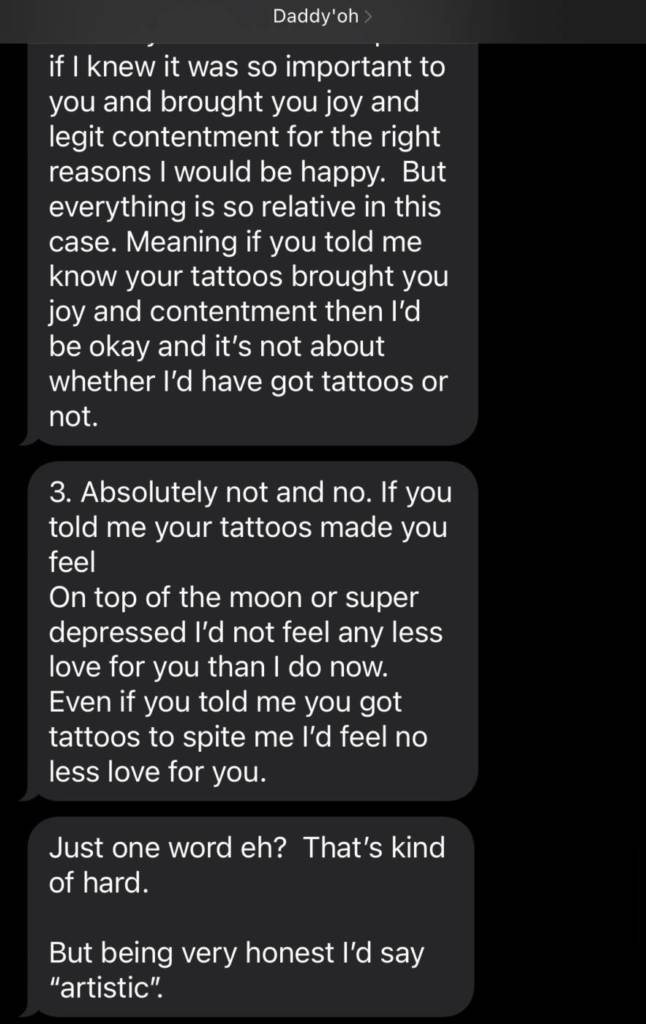
I asked them both if they could describe my tattoos in one word, what would that word be. My mother’s word was “expression” and my father’s was “artistic.” With these words I want to play around with different fonts and see how that impacts the meaning of the word and as a tattoo.
PARENTS PROJECT: ARTIST BOOK
Since I have done this project already in video format in Experimental II, I was tasked with creating an artist book that followed the same subject matter of ‘parents.’ I chose to focus on my dad this time around and through images of his parents, his past, and his present life, create a book that captured his place as a parent in my life. It was important to me to include images of his parents, even if their identities are not obvious to people outside my life who view these images; I believe that who our parents are shape not only the individuals we become, but as well, the parents we become, if we do. I think it was equally important to include images that were from when he was married to my mother since that was another chapter of his life that relates to him as a parent and parenthood in general. His past marriage and when he first became a parent is equally as important as where he is in life now as a parent in another marriage, because I have got to experience the ways in which he fathers all of his children along with the similarities and differences. This was a difficult project for me to complete for a few reasons, I think especially because this idea of ‘parent’ does not always hold a positive connotation for everyone. It was important for me to keep my intentions with this book true, despite it maybe not being a perfect portrait of parenthood, or altering it to make sense for other people, because as the artist, it makes sense to me and my experiences. This being said, I did try to take the feedback I got from my lovely peers and use the insightful critiques from you all when making my final editing decisions.
INTERNET VIDEO TREND: “ALL GRWM”
For my internet video trend I found myself experimenting with a lot of different subject matter or internet video tropes, however, a consistent theme I was incorporating was ‘animal videos.’ Animal videos have a long history with the internet and appear on all platforms, from YouTube compilations of “funny cat videos” to TikTok’s of “pet meal-prep.”
Being the animal lover I am, I opted to go the route of using animal videos as my subject matter. A lot of the videos I watch on the internet are light-hearted or ‘filler’ video throughout my day of just scrolling through my social media platform feeds. For this project I wanted to capture the light hearted or for lack of a better word, ‘meaningless,’ videos that I come across daily. Similar to what I originally had in mind of pit bull pampering videos, my work is a video compilation of all types of breeds being pampered or groomed in a human like nature. A lot of what is being performed on the dogs is what human’s themselves are doing in similar “get ready with me (GRWM)” videos, and so I wanted to have the two side by side to act as a visual commentary on the similarities of the two.
Whether this video is meant to be humorous, a parody, thought-provoking, commentary of the times, etc.; none of that is definitive or a decision made intentionally, I more so wanted to have fun with the videos I commonly consume and play around with the similarity of the two video trends/genres.
VIDEO TRENDS: DOG PAMPERING
https://vm.tiktok.com/ZMYdKS9q5/
https://vm.tiktok.com/ZMYdKudC9/
https://vm.tiktok.com/ZMYdKDELD/
https://vm.tiktok.com/ZMYdKrgua/
The internet trend/video culture that I chose to discuss is ‘dog pampering’ or ‘dog beauty routines,’ specifically pitbulls. Some of the videos are parodies of ‘beauty routines’ or ‘get ready with me’ videos, however, some are just genuine dog grooming routine videos.
TEXT IN ART: BARBARA KRUGER’S “YOUR BODY IS A BATTLEGROUND”
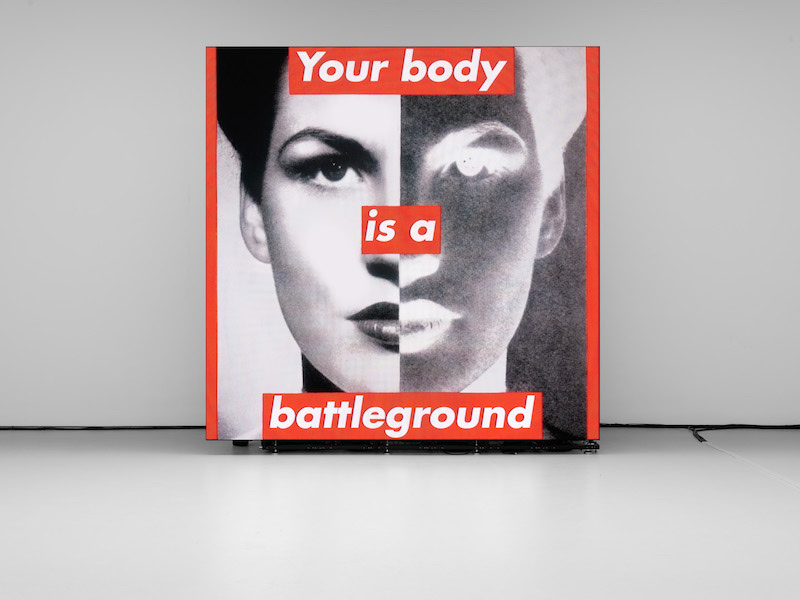
American conceptual artist, Barbara Kruger, is known for the incorporation of text into her works. The provocative messages usually play with concepts of capitalism, the body, and the meaningless nature of advertisements. The particular piece, your body is a battleground, was created for the Women’s march on April 9, 1989 that took place in Washington, DC. The march was an activist movement that happened as a response to anti-abortion laws at the time.
This colour combo, bright red over black and white, as well as the font style, is prominent throughout a number of Kruger’s artworks. The bold highlighted statements resemble advertisements and are eye-catching, but it is the actual phrases that move the piece beyond just a reproduction of advertisement font and images. Beyond the statement, “your body is a battleground,” the image used in this piece resembles the stereotypical beauty standards women in western society are expected to uphold, yet another way the autonomy of the female body is challenged.
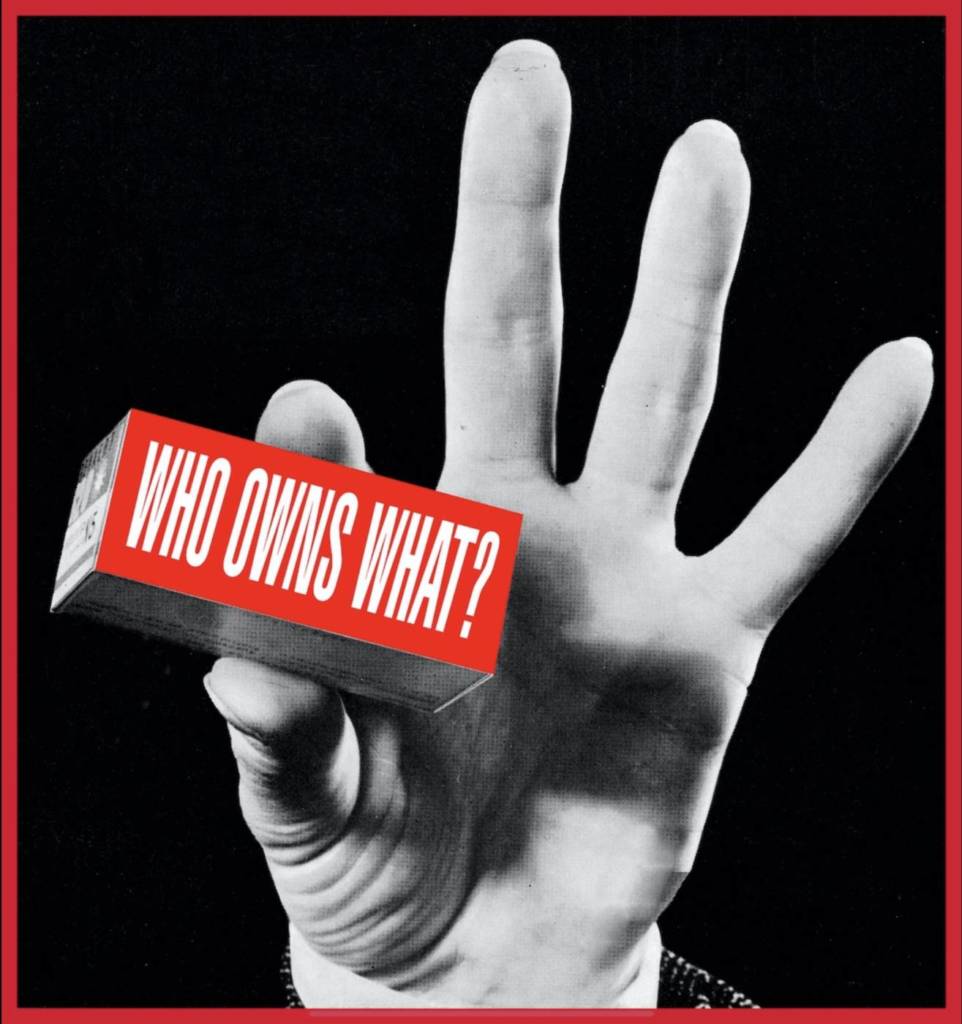
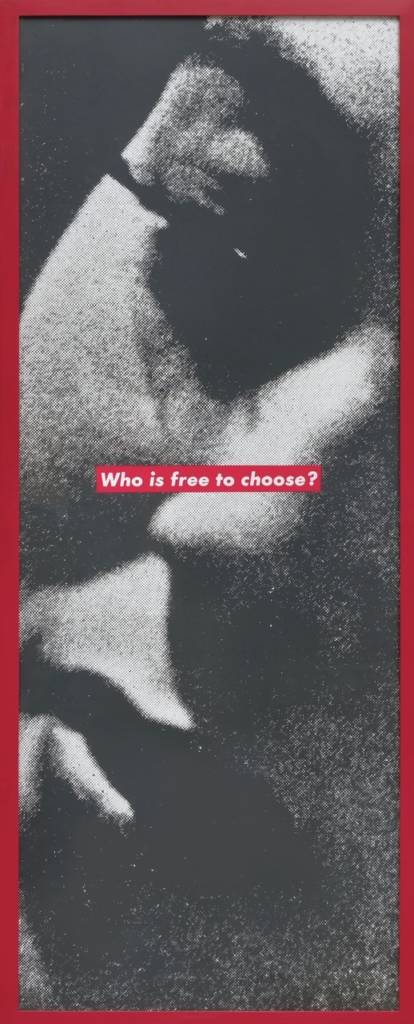
GARLAND BANNER
JANUARY 16
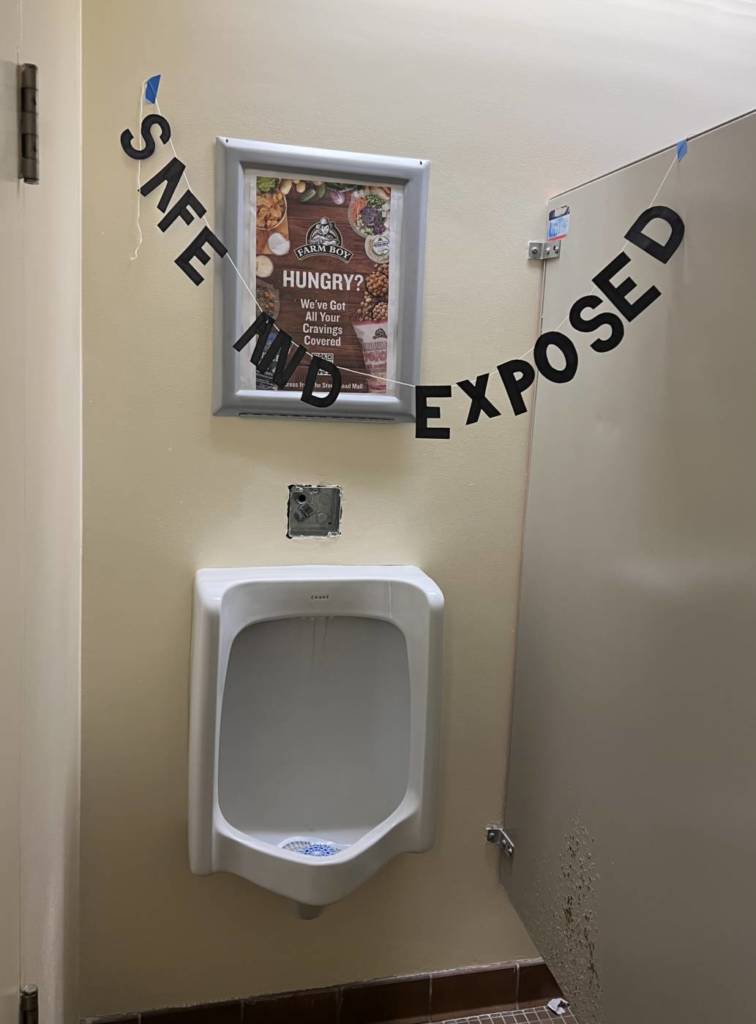
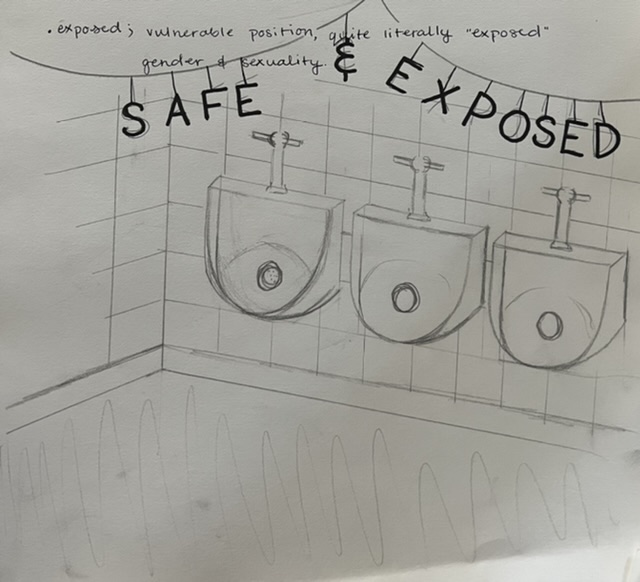
Nikki
Week One – Artist Research – Eleanor King
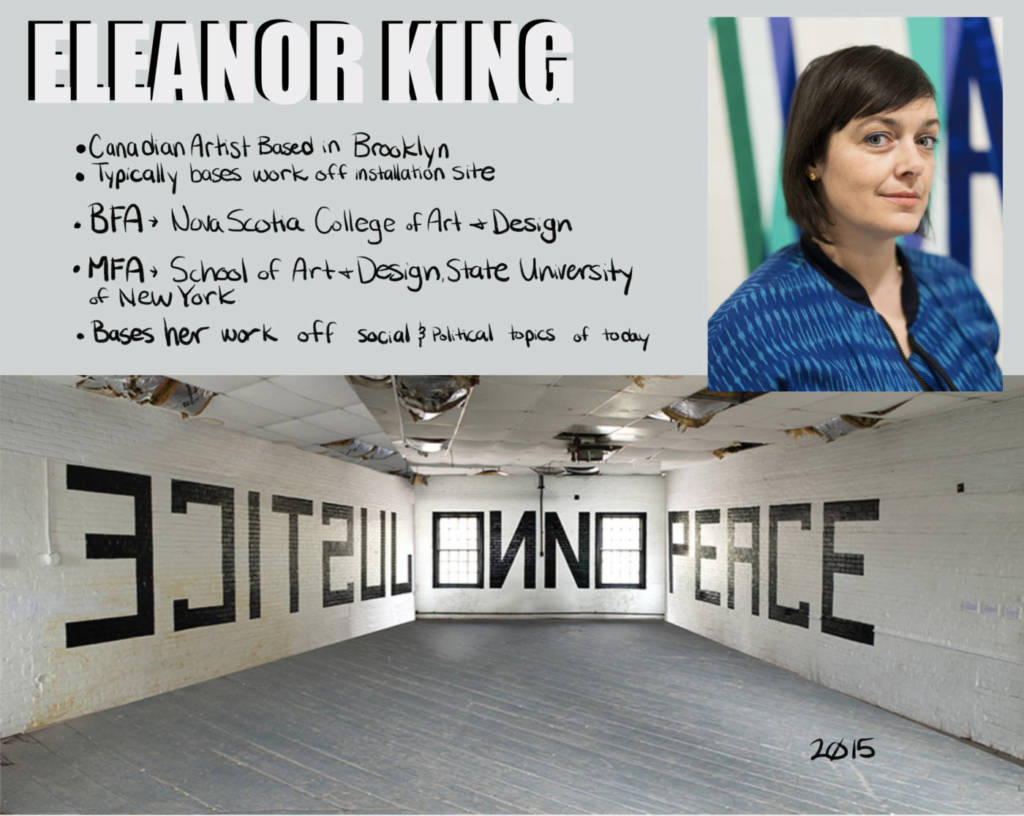
The main work of Eleanor King of her “Wall Text” series is her work ‘No Justice NO Peace’. The phrase stemmed from approximately 1986, following the killing of Michael Griffith after he was attacked by a group of young white men. However, the saying is also a rephrasing of the famous Martian Luther King Jr quote of “Without justice, there can be no peace.”
The work greets viewers with a polarizing balance of having the words ‘no justice’, being mirrored to ‘no peace’. I was unable to find any definitive explanation from the artist for the work’s composition, so instead I will focus on my own visual interpretation. The slogan is synonymous with the Black activism and especially the Black Lives Matter movement. The words already carry an impactful emotion without the added visual elements, but the way King shows the work is meant to show balance and emphasize what the motives of these movements are. The words no are centred to each other on a small wall with the windows occupying the letter ‘O’ in both words. It gives the transparency of the statement, and shows that there is no alternative to what the message is saying to the viewer. In addition it also tricks the eye slightly to see the balance between the words giving them the same weight. This same weight is meant to bring forward how you cannot have one without the other.
Additional Works in ‘Wall Texts’
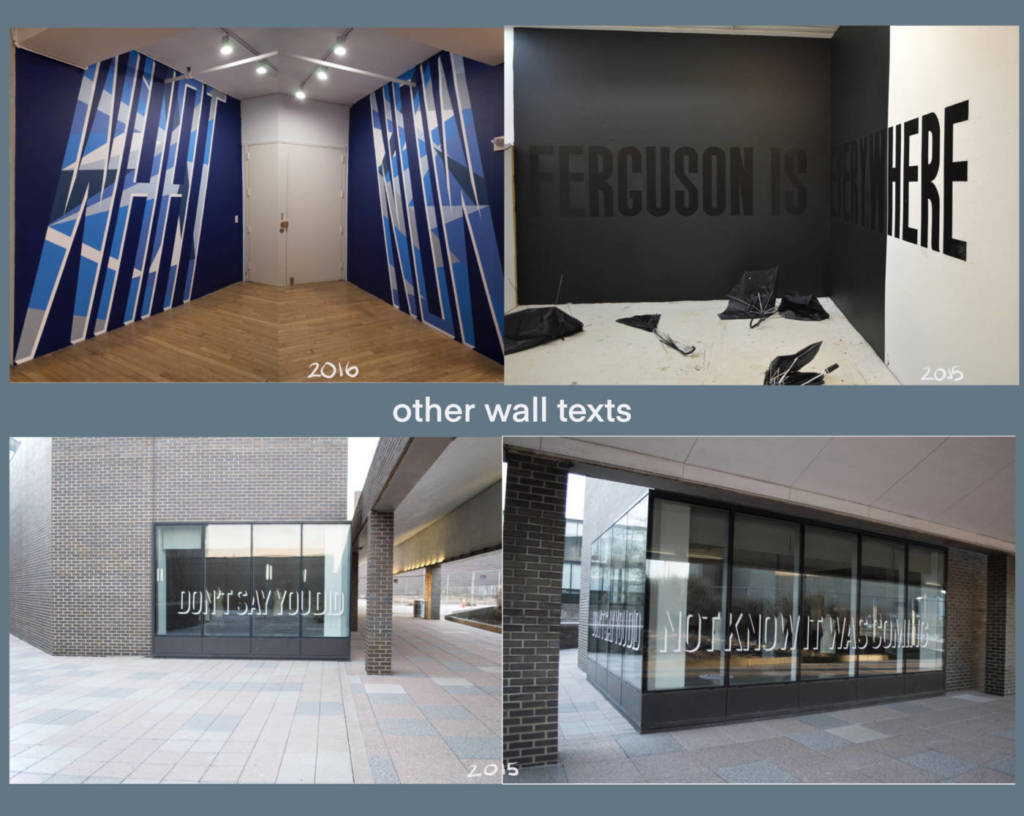
_________
Word Garland
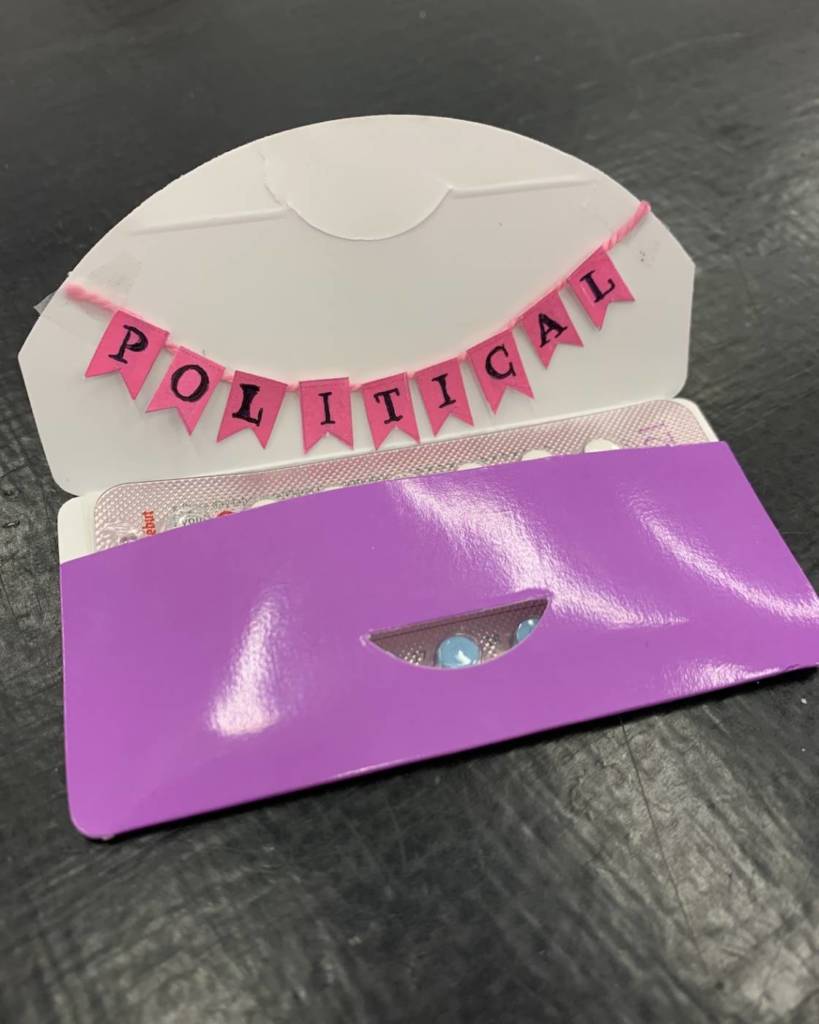
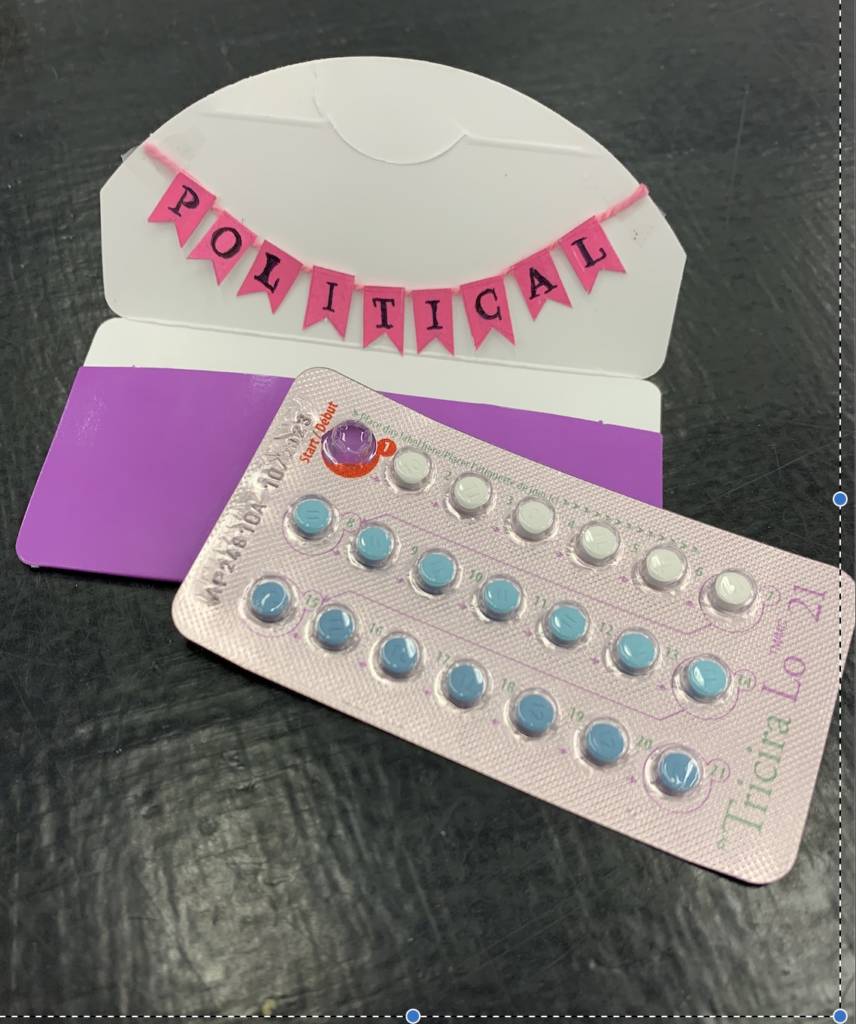
__________
WEEK THREE – VIDEO CULTURE
The use of social media has become an archive of footage we would have otherwise may have not had access too- making the use of uploading and sharing old concert footage one of the engaging branches of internet culture to me. A mix of both commercially produced footage and home footage from the 1970’s – 1990’s (specifically in the genre of metal / heavy metal) a true insight to the bands and culture can be taken rather than just listening to the records. In a way even never experiencing these performances explicitly, there is a connection between the footage and the viewer with this stand still of the performances.
CANDLEMASS (Live in London 1989)
BLACK SABBATH (Live in Paris 1970)
Another branch of videos related to this are videos I found called “Heavy Metal Parking Lot” (produced by MTV) where fans are interviewed and you see a fully diverse crowd in who was drawn to this music.
HEAVY METAL PARKING LOT ONE
____________
INTERNET VIDEO LINK
___________________
PARENT VIDEO:
TATTOO PARTY
I had an extreme amount of fun with this assignment for a final work this semester. As someone considering Tattooing as a future career path, it felt very important for me to not only design creative tattoos but also work within the cliches of that subculture. My final piece I decided to do a series of American-Traditional Tattoo designs which feminist / queer conceptual artists as the subject matter. Tattoos are a heavily male dominated industry and instead of focusing on only the interactions of how the tattoo is on the body, I wanted to explore how the tattoo can actively challenge well-established troupes in the community. I chose American traditional because of it’s heavy gatekeeping with male tattoo artists. Something I have heard in the past is “if its real American Traditional then it has to be done by a guy.” This started the idea for the first piece being focused around Gorilla Girls, and their involvement with the Punk scene alongside feminist punks responding to “girls can’t be punk.”
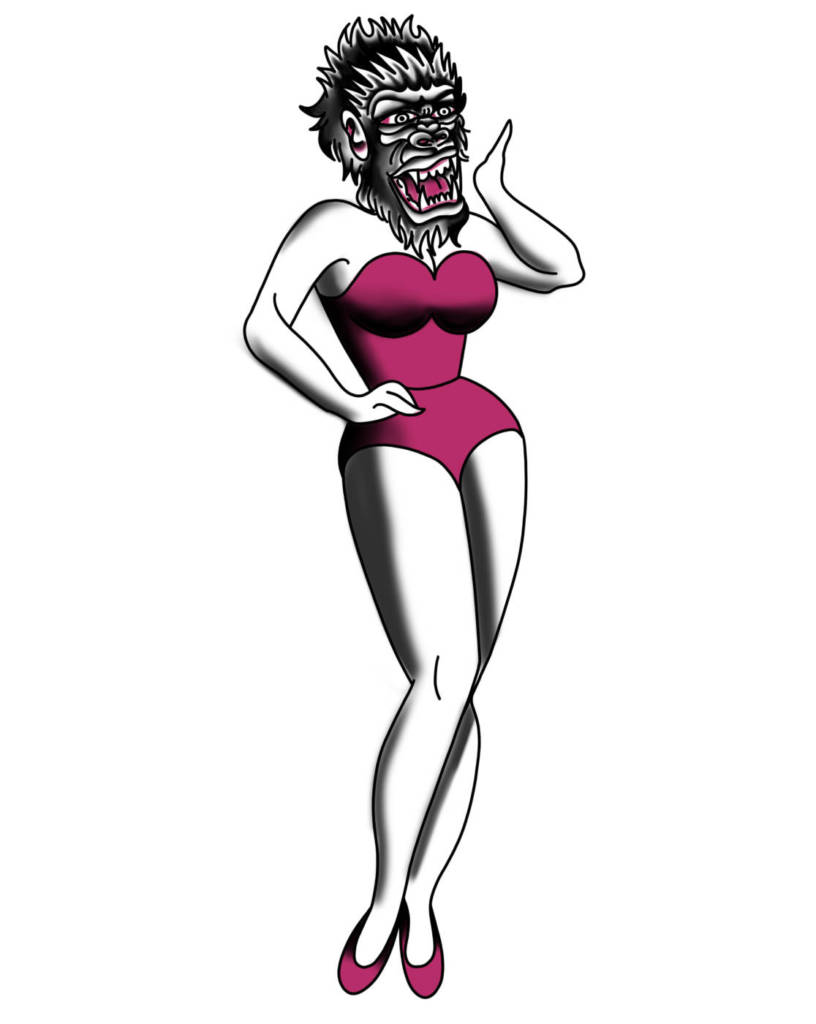
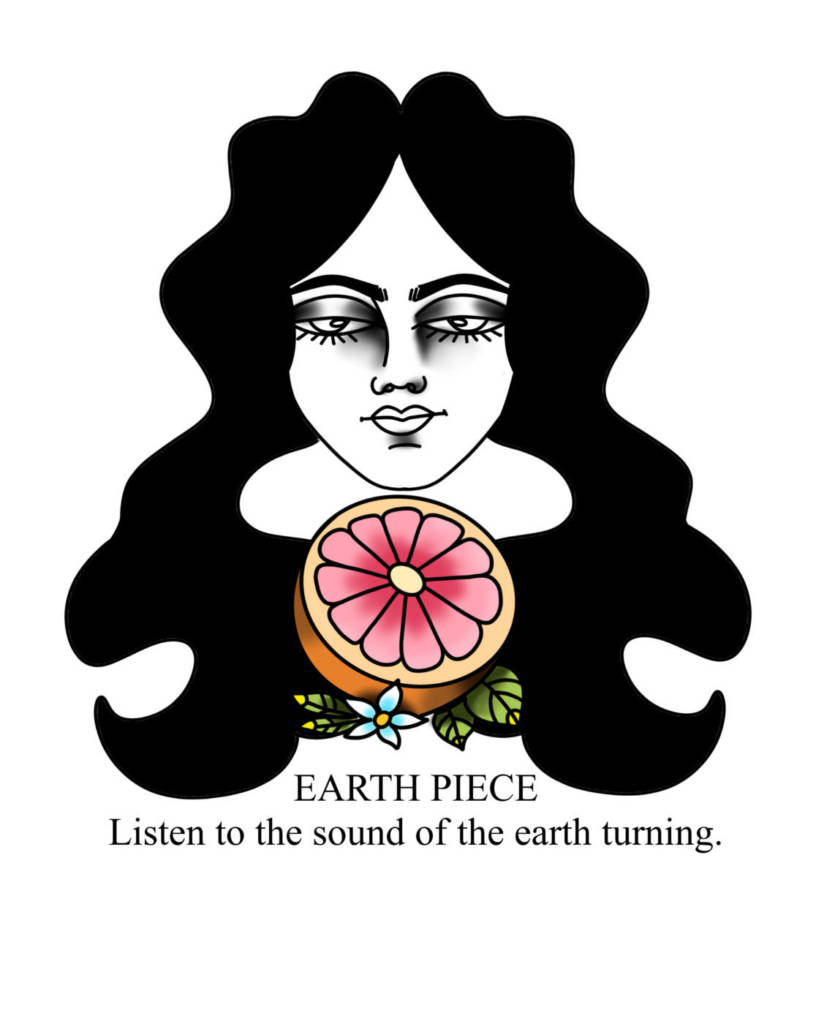
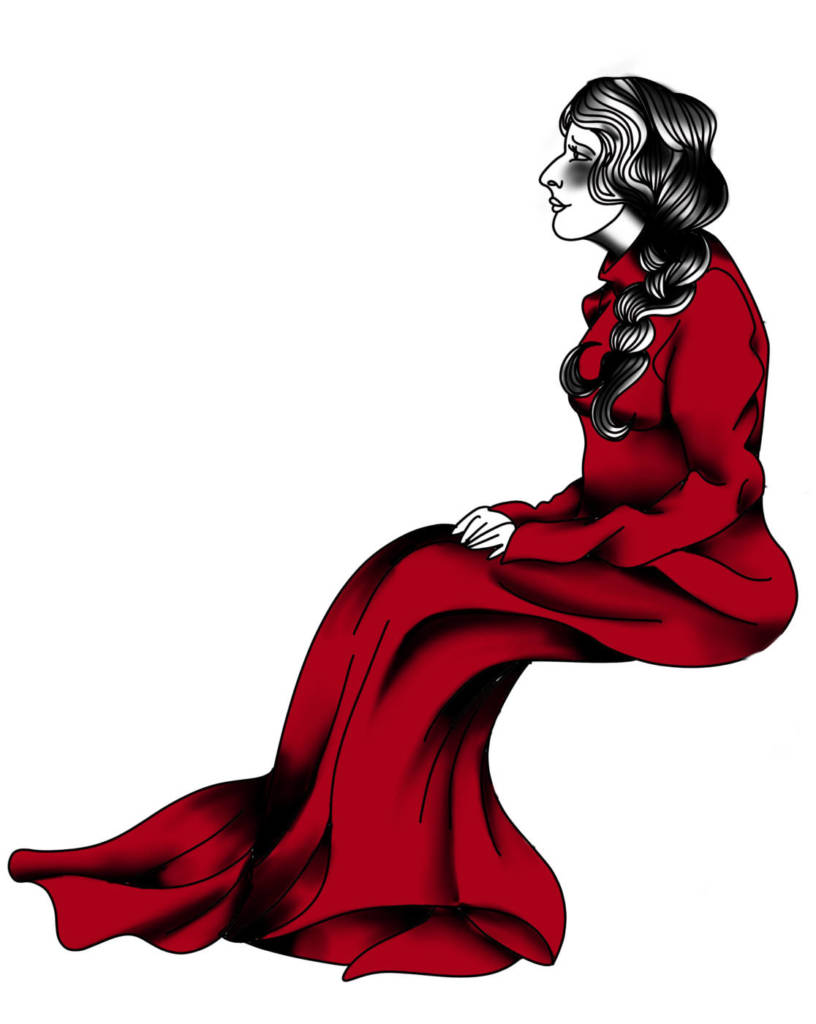
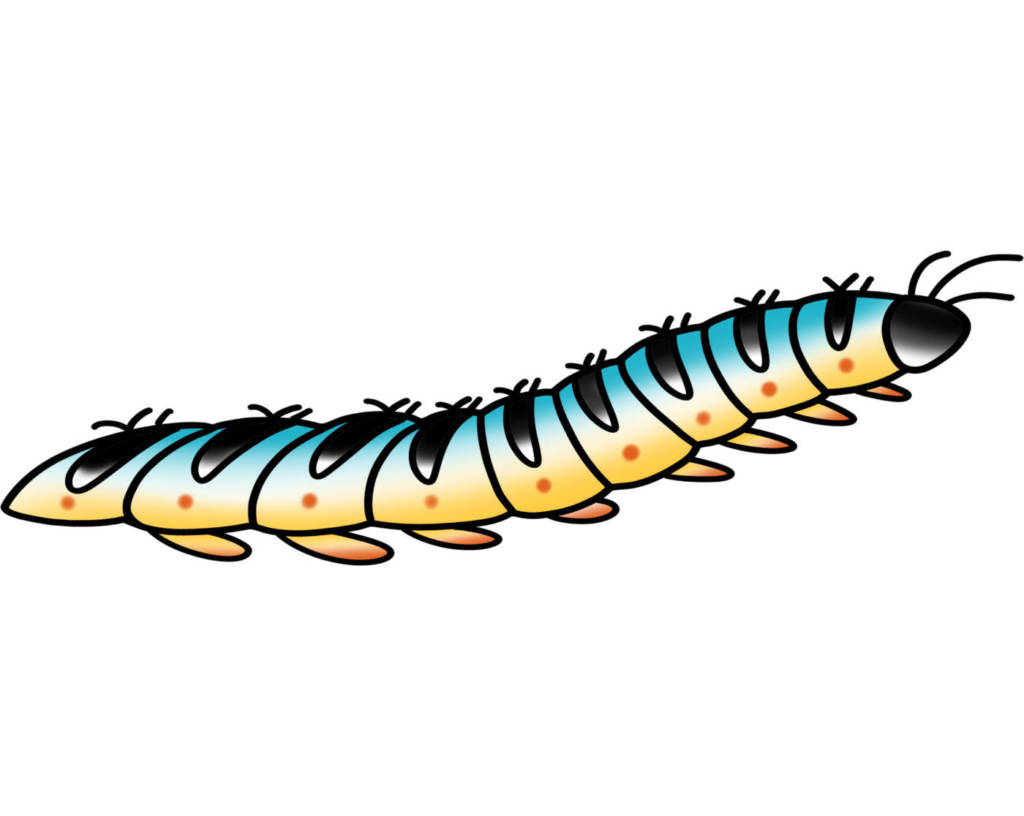
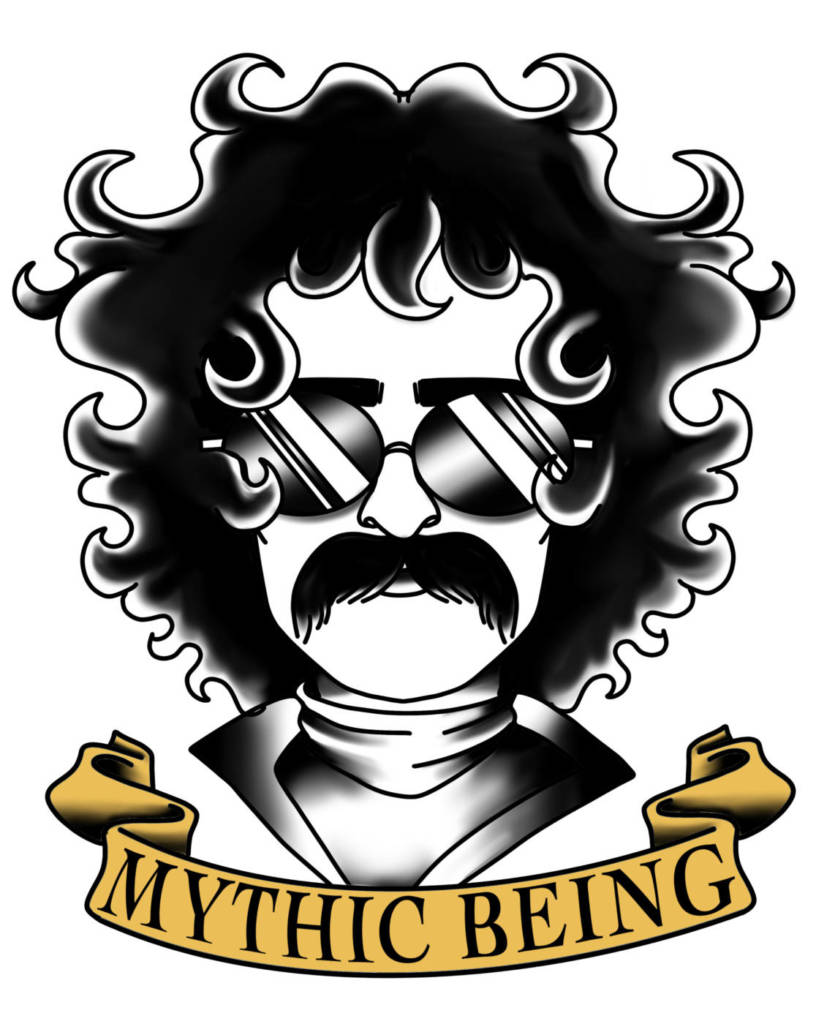
When applied with the body, I wanted to interact with the traditional way of having tattoos in the form of a sleeve. My friend Julianna was the perfect model for these tattoos and allowed me the creative freedom to place them wherever they needed to be. Specifically with the nod to the piece “Nature Drag” and allowing me to place tattoos on their face. I felt very fulfilled with this assignment, especially when people were able to tell me I found my creative language through designing tattoos and helping apply them. Moving forward, I want to expand these ideas into a official tattoo practice and introduce the art of tattooing into a more academic environment next year in my studio classes.
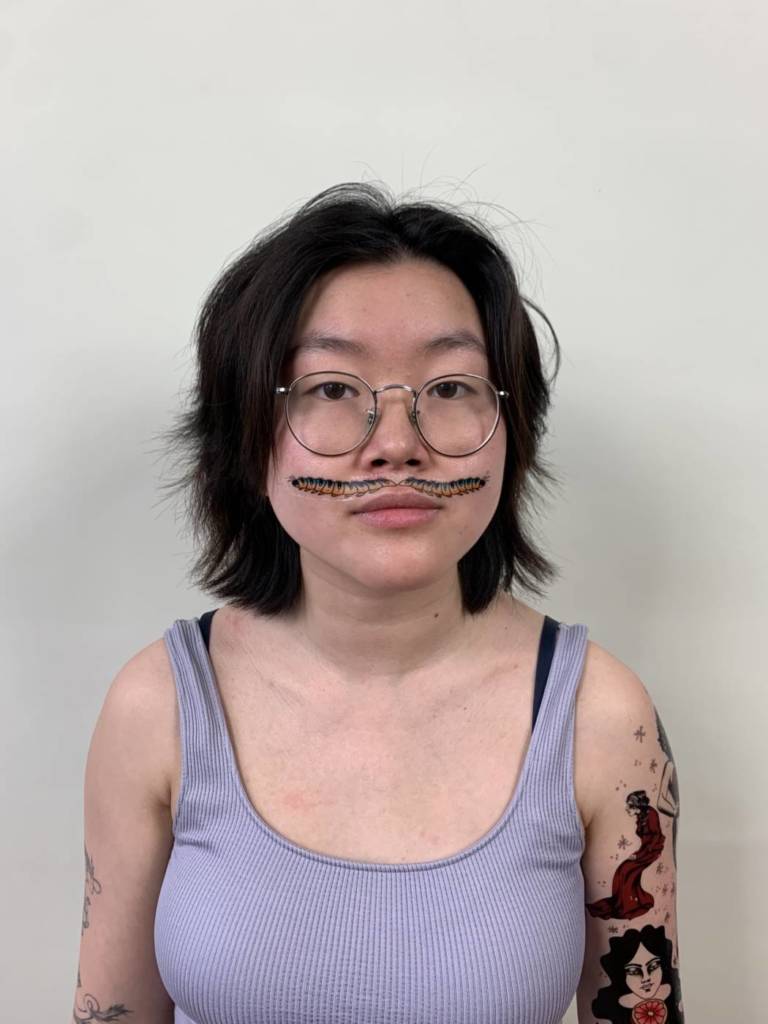
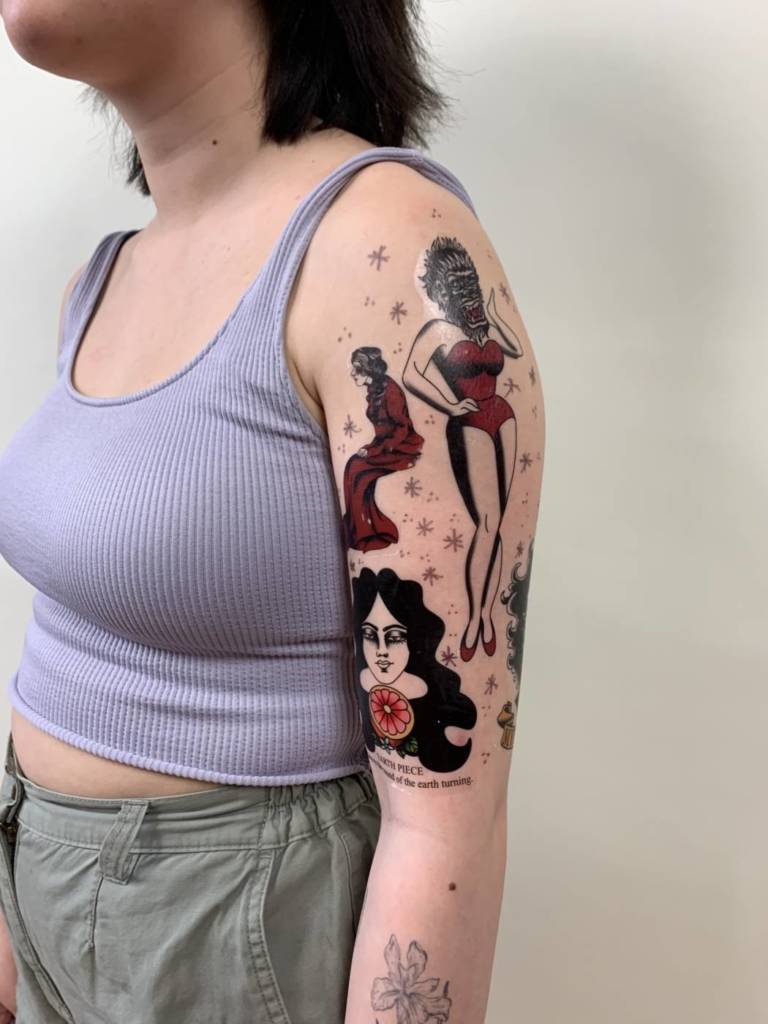
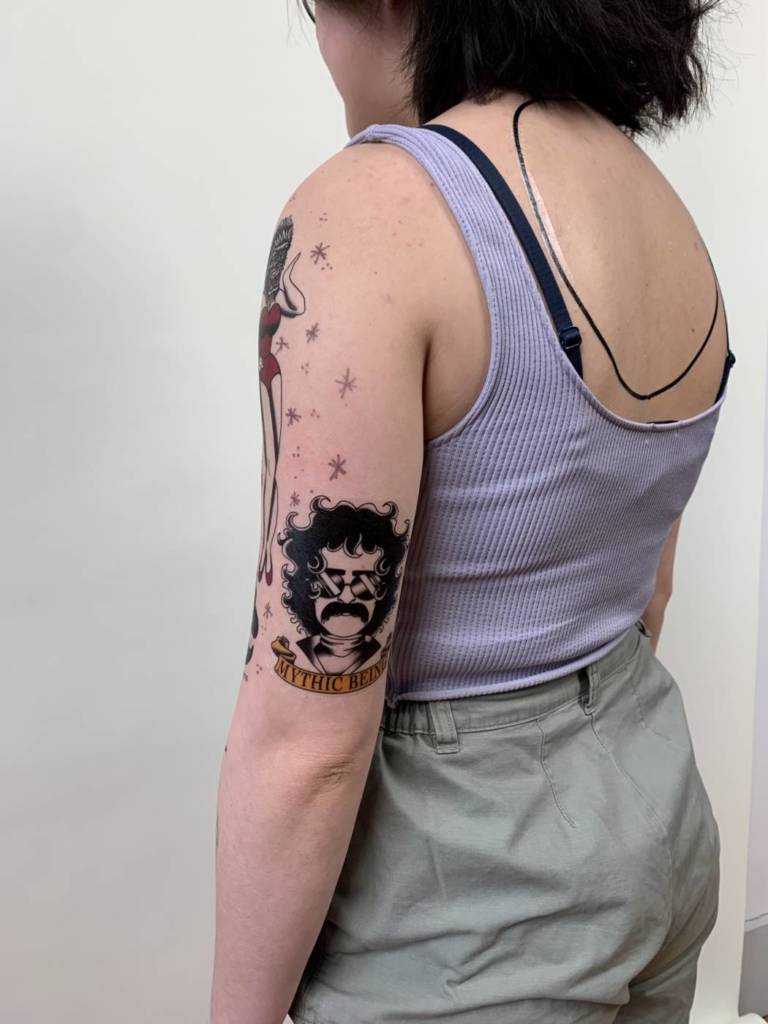
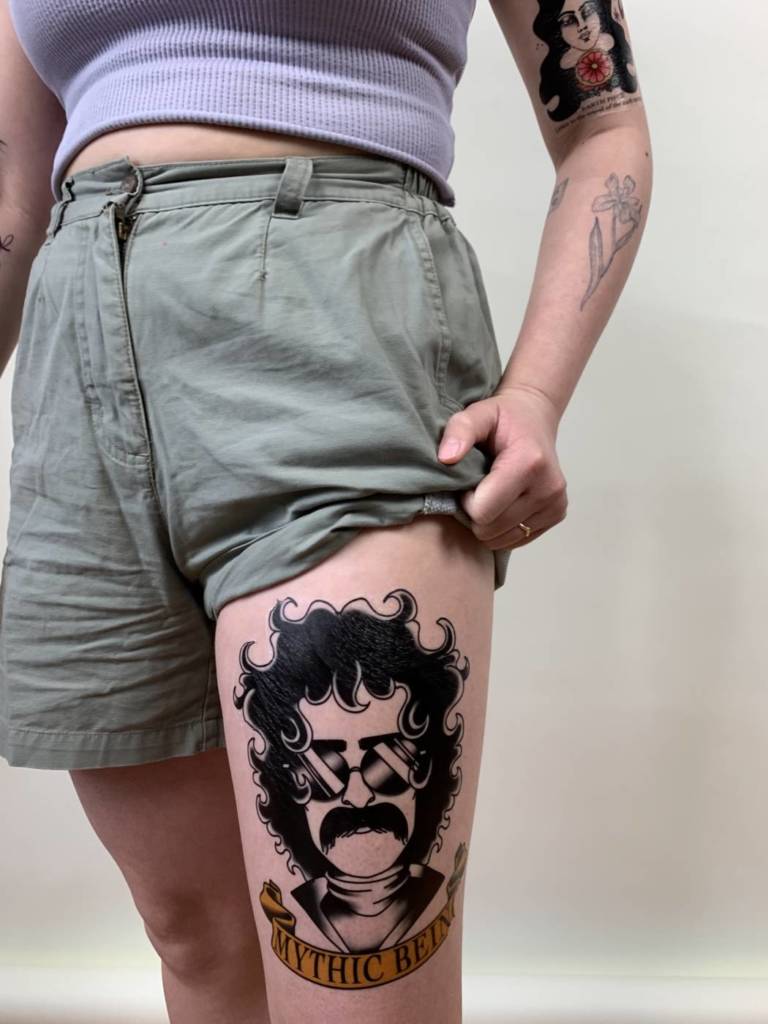
MacKenzie
WEEK 1 – Shelley Niro – The Shirt
A five-minute performative documentary that subtly highlights the injustices inflicted upon Indigenous Peoples in the form of souvenir T-shirt slogans
Shelley Niro is a multidisciplinary artist born in Niagara Falls, New York. She was born in 1954 and grew up on the Six Nations of the Grand River Reserve, near Brantford, Ontario. She is known for her work that challenges cliches and stereotypes surrounding Indigenous communities, specifically women, while reinforcing the consequences of colonial history.
She has produced films and digital collages addressing land, border, treaties issues and women
The Shirt (2003) was produced in response to a trip Niro took to Houston Texas. While on the plane for a photography conference she recalls looking out the window at the divided plains below her and was reminded of the complex histories that have happened on the land that is so clearly divided for ownership.
In the film, Shelley uses the natural landscape as her background as the frames progress with individuals appearing and disappearing. The film shows the progression of the shirt and its text as it changes, and is literally taken from the woman’s back, as a metaphor for what Indigenous peoples have been left with as a result of colonialism.
It is described as “an amalgamation of her determination to challenge the stereotypes against Indigenous Peoples in a single, powerful work”. It confronts the viewer with the question “What do you really know about colonialism”
The firm message is delivered subtly, but effectively as it reframes the relationship between land-ownership and Indigenous peoples and their self-determination.
The film was presented at the 2003 Venice Biennal as well as at the 2004 Sundance Film Festival in Park City, Utah.
Banner Project!
“Cool Detached Attitude”
My banner is made of coloured felt and string, and I chose the phrase “Cool Detached Attitude” from the reading. I think the position of the banner in the studio is a funny as we create and critique projects in this room that make us feel anything but cool and detached. I decided to represent that struggle of recievcing criticism and pretending to not care as much as you actually do. In my mind this is quite funny! but also very real. It serves as a reminder that we are only students, only people, and trying to remain cool, and detached is not always possible. Things will make us emotional in many ways and hiding that is not always beneficial to our well-being. Why not be way too involved? why not care too much? There is not anything wrong with caring about your work, and trying to be cool and detached does not yield the appearance we often think it does. I really like colourful, whimsical decor, and I think that pairing that with a silly kind of phrase or idea reinforces that it is a reminder to try and relax, to not care about what other people think, and to open yourself to help and collaboration. Screw a cool detached attitude!
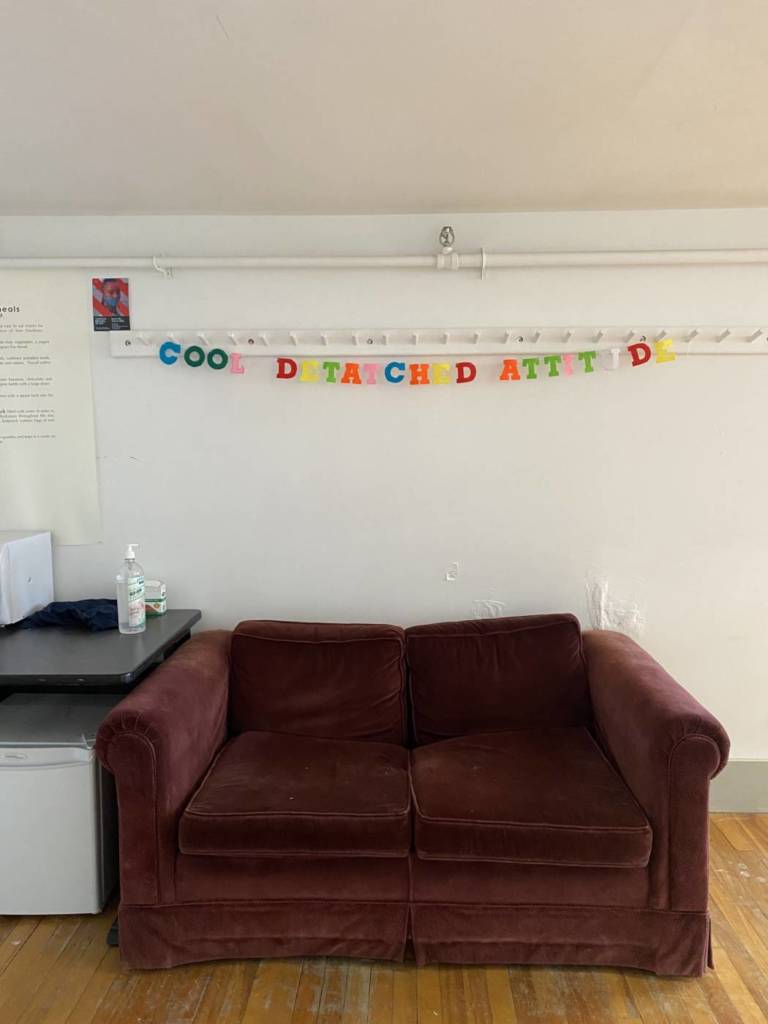
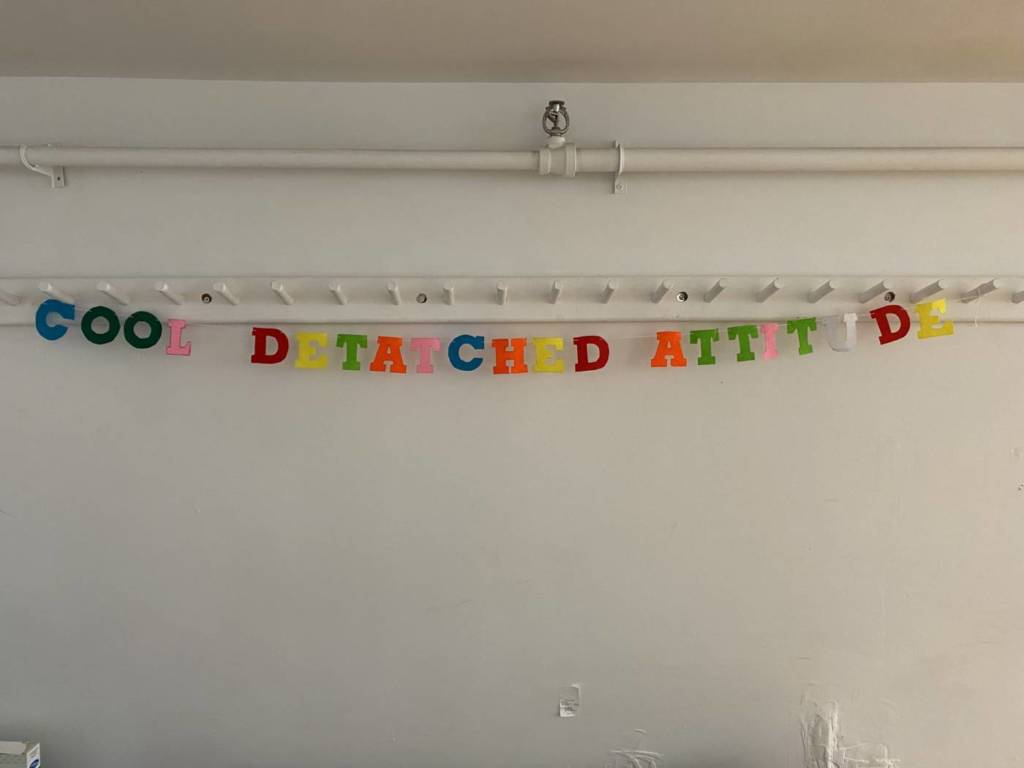
Internet Topic Presentation (Pre-Video Research)
An Analysis of “Clean Girl Makeup”
Before discussing all I have learned about this topic, I believe it is worth saying that makeup and beauty as well as the trends that come and go are all controlled by forces larger than the average shopper. Most of what we consume has been marketed to us in many ways and the world of marketing is always using new methods of advertising to influence the average shopper. So, though not all beauty trends are inherently negative, we must remember that our participation in said trends is not always an independent choice. Makeup and fashion are important art forms and are creative outlets for millions of people. It is not about whether or not you look the part of a trend, it is about enjoying the privilege of decorating your body. It is never about looking “good “ or “bad”, but this mindset can quickly be adopted. It can be harmful to discuss beauty trends when allowing people to enjoy what they like is what should really be the point of all this. However, the world of visual culture inevitably attaches certain values and caricatures to the way things look and for that reason a second look should be given to trends that take the online world by storm. Many of these trends perpetuate harmful stereotypes, habits of over-consumption or feelings of unattainable beauty, when in reality your worth should never be determined by the way you look. Your inner light and precious mind are what make you amazing, not what products you purchase.
With all that said, let’s talk about “The Clean Girl Aesthetic”! Unlike many trends that quickly come and go on Tiktok, this trend has become a long term character in the beauty landscape. Often characterized by neatly slicked back ponytails/buns, minimalistic neutral fashion, and “clean” looking glossy skin, this “clean girl” is the goal of many for beauty and fashion. Many of these attributes have existed for a very long time in the heritage of Black and Brown women, but have since been adapted for Euro-centric beauty features. It has also become ways of behaving, eating, dressing, even decorating ones home. This trend and its virality have been adopted by many beauty and fashion brands that now market products as a staple in achieving this aesthetic. This then becomes a class issue, we have adopted trends of beauty from cultures and now it has become a discussion surrounding consumption, where spending money on specific products is also essential to this lifestyle. This may be hard to wrap your head around, I say this because personally it is difficult to critique things loved by many or that simply allow women to enjoy themselves or bond on common interests. I ask myself if this is a discussion about misogyny because of this, but perhaps it is not. When women become excluded by factors they cannot change, their natural body, their level of wealth or race, a trend becomes harmful. If not everyone can participate “correctly” because of their true self it becomes an exclusive club where members look down on those who try to join, but fail.
This “clean girl aesthetic” is arguably a repackaged version of many trends that have existed before, ones that center themselves around wealthy, thin white women with access to resources and products most do not. I find it interesting that a trend that really centers itself around a “clean” and fresh look, that suggests little makeup and simply clothing does not “work” with textured skin or larger bodies. Is that not the “cleanest” version of the body? Natural beauty? Additionally the language surrounding this trend is harmful, the use of the word “clean” implies that there is a “dirty”. Words like minimal would be better to describe something that is highly curated.
In a chapter titled “Mapping Gross Bodies: The Regulatory Politics of Disgust” from Aesthetic Labour, writer Breanne Fahs explains that women “described feeling burdened with the task of managing unruly bodies, maintaining ‘appropriate’ standards of cleanliness, hairlessness, and thinness, and hoping that they would not offend or otherwise step outside of the boundaries of appropriate bodies.”
“As Western minimalist and elitist propaganda send signals of calling no-makeup makeup looks clean, it carries the connotation that grandiose measures of beauty, experimental glam, and cultural signifiers are dirty.”
“The concealment of labor and exertion externalizes that the no-makeup makeup looks we’ve been doing is a method to disguise looks of stress related to poverty, illness, or the failure to suppress the body’s natural secretion.”
(https://i-d.vice.com/en/article/epzna7/tiktok-clean-girl-aesthetic)
Reflection on trends that have so many questions surrounding the fairness of these ideas and the true meaning of these terms is very important. The wealth of the body and its capabilities do not lie in how it looks and how that look conforms with trends, especially when that trend is about selective features, hidden labour, and the exclusion of the originators of specific hairstyles, jewelry etc… It is also important to mention that when critiquing things like this, that we check our misogyny. All too often do people see conversations like this as an opportunity to tear women down based on the way they look and act when in reality most women do not knowingly contribute to these problems, they are merely consuming what they are being told to and happen to be enjoying themselves. This issue lies in the exclusive nature and the habit of classifying specific features as bad and undesirable. We must remember women deserve to enjoy themselves without being ridiculed and observed. Especially when social media encourages observation and judgment.


Week 5 – Post-Internet Video Art
ASMR Fidget Toy Sensory Extravaganza!
For this project I wanted to analyze something that I really like. I have been interested in ASMR for almost a decade and I really have come to love collecting fidget toys. Fidget toys are often meant to ease mental stress through their fun nature and the sensory elements (things that click, squish, slide etc…). They can be really beneficial to kid who have issues focusing in educational spaces or calming kids who have difficult time in social situations. I think they are really important and they have been around longer than some people realize. Stim toys refers to “stimming” which they are often called and refers to physically actions that ease or satisfy the body for people with sensory issues, autism, anxiety etc… I discovered these because I really like toys. I think it is that simple, I just like collecting things that tie me back to the joy of being little. I also have been on a quest to manage my anxiety and panic disorder as I have gotten older, embracing things I like and allowing myself to enjoy them has been big for me and these toys are a part of that. they just so happen to be great for the senses.
ASMR has always helped me relax and often focus when I am working, I feel fortunate to enjoy it because for some people it can be very unsettling. Additionally, the stigma surround these videos that is often based in fetish and intimacy has been more normalized as I think some people on the internet know how important it is for people to simply enjoy what they enjoy. The crossover realm of videos about these toys is so interesting. There are ones where people unbox them and review them, one where people simply play with them recording the noice and visuals, some people role play with them (role play is common in ASMR) videos! It is a really interesting genre of videos.
I chose to clip bits with sensitive audio and good visual to maximize the hypnotizing element. I adjusted the sound and surrounded the loudest clips with others that gradually introduce an increase in volume. I made some of these editing choices to keep they viewer in the audio visual experience. I went through a lot of source content because these videos are usually 30 minutes or more, and I feel like the presentation would definitely include surround sound audio to highlight the in-ear feeling these videos have when you wear headphones.
The ideal installation I think would be a large projection in a dark room with surround sound audio to deeply intense audio. I think that the concept of multiple screens might be nice but I don’t know that my intention is to overwhelm to viewer. Perhaps multiple videos would have their own sets of headphones but all be projected on different walls of the same room. I think I would have to make a firm decision regarding the intent of the piece to either go the overstimulating way and subvert the purpose of these relaxing videos or to embrace it and create an environment that nurtures a comfortable feeling and encourages the viewer to stay and relax for as long as they would like. I think creating an auditory environment would be super cool!
Parent Video
This assignment was very hard for me. For context, I was raising in a single-parent household. I was very fortunate is a lot of ways! I was loved and fed, had amazing pets, and a parent who did their absolute best to keep me happy and healthy. I don’t think I could have asked for much more. With that said, there were some not so nice parts too. My mom passed away when I was 11 and I was very lucky to have the it me with her that I did. But when I look back, all I really have now is that time. I am an only child, with a very small family, who are not very close to each other, so I have spent a lot of time imagining my future, and a family I have not yet built. I think a lot of things would have been different if I had a mom, and siblings, but to wish things were different is wasted time. I have many things to be grateful for. My own company being a large one.
When I was trying to generate an idea for this project, I was drawing a blank. I didn’t have a fun way to document my parents or something to have them do. No genealogy to trace or ancestry to look for. I don’t know a lot about them or where I come from. I am fortunately and unfortunately very independent and some times I am my only family. So I decided to make a video about me and what I do have. I don’t have any heirlooms from my mom. No jewelry, or knickknacks, or letters, just nothing, just the time I can remember and have to fight to keep fresh in my mind. So I thought why not document this? These photos are about the only objects I have in memory with her, these physical depictions of memories. It’s a small collection, one where we look happy, where we are holding each other. In the video I take time to remember these moments and to assess the state of the photos, after a couple decades they have started to show some wear. I also am taking the time to meditate on these objects, they are filled with life and I have no other evidence of it. Lastly, I spend time trying to find my likeness in her. My body and mind are the last thing that exists in memory of her. My genetic make up and facial features are proof that she did exist even though sometimes it does not feel that way. This video is a way of spending time with her and using the body and brain she created.
Now I know this is all quite sad. And I did want to avoid that, I don’t like feeling pitied by other people, but I also don’t want to not answer the questions about her. So, just enjoy this video as a daughter spending time with her mother the only way she can.
Bella
tattoos

For my tattoos, I had 2 projects I was working with.
The first is a part of my ongoing topic of being a young person diagnosed with “invisible diseases”. I am diagnosed with IBD and liver diseases. The main liver disease is a degenerative disease which means eventually, sooner rather than later, I’ll have to get a liver transplant for a new “lease on life” as this rare disease comes with a life expectancy. As an artist I have a unique way to communicate and teach the community about these diseases in a way that a student in a STEM program may not be able to.
My first tattoo project utilized this outlet as I had people fill out forms to get their “diagnoses” from me.







On this form, one of the questions was to correctly define IBS and IBD. Not one person correctly named both of these medical problems. In fact, some people left that question completely blank. I was then able to teach them the names during their tattoo “session” with me. It also allowed an opening for a conversation on what it was like being a person diagnosed with these.
FOR REFERENCE: IBS = IRRITABLE BOWEL SYNDROME and IBD = INFLAMMATORY BOWEL DISEASE
For my tattoos of diagnoses, I took sentences from my actual medical forms and had them covering my stomach. Even just having the first sentence from paragraphs on my forms was enough to make people ask and wonder and be generally taken aback by my own diagnoses.
I chose a smaller font so that people would be forced to look, as well as the exact font used on my forms to give it a more accurate look.
My idea grew quite a bit, as originally I knew I wanted to play with an invisible disease but was toying with the idea of labeling oneself and having my tattoos say “I HAVE CROHNS DISEASE” and “I HAVE LIVER DISEASE” whereas most everyone else’s would read “I DO NOT HAVE CROHNS DISEASE” and “I DO NOT HAVE LIVER DISEASE”. I’m glad I was pushed to take a more introspective look at the conversation the tattoos would be having on the body and how they would interact with the wearer and the people around them.




My second project didn’t have as much deep conceptual meaning, but it was near and dear to my heart in a different way. I am a gatekeeper at heart. I like what I like very passionately it is visceral and aggressive and I become protective and sometimes even a little mean about it. Specifically Wes Anderson. Now I KNOW many people love him, as they should, they just don’t love him as much as I do. At least that’s what I have to tell myself. Is this unhealthy? Maybe. But I’ve found ways around it. I keep him just for me and I just can’t have people talk to me about him. This has been a problem as of late though because he’s released a trailer for his new film Asteroid City and since everyone knows how much I love him, people have been trying to talk to me about it. It has been driving me insane. So I took matters into my own hands and created “DON’T TALK TO ME ABOUT ___________” tattoos.
Now MINE said, “DON’T TALK TO ME ABOUT WES ANDERSON”-

-but everyone else had a blank line that I had to fill in for them. Ironically, forcing them to talk about what they didn’t want to talk about. I chose to look at this with a gatekeeping lens, however, some people chose to use topics they simply didn’t want to talk about. I enjoyed the different perspectives, as some people are healthier and do not gatekeep as aggressively as me. Sadly, I think I could cover my whole body with “DONT TALK TO ME ABOUT _________” tattoos. I also loved how these tattoos worked out in the world. I wore mine to work the next two days and its funny to see people’s reactions and sometimes even their attempts to talk about exactly what my body was telling them to NOT talk to me about.
I brought these tattoos to other classes and have continued to put them on people when they ask.









parents video
I chose clips where my parents were talking to us, or in them, or even clips of their parents. Often times the things my mom is saying are things she still says to us even now.
I also created this as a sort of gift for my parents. Since all our home videos are on VHS and our VCR is long dead, having this video is so important for them, in fact, they’ve asked me to make it longer and create an archive for us of the videos on a more accessible technology.
It was really interesting to watch back these old videos at the point in my life I’m at now. I never realized truly how much Hungarian my father spoke to us. They’ve always spoken it around us and Tas and I know the phrase or two that are said around the house, but my dad use to only speak to us in Hungarian, and once I started to talk and talk in English the Hungarian that was spoken directly to Tas and I dropped out a bit.
I know I mentioned wanting to add audio of phone calls over parts of the video, specifically with an interest in bookending it. I still want to, however, I had some problems with DaVinci and also a sad lack of time to have phone calls with my parents and brother.
I think I linked the timeline to the memory stick. and not my laptop? So I’m unable to edit the videos unless I have the memory stick plugged in and the audio files on my desktop. I’m not too sure how that works but to add new audio in I’ll have to completely rework the files, a feat of which I’m not quite at the level to technologically resolve quickly and easily.
This being said, I will continue this project as it does feel a bit unfinished to me still. Nonetheless, I am happy with how the final video turned out for the class.
As I’ve said before, video art is not my forté, nor my interest, so I was content with my abilities in editing and technique and overall finished aesthetic.
Video Art; Terrible ASMR
For my video art I took clips from different ASMR videos and frankensteined them together to create a video that I hope depicts how I feel watching, quote on quote, “good” ASMR.
I don’t enjoy regular ASMR. I don’t get that tingly nice feeling. I get skin crawling I want to die feeling. This video evolved from my original idea of just using terrible sound clips, as I wanted it to appear like ASMR. This meaning, I wanted it to have the regular setup of microphones or POV.
I also included some clips from a popular ASMR eating video to enhance the fever dream esc feel and also edge the audience a little bit, for lack of better terminology.
At some points, there are extra audio clips added in, however, not throughout the entirety of the video, as the silence of the background is a key factor in ASMR. I also played with clip lengths, having some very sporadic and choppy moments and other long periods of video clips.
I hope you enjoy?
Video Art; Research
For my presentation, I wanted to talk about something I actually watch from time to time and it made me realize I have a very boring search history. This is not to say I don’t indulge in youtube videos every once in a while, but I definitely lean more toward television and film if I have the time to sit down at watch something.
This being said, I do tend to click on music-based videos more often than not. I watch a lot of music videos, but these are not as *niche* as some other music-based material. Music videos historically began around 1894 and picked up throughout 1900 to 1940s to the 1960s and so on, as technology improved. In the ’80s MTV began; a unique channel that showcased music videos. MTV was huge and music videos were highly digested. Nowadays it’s less likely that the average person sits down to watch music videos in the same way that they were once consumed.
Focusing on other aspects of a “music” “video” there’s a genre of internet video nowadays where people will listen to and rate an album. One of the youtube channels that does this through youtube is HTHAZE. (I’ve included a video I’ve seen multiple times, however, it is not technically part of my presentation as, since its the whole album, it’s over 40 minutes long)
There are shorter versions of these types of videos that are now appearing on youtube shorts, instagram reels, and tik tok. For example;
Clearly, this “genre” plays with many different features and the thing that threads them all together is that they’re all simply listening to an album. They differ in length, style, framing and quality.
I think historically it’s interested to see this new type of video appear, especially looking into the history of a music video as a whole and understanding that an artist’s creation may not be as popular as it once was. Though artists still come out with music videos and people do watch them from time to time, it’s not like the days of MTV. The consumption rate is not even close to comparable. However these album-rating videos have loads of views; especially the short easily digestible ones, as sen on tik tok and other short-form video apps.
It’s also interesting to note that these videos of music rating are subgenres of a much bigger and overarching genre of just videos that rate things in general.
I’m unsure why this genre is so popular, perhaps because you can truly apply it to anything…and people do.
There are rating videos about people, animal breeds, foods, apology videos (which is a whole other thing…), couples, thirst traps, products, outfits, chess openings and everything under the sun.
Every once in a while a trend pops up in line with this genre, most recently a huge video genre was the “tier list” videos, wherein people would create a tier list which titles of their choosing and place miscellaneous things within them.
The tier list videos also range in length; from 30 seconds, to 15 minutes, to 45 to an hour.
Videos in this genre are an umbrella to almost every other genre, as rating things can be applied to literally everything.
*If we focus once again on the first video and the idea of “recapping” an album for an audience so they don’t have to listen and form their own opinions. This is a genre in itself. There are recap videos for a myriad of shows and movies and they seem to be increasing in popularity as well.
It makes more sense to recap a 15-season show than a 60-minute album to me, but this being said, I watch the album ones and not the shows so basically I’m a huge hypocrite.
the internet is weird.
Make your own GARLAND BANNER
*UPDATED PHOTOS*




I’m really glad I reshot Performance Driven. Not only are the photos in higher quality, but they were also shot in a better light, which overall documents the piece in a more successful way. I also played with some different posing, which was really fun and I ended up with some images that I love!
*The blog did seem to lessen the quality*

The excerpt I ended up choosing from “Dirty Words” by Tammer El Sheik was ‘performance driven’. The entire quote this excerpt is from is “; the zany is associated with emotional labour and the performance driven conditions of the workplace;”. I have to be honest, when reading the article both originally and thinking about highlighted ideas afterward, I was simply reading the words rather than consuming them, so the sentence that this excerpt is a part of played no role in what I decided to do.
I had many ideas going into this, but I knew I wanted to use the foil letters from a HAPPY BIRTHDAY sign for that happy and bright celebratory look. What I did not think about beforehand was that HAPPY BIRTHDAY only includes a finite number of letters, which lead me to do some frankensteining while creating my final piece.
Some of my other ideas included a wide array of works, including putting “our disinterested engagement” up in the library, or “activities of consuming” above the dinner table. Some were even more literal/illiteral, like hanging “glass of milk” on the alternative milk fridge at the grocery store.
I ended up choosing “performance driven” hung above my bed because frankly, it makes me laugh. I wanted to hang it above a bed because I wanted the initial thought process to be as if I was labeling myself as a performance driven individual when it comes to sex. Though this is an important view of the piece, in the final photo of it in the space I wanted to have my laptop open on the bed, as I use my bed for much more than just sex. My bed also acts as a study area a lot of the time, as I don’t really have a desk in my main space. Because of this, labeling myself as performance driven also opens me up to a vulnerability beyond sex and into a sense of self. I cannot count the number of times I’ve been told to “not worry so much” when it comes to grades or to art-making. When I sit to work on my laptop, I’m sat right between the dips of the words, as shown in the photo below.

“Performance driven” can be read as a positive or a negative. When it comes to work and grades being performance driven can be a good thing, but it plays as my fault. In sexual innuendos of performance driven this banner opens a whole new can of worms, as that can not only be negative or positive; But also plays into the idea that the sexual content via pop culture that I am fed shows unrealistic ideals of how a woman partner should be during heterosexual sex, squeing “performance driven” in a new way. This could then infer that whomevers bed it hangs above is not being genuine in their sexual experiences, but rather, being driven to give a “good” “performance”, though that performance may be false.
Using Text As Art
“Joi T. Arcand is an artist from Muskeg Lake Cree Nation, Saskatchewan, Treaty 6 territory, currently residing in Ottawa, Ontario” (joitarcand.com/bio) Arcand is an artist who works in photography and graphic design and has been “characterized by a visionary and subversive reclamation and INdigenization of public spaces through the use of Cree language and syllabics”
Arcand works with her personal connection to language and creates pieces to present, not only her own relationship with the nēhiyawēwin language but also the language as a whole, visible to the public.
Her recent text works use neon signs to illuminate and highlight the language in a way not seen before.



The images above are from Arcand’s solo exhibition in 2019 she used to want to be a ballerina. This exhibition highlights Arcand’s childhood dreams of becoming a ballerina and, as with many of her other works, toys with the energy between Western and Indigenous elements.





Above are pieces from the 2017 project wayfinding wherein Arcand works with themes of “old school tagging” and the ancient art of wayfinding. An article in “BackFlash” highlights the theme and idea that “wayfinding has been described as being both a process of calculating one’s position in time-space by estimating distances traveled, and of being deeply attuned, watching signs and visualizing what lies ahead…we should all be watching for signs to understand the direction she’s motioning us towards”. I believe there is also something to be said about the connection wayfinding has with the earth, as it shares the inherent connection that many Indigenous tribes have with the land, once again reminding us of Arcand’s indigeneity. This project included both neon signs, as well as, installations in public spaces, merging two of Joi T. Arcand’s practices together.
Below, from her series Here on Future Earth; Northern Pawn, South Vietnam, and Amber Motors (both 2019), depict more of Arcand’s works out in the public eye, rather than in an exhibition space. “The two sentences come from words spoken by Joi T. Arcand’s mentors, offering contradictory descriptions of Arcand’s ‘authenticity’ as a Cree woman and as a second-language learner of Nēhiyawēwin.” (https://www.mercerunion.org/exhibitions/space-joi-t-arcand/) Arcand’s works join the ongoing fight to recover languages that are lost, or becoming lost, as language is an integral part of cultural identity.
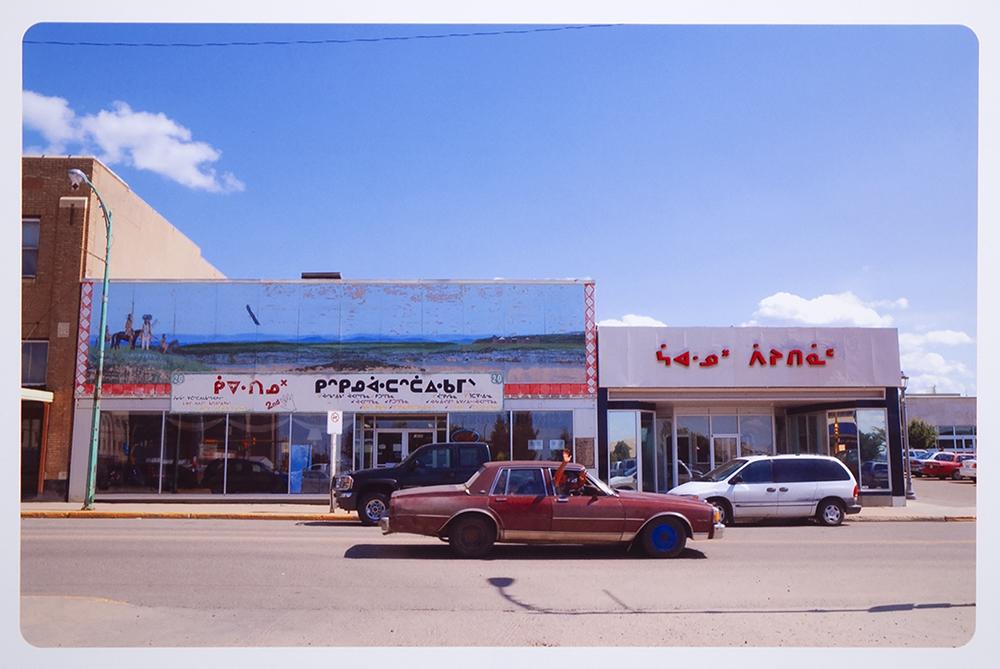

Joi T. Arcand continually provides viewers with thought-provoking pieces and opens doors that people may have not even realized were right in front of them. Her connection to her sense of self and her life as an Indigenous person tackles the reclamation of Cree language and syllabics as well as indigenizing public spaces through visionary concepts.
Samantha
Seemed To Her/Deeply Conflicted
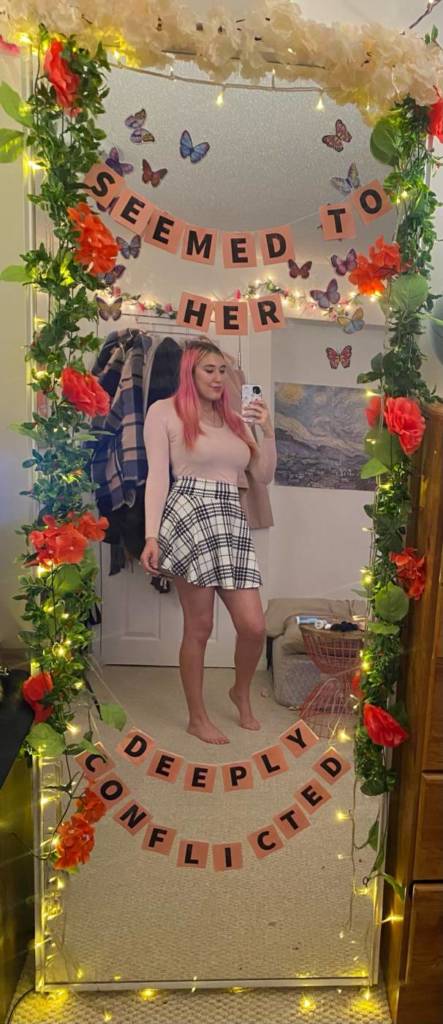
I wanted both of these phrases, seemed to her and deeply conflicted, to be a pair, but not read as one sentence. This piece is about how I see myself. “Seemed To Her” is about how my perception of myself is subjective, biased, and not always accurate. It is also about how my eating disorder totally skews my perception of myself. “Deeply Conflicted” is also about how I see myself too, I feel like I often have conflicted feelings about myself because of my mental illness, and me doing everything I can to be kind to myself and love myself. I chose to take a selfie and put an image of myself right between these two phrases because the way I see myself most is through this mirror, and just to drive home the point that this work is about self-reflection, and maybe that I’m a little vain. This mirror has also been in my room since I was fourteen, so it has been with me through the entirety of my eating disorder and obsession with my weight and how I look.
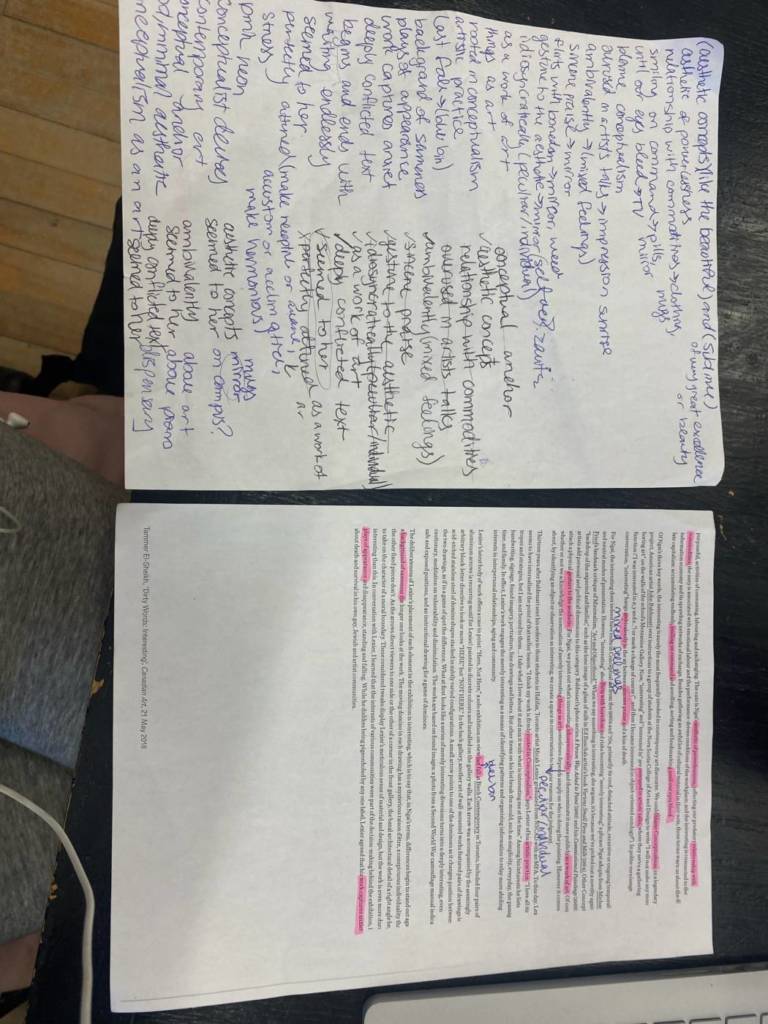
r/sweatypalms
r/holdmyredbull
r/nextfuckinglevel
r/nextfuckinglevelmoron
There are a lot of similar subreddits, and these four have the kind of videos I want to use in my project. These videos are of people doing reckless stunts and recording it. I personally find these videos so dumb, these people are risking their lives for something meaningless. I was thinking for my project I could take parts of these videos right before they land the stunt, and edit them together. This would hopefully create a strong feeling of unease, and make the viewer feel like their stomach is continually dropping.
This is my final video for this assignment. I decided to do two videos together so they could speak to each other. I tried to pair videos that complemented each other. Personally I think these kind of stunt videos are stupid, and I kind of judge the people taking risks for clout or adrenaline, and I wanted to highlight that in this project. Not all of them are fails, because I wanted to be there some uncertainty to what would happen, like it is when people do these stunts in real life.
Alexia
ARTIST RESEARCH
I will not make any more boring art, 1971, John Baldessari
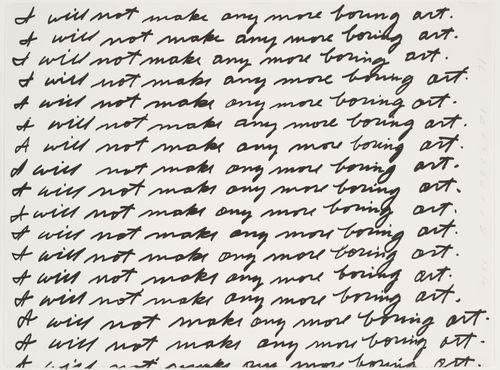
John Baldessari is a contemporary Canadian artist of the mid to late 20th century. One of his most noteworthy artworks is titled I Will Not Make Any More Boring Art. As seen in the image below, the artwork consists of the handwritten statement “I will not make any more boring art.” Written over and over again, alluding to grade school punishment. This work exists in many different forms including prints, wallpaper, video, as well as performance/installation.
The performance was the original format of this artwork, executed in 1971. The Nova Scotia College of Art and Design, Halifax, had invited Baldessari to showcase his work. His initial intention for this work was for him to come to the gallery and write “I will not make any more boring art” over and over in columns all along the gallery walls from ceiling to floor. However, Baldessari was unable make it to the gallery in Halifax. As a solution, he asked his students to stand in and perform for him. I feel that this makes the work more effective because the act of writing a sentence many times in a row is reminiscent of being punished in grade school. So, by making his students write these lines, he is following this grade school punishment narrative.
This artwork is ironic because it presents the same mundane words over and over again. Typically, something that looks like this would be considered “boring art.” But the commentary that this artwork is making is the complete opposite of boring. It’s attention grabbing and very much tongue in cheek. The irony and the gentle mischief of this artwork is what makes this piece the opposite of “boring art.” Baldessari came up with the concept for this work with the intention of pointing out the faults of the art education system of the time. He felt that schools encouraged students to imitate art rather than to experiment and innovate. This artwork rejects the constraints of traditional art of the 70s.
BANNER
Sign, Don’t Be Shy
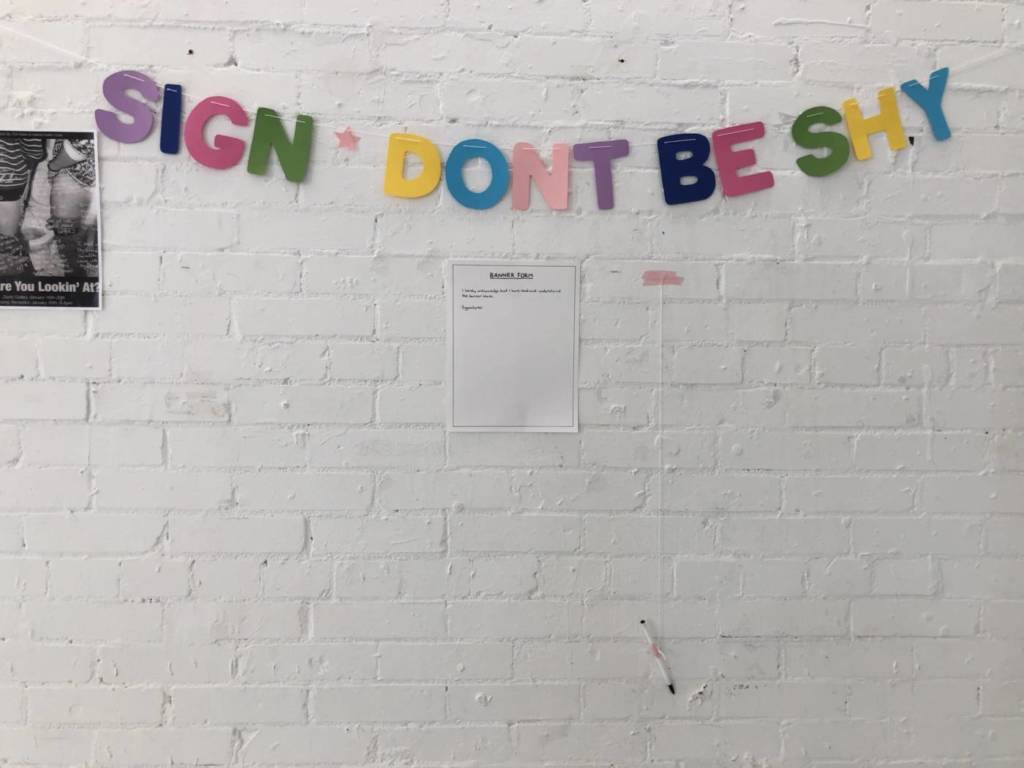
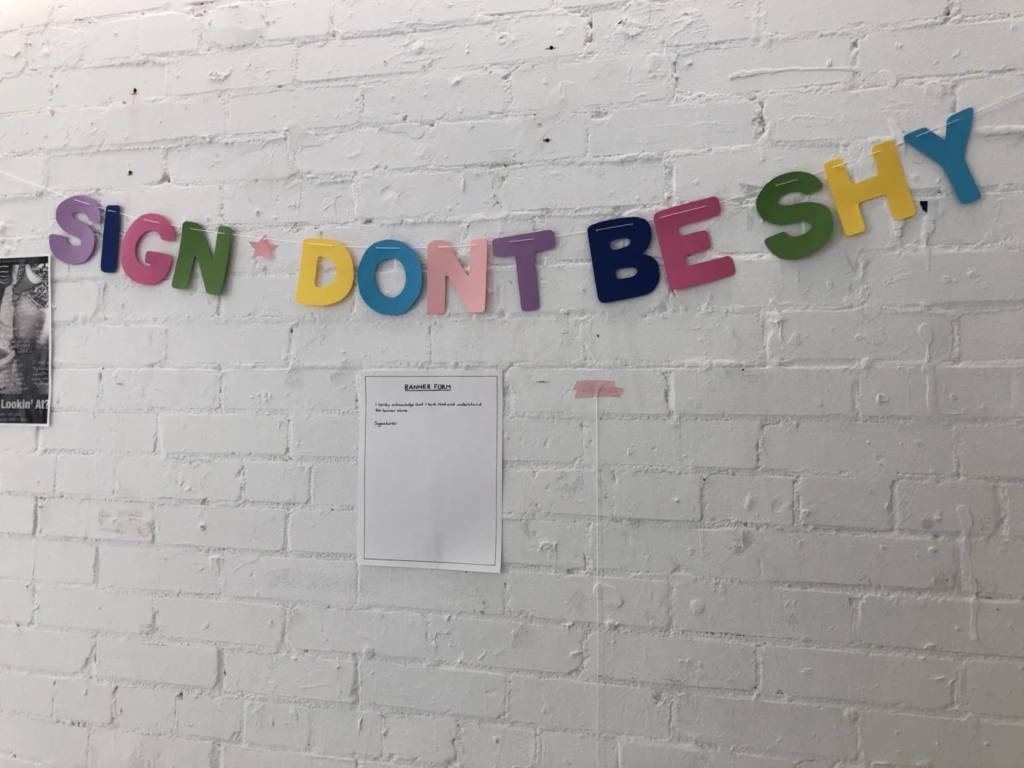
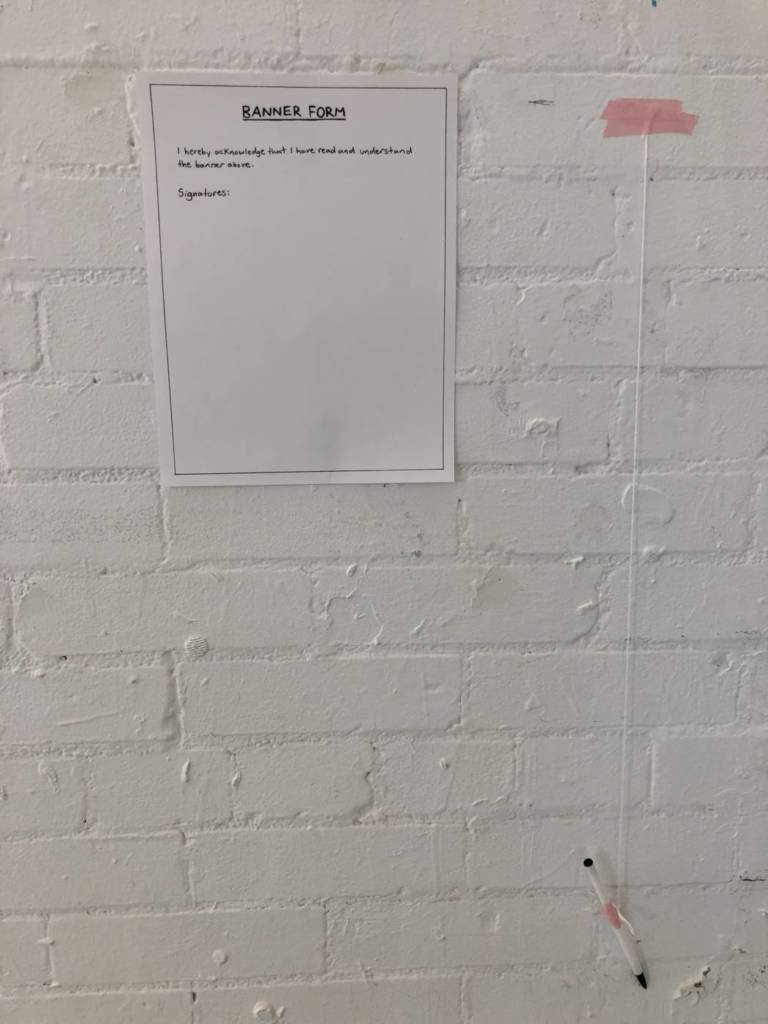
For this piece I chose the phrase “Sign, don’t be shy.” I wanted this piece to involve the public, which is why I chose a segment of the text that seemed instructional. I decided to put this piece in the entrance to Zavitz. Underneath the banner, I posted a white piece of paper that says “I hereby acknowledge that I have read and understand the banner above,” prompting the public to interact with the artwork and sign the the “form.” I chose to write this particular sentence on the paper because I wanted to create something humours and playful. I also wanted to explore the concept of art that acknowledges itself. I chose a multicoloured and playful look for this banner because the words themselves are harsh and commanding. I didn’t want people to take it too seriously so that they would be comfortable enough to sign their name on the form.
VIDEO ART
Brainstorm
The trope that I chose for this project is people posting their kids on the internet and using them for content. There are often trends that involve humiliating kids or making kids upset or just posting kids on the internet having a tantrum for the purpose of collecting views and likes. Below is a video compilation of children having tantrums on the internet.
I don’t think that it’s ethical to be using children’s misery for content. Using this for content is essentially disregarding the fact that children’s emotions are real and should be validated. There seems to be this widespread belief that it’s okay to treat children poorly because they “won’t remember it when they’re older anyways.” Although they may not remember these memories specifically, the events that take place during childhood are the ones that will shape them and affect them the most.
I want to create a video that makes people uncomfortable and changes their perspectives on these posts that the internet calls “funny.” I want to frame these posts in a way that will make people realize the absurdity of this trope.
In Progress
The video above contains two of my ideas that are in progress. The first minute and 15 seconds or so, I have compiled short segments of clips that show children having tantrums, but I specifically chose to include segments of these clips that do not contain enough context to inform the viewer why the child is crying. I was hoping by doing this to take out the humour from these clips and make the viewer feel sad for these children. However, After watching it back I am not convinced that it has this effect. Instead it sounds whiny and I am concerned that it will remind my audience of when a baby is crying on a plane.The second part of this video contains the same clips but even shorter segments. I believe this is more effective than the first idea, however I am not sure if it is too fast paced and does not allow the audience to take in each clip.
Smile for the camera!
For my final, I overlapped all of the clips and displayed them side by side. By overlapping all of the clips, I am allowing my audience to move through each one at a steady pace, while also striping the videos of their humour. I wanted to focus on the cruelty of the parents. I wanted to show the unethical aspect of filming and posting your child on the internet during their most vulnerable moments. I made sure to include some of the parents dialogue to further emphasize this. In the video you can hear some parents laughing at their children or mocking their cries. One parent even says to their child “you are so dramatic!” I wanted to highlight the absurdity of the common parenting choices of this generation. My vision is to have this play on a loop, possibly in a stairwell. I want this video to be displayed in a space where the audience would have no choice but to walk past it and endure the discomfort of hearing the cries of these poor children.
PARENTS VIDEO
In-Progress 1
For this work, I want to honour my parents. Whenever I watch my home videos, I notice that my parents are never in them, because they are the ones behind the camera. This is especially true of my dad. I have chosen to use a home video that my family and I still talk about and laugh at to this day. It is a video of me singing my ABCs with a toy microphone and my dad accompanying me on the piano. This video holds emotional value to me as well, because music has become a shared passion between my dad and I. In this video I want to explore the concept of giving back to my parent what they gave to me. To do so, I have recreated the video that I mentioned above, but my dad and I swapped roles, so that this time he gets a chance to be in the spotlight.
Above is a rough draft of my work. To highlight how precisely my dad and I recited each line, I decided to edit the videos so that they go back and forth between the original and the recreation after each phrase. I feel that this helped to emphasize the parallel between the two videos and it allows the viewers to take it in step by step. Furthermore, I attempted to use an old camera that I had at home to replicate the grainy texture on the original video. I had also attempted to recreate the dim basement lighting that was in the original. However, this resulted in a poor quality video with bad lighting and it did not have the effect I wanted it to. In my next attempt, I will try proper lighting and a newer camera. The difference in quality of the original video compared to the newer video may help to show the concept of “then versus now,” as technology has changed a lot since then.
Dad and Me ABC (In-Progress 2)
Above is the version of my video after I reshot it (the version I showed to the class for critique). Because it was filmed in a basement where there is no natural sunlight, it was really difficult to set up proper lighting. The video came out looking very orange.
Now I Know My ABCs
In this final version, I was able to edit the video in order to balance the oranges and the blues in the picture. I have also retitled the video to Now I Know My ABCs. I feel that this title playfully uses the lyrics of the alphabet song to acknowledge how I have grown up and how time has passed.
TATTOOS
Brainstorm
For this assignment, I want to use idioms and turn them into tattoos. These tattoos will represent the meaning of an idiom in a literal sense. For example, a tattoo that says “on the nose” be placed on a person’s nose, or a tattoo of butterflies placed on a person’s stomach to reference the phrase “having butterflies in my stomach” (2nd slide). I also created a series that refers to idioms that have to do with colours and body parts (1st slide). Some other miscellaneous ideas include:
- Having tattoos that label your hands (or other body parts) as left and right (3rd slide)
- Punctuation tattoos, possibly on someone’s forehead to indicate what they are thinking / how they are feeling (4th slide)
- Zippers, buttons, and stitches (5th slide)
Final
Below are my final tattoo sheets that I printed. In this project, I wanted to explore the relationship between the body and the tattoo, and how the body can complete an artwork. Each of these tattoos humorously work in conversation with the body.
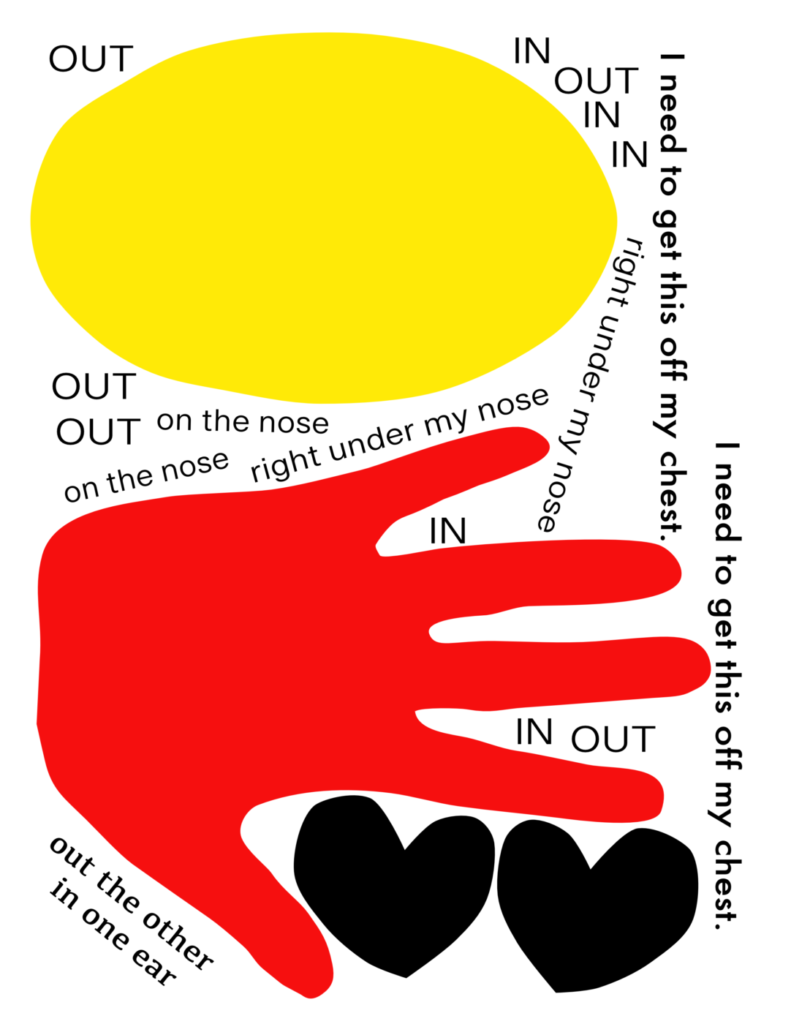
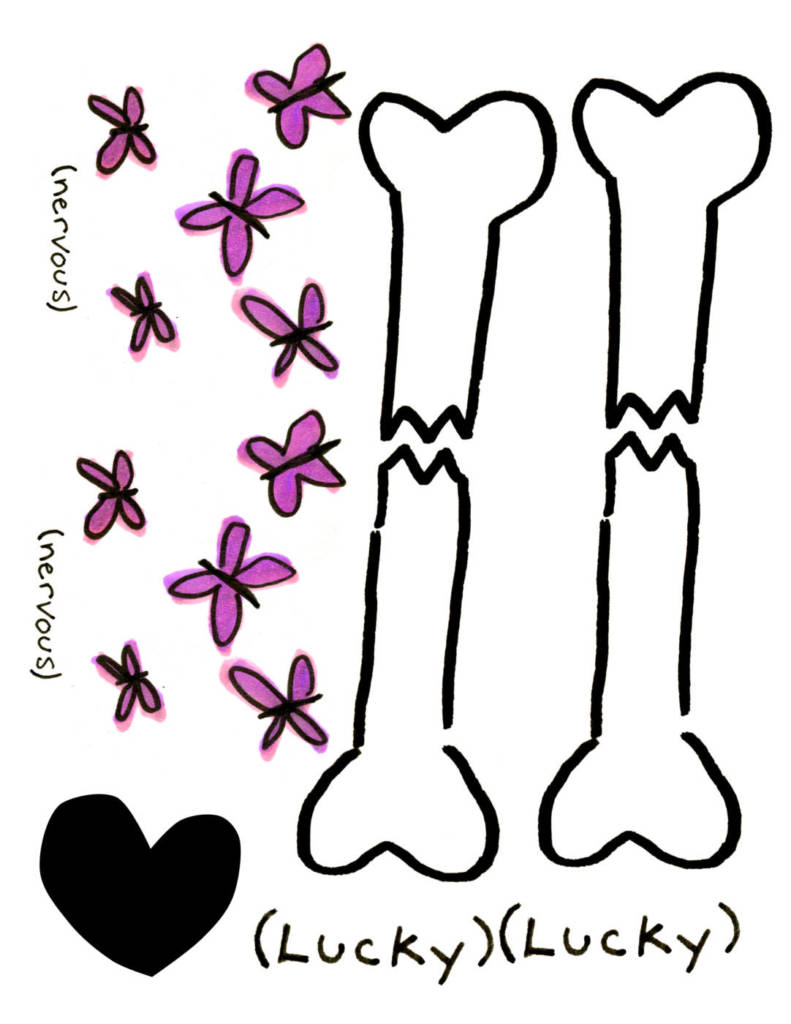
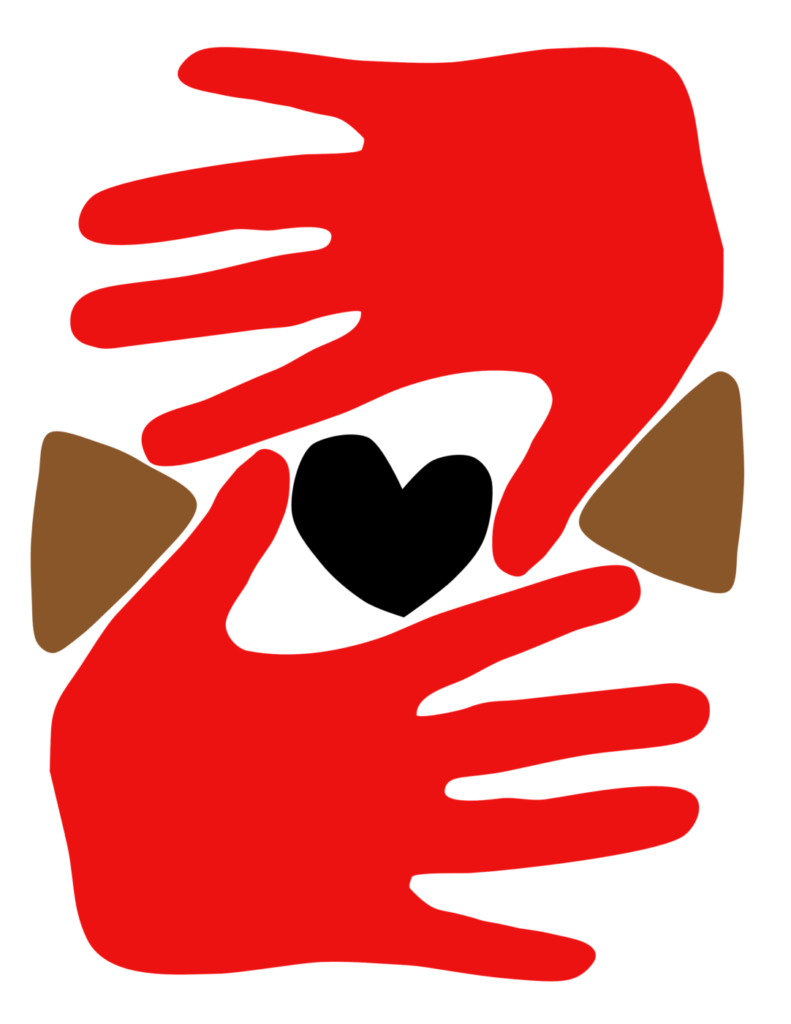
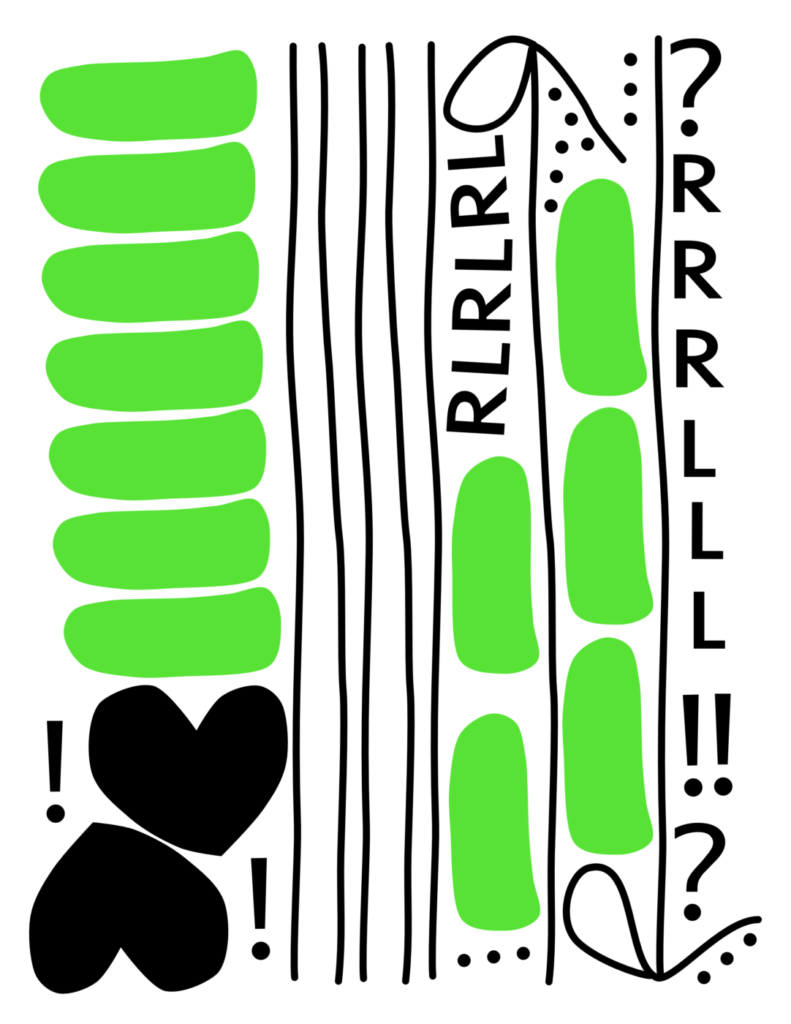
Tattoo Party!
Below are some of my tattoos on people’s bodies from the tattoo party!
Sophia
Week One:
Wednesday, 11th January, 2023
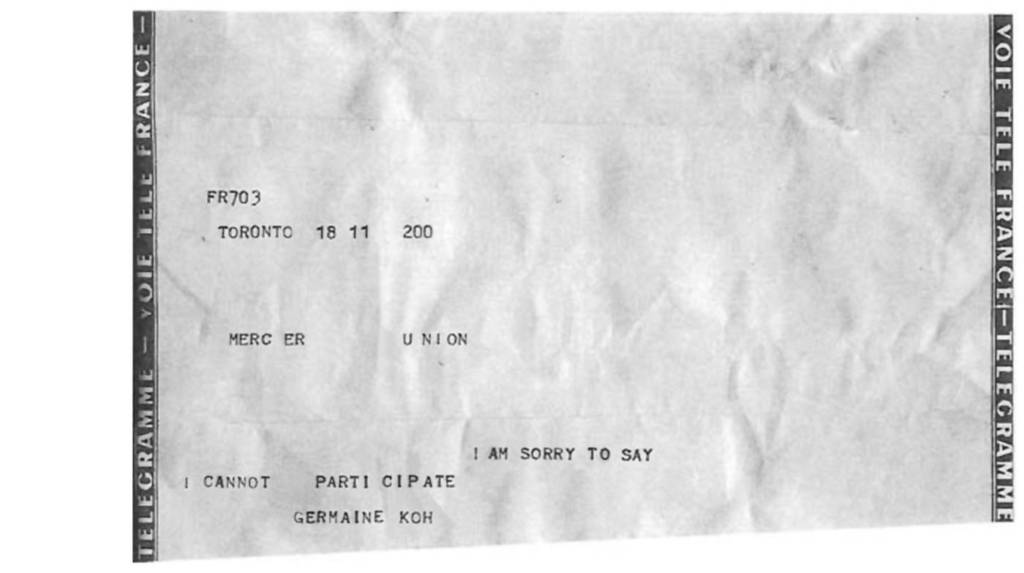
‘Dear: a printed letter used as my participation in fundraising events, which is a rearrangement of Robert Rauschenberg’s telegram “This Is a Portrait of Iris Clert If I Say So”. ‘
– Germaine Koh. A written passage on her website about the multiple, ‘Dear (Mercer)’.
‘Dear’ is quite mundane at first glance. If one were to skim through a pile of documents, unless familiar with Koh’s work, the printed letter would more than likely be taken at face value. It is addressed to Mercer Union with a simple statement beneath. I was initially taken aback when researching ‘Dear’ because of the lack of information and description surrounding it, but what Koh wrote on her website perfectly sums up the meaning of the work.
My friend Celeste and I discussed conceptual art today during our weekly lunch. Both of us battle with conceptual art but simultaneously yearn for it. We concluded, that to create and understand conceptual art, it is crucial to find acceptance in both absurdness and simplicity. As artists, when we unearth forgotten or spur-of-the-moment happenings in our daily lives, we are left appreciating and better understanding the world. Germaine Koh utilizes these ideas within her works, using something as simple as a letter to dip into the conceptual narrative.

This letter acts as an homage to the artist, Robert Rauschenberg, and his telegram piece: “This Is a Portrait of Iris Clert If I Say So”. ‘Dear’ is quite literally constructed by rearranging the letters of Rauschenberg’s telegram and utilizing his bold narratives that dissolve the ideal presentation of art.
Context is everything when reading Koh’s piece. In his telegram to someone by the name of Iris Clert, Robert Rauschenberg confidently declares that the letter being received is a portrait of Iris Clert- simply because he says so. Though traditionally, a portrait must be portrayed through visual or communicative descriptions and representations, Rauschenberg challenges and dismantles our preconceived understanding of what a portrait is. Confident artists can create reality in their delusions. I strive to do the same.
Though Koh’s basic formula is like Rauschenberg’s in’ Dear’, I find that the allusion lies within her description of the piece. While the content of the statement is a swift declaration of not being able to participate in the fundraising events, she simultaneously claims to use sending the letter as her participation in the fundraising events. Though the communicational aspect claims one thing, the action of sending the letter has claimed the exact opposite. I find the irony very cheeky.
Rauschenberg declares participation within an art realm that would not be associated with such a statement- while Koh’s declaration avoids participation while technically doing the thing she declares to be avoiding. The meaning of the definition they use challenges what is occurring.
I was immediately reminded of a piece I had learned about previously, where a pencil-drawn portrait of an artist is erased by another- but the title claims to be the same portrait. A quick google search provided me with the name: Rauschenberg. No wonder his style was so familiar. The piece is called ‘Erased de Kooning Drawing’ from 1953.
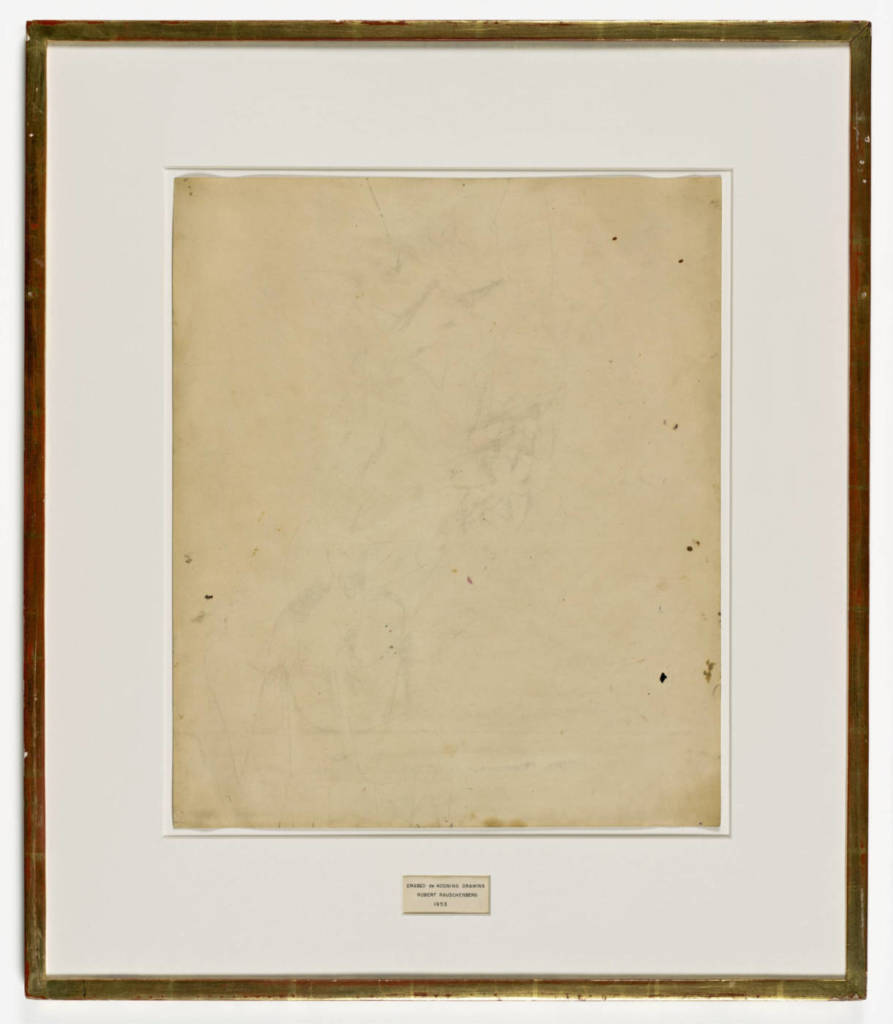
Week Two:
Monday, January 16th, 2023
Banner: ‘Predatory’
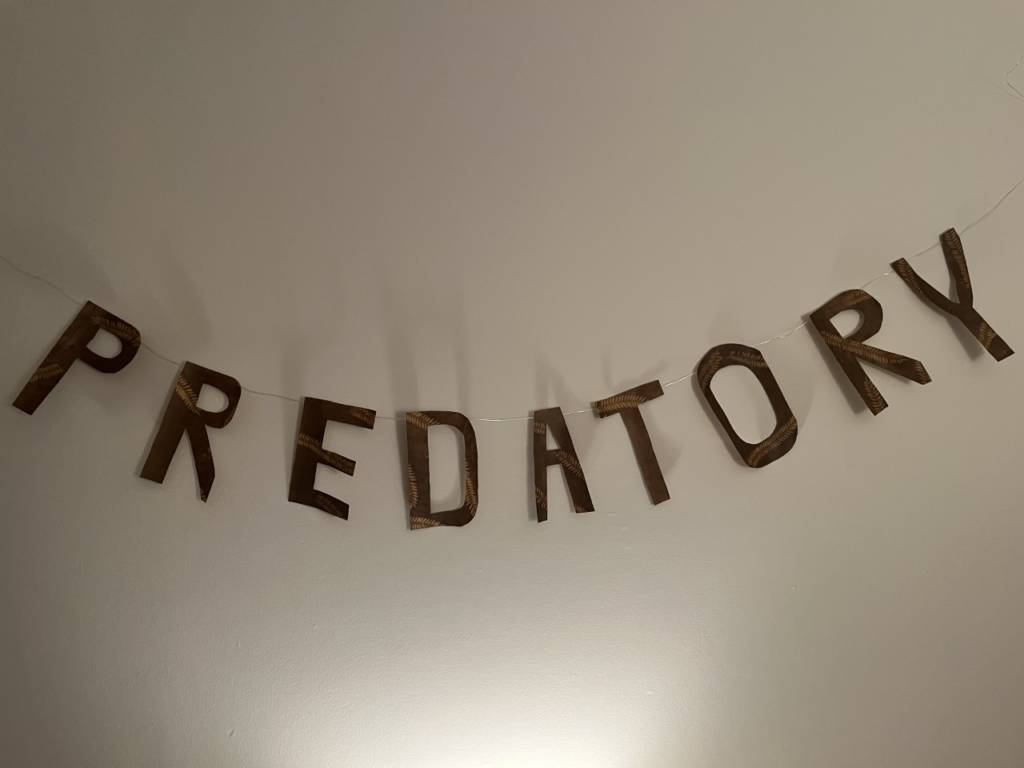
I did not struggle to decide which phrase I would display on the banner from this reading. ‘Predatory’ audibly sounds simplistic, but there is a plethora of meanings this word can possess. I measured the paper into 10 equal parts, deciding on the 9 pieces that fit each letter depending on the size and leaf-print placement. I drew the letters, cut them, and strung each letter onto a metal wire to spell out the word ‘Predatory’.
‘Predatory’ in context to the reading is ‘the predatory relationship with commodities- ‘, which speaks about the colonialist nature of capitalism from an Indigenous Futurist perspective. I decided to leave the word on its own due to the many other things that are attached to it. This word has stuck with me like a parasite for my entire life. It is a shapeshifter- it takes on many forms from the pasts of me and my ancestry. Not that I or my family are predatory in nature- we often act more as the prey.
‘Predatory’ stems from some of the most basic behaviors in animals- hunting another living being for nutrients. This word has a variety of implications now, with more emotional or technological strings attached, such as manipulation for personal gain, or, as mentioned, destruction for commodification. Thus, I decided to use the beautiful leaf paper to symbolize the root of predatory behaviors: nature- and the wire to symbolize the newfound attachment that the word has towards industrialization and civilization today.
As consumers our senses are pumped with capitalist tactics, which convince us that our worth is determined by how much our income equals. The poor are dehumanized and stripped of their basic needs, living in squalor and inhabitable conditions. Of course, the invasion of white colonialists onto Indigenous land is the very root of why the Western world is so corrupted. Industrialism began when white settlers gutted the water and animals, reaped the soil, murdered people and ruthlessly abused them, and violated nature in the evilest ways imaginable. Indigenous folks continue to feel the effects of this- many live in poverty and suffer immensely. White cishet men in power will continue to perpetuate the conqueror’s mentality until the world’s life-giving gifts will be wasted.
The ‘predatory’ nature of colonialism has deeply affected my family and ancestors, as well. There has been a severe ripple effect that has seeped into the lives of my family (and very possibly myself) regarding the horrific experiences they had to face not so long ago. My great-grandparents, my Papa, my aunt, and my uncle are survivors of the detrimental effects of indoctrination from the residential schools in Canada. The inability to accept Indigeneity has only recently been open for discussion. Stealing children and grooming them, through religion and through assault, is extremely predatorial. Generationally, coping mechanisms and harmful self-loathing attitudes have carried themselves into future generations, and this is very common for Indigenous families to experience.
From a very personal experience, naivety has shaped my adolescence and early adulthood in ways that I would not like to admit. I have fallen victim to three people whom I would deeply consider to be ‘predatory’, and I grapple with troubling realizations and long-term issues as I begin to see what has happened to me in a third-person view. It is terrifyingly more common than I thought for people my age to have been exposed to the ugliest side of human interactions. This naivety has previously shown itself quite literally in my art. I have been very fearful of diving into deeper waters and source material for my art. I have successfully written and composed music about these experiences but failed to translate them into a less-temporal art form. My visual work has been called ‘childlike’ or ‘whimsical’, and I am just now realizing that I am clinging onto the fleeting bliss that I should have been able to cherish during my teenage years. It took me everything to not make a banner about the Beatles- an early childhood obsession of mine.
In conclusion, predatory nature should not be glorified. I am putting it on a banner simply to shed light onto such a heavy word.
Mammal – They Might Be Giants + Furry Dancing Competition Moves
The Furry Fandom is a deep place. Those within the fandom immerse themselves in the culture that has sprouted over decades of content and community.
In the Wild West that is the internet, those in my age demographic were exposed to a plethora of information, force-fed to us against our will. The Furry Fandom ended up weaseling its way into my mind from just mere mouse clicks and rabbit holes (all puns heavily intended). As extensive as the Fandom reaches, I only was thankfully only able to touch upon some of the more ‘safe for work’ areas of the community, such as through the millions of furry artists and Fursuiters.
I just recently begun delving into the world of furry dance competitions, which are mostly held during Furry Fan Conventions.
Taking dancing clips from these Conventions, I created (an amateur) choreographed compilation of the song ‘Mammal’ by They Might Be Giants.
I debated on a few different songs, including:
The Wild Dog – Joe Venuti (a little bit of context in the title, but not as relevant as I’d like)
Woof Woof – Arthur (a bit of context in the title, short and sweet, still not very relevant)
Bungle In The Jungle- Jethro Tull (too relevant)
Dog – Ben Folds (fun, short, context, not too danceable)
Bring on the Dancing Horses – Echo and the Bunnymen (suggested by my sister, too relevant, but funny)
Dogs- Pink Floyd (10 minutes long, nuh uh)
Mammal:
They Might Be Giants is a math-rock band (sometimes) and they are very involved with science and education. Their songs have equal parts of silliness, irony, seriousness, and genius. Some may find their music obnoxious.
Mammal is a song regarding the sameness of mammals, as well as their differences. Noting slight changes in evolution, but alluding to many similarities in mammals’ biological makeup.
The furry fandom, in one way, seems as if humanity’s extreme awareness of other species is making us regress, by romanticizing the biology of mammals around us and embodying them. There are slight differences in our biology- but humans aren’t too much different from other mammals besides our (supposedly) ‘superior’ intelligence (according to most humans). But who is to judge who is more intelligent when we are not able to comprehend the consciousness and reality of other species of life?
I feel as if it is odd for Furries to be outcasted due to this infatuation with other species. If they are not harming anyone in the process (there are bad apples, but the majority of the fandom is good-natured) then it shouldn’t concern anyone.
Another dog-themed song by They Might Be Giants. The only song I’ve heard with those experimental tone steps (insert proper music term here).
